Edits from later photoshoots:
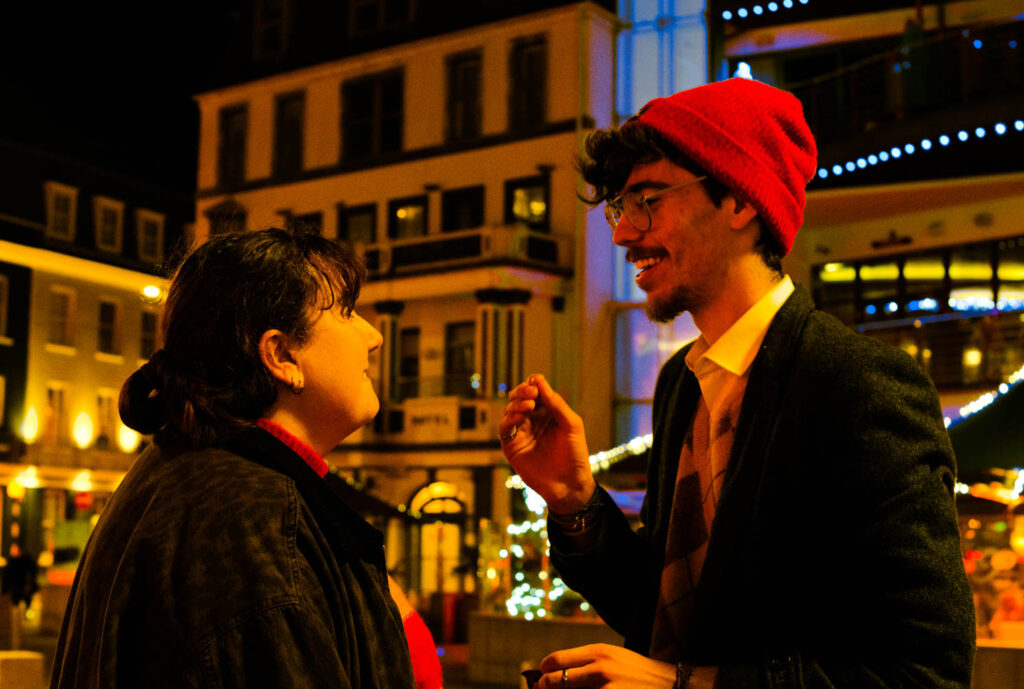
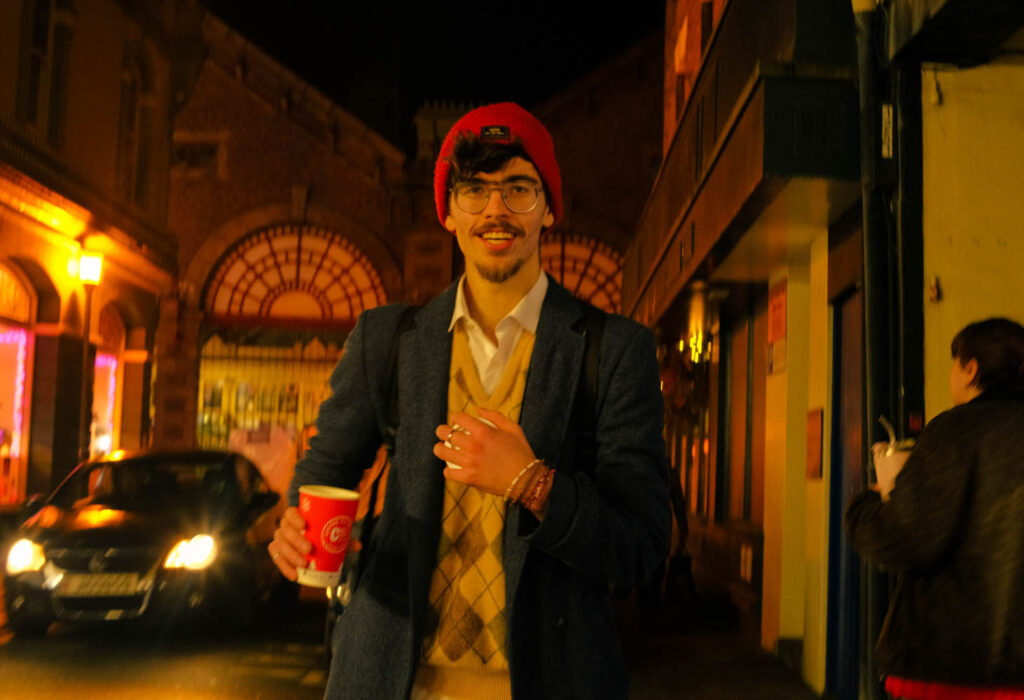
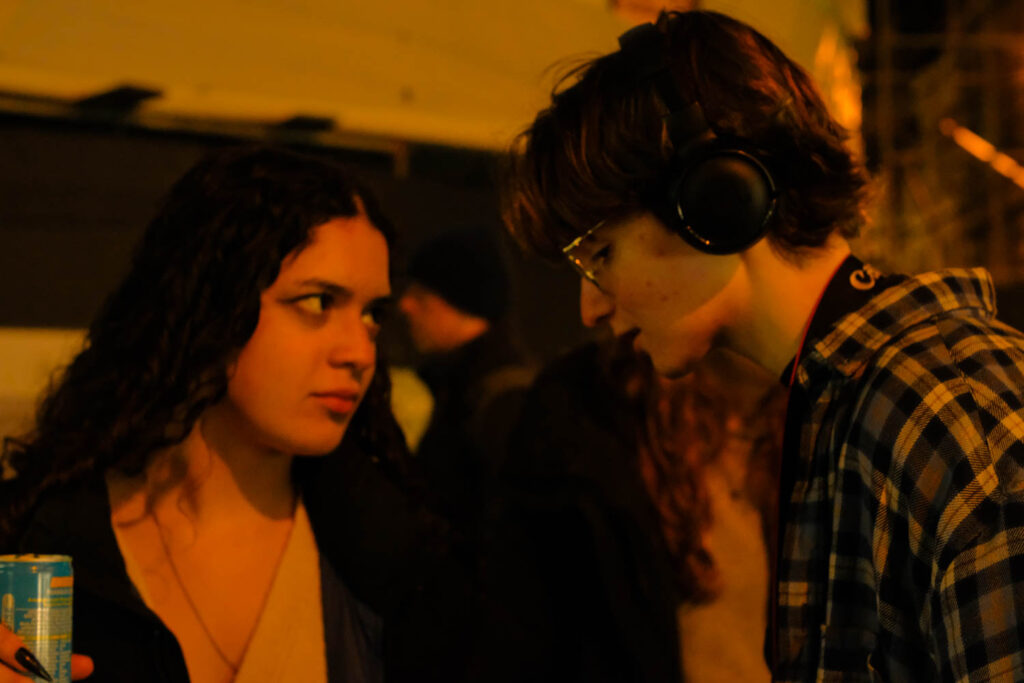
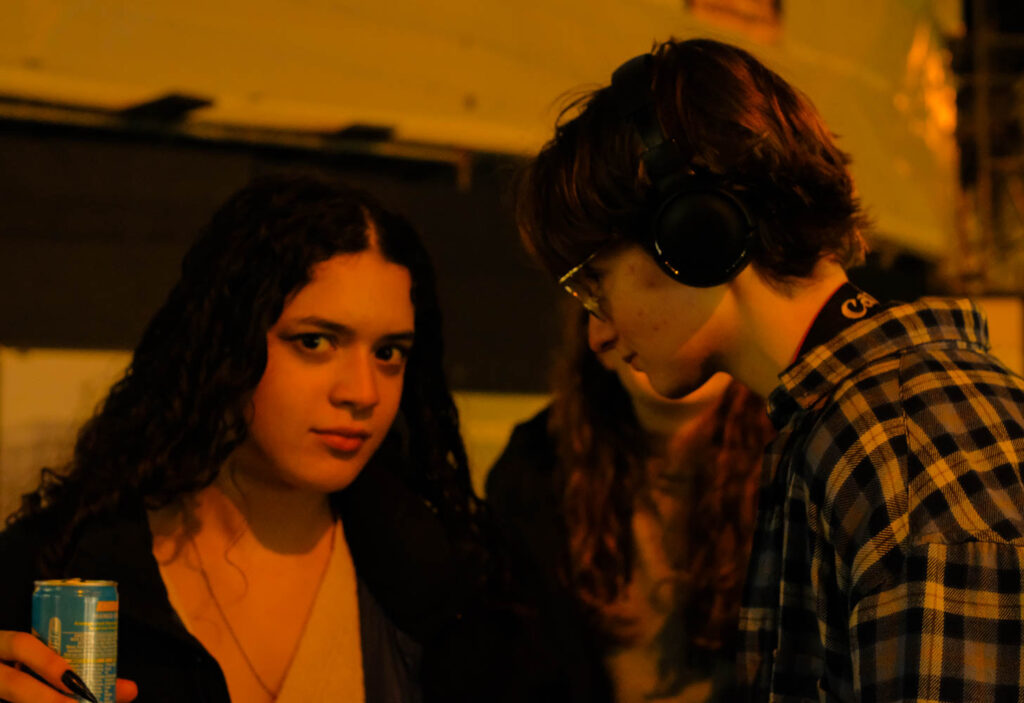
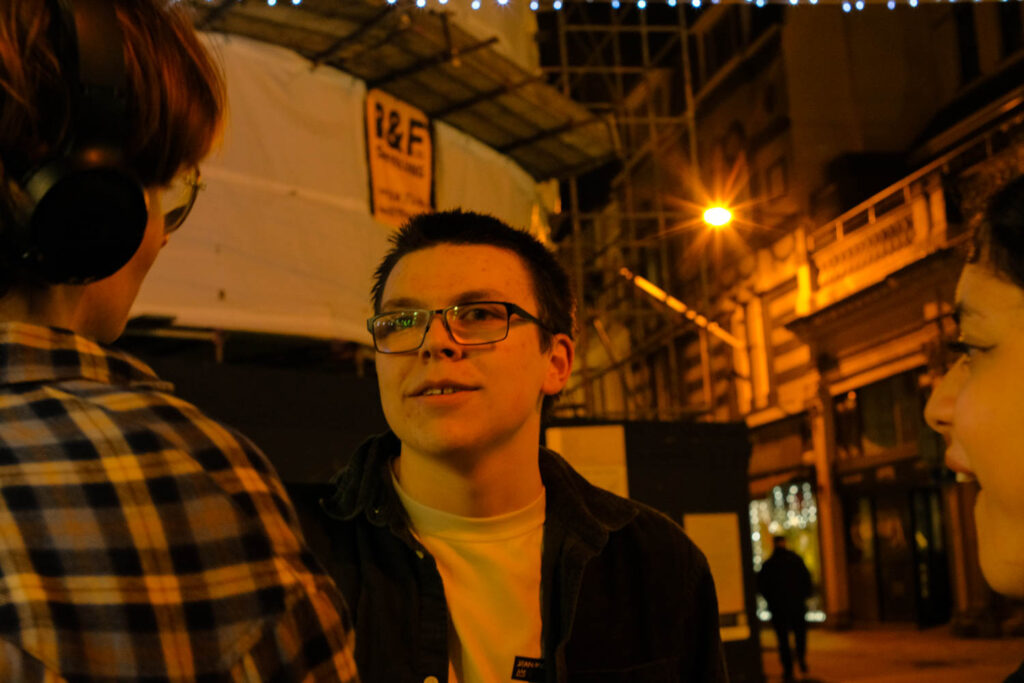

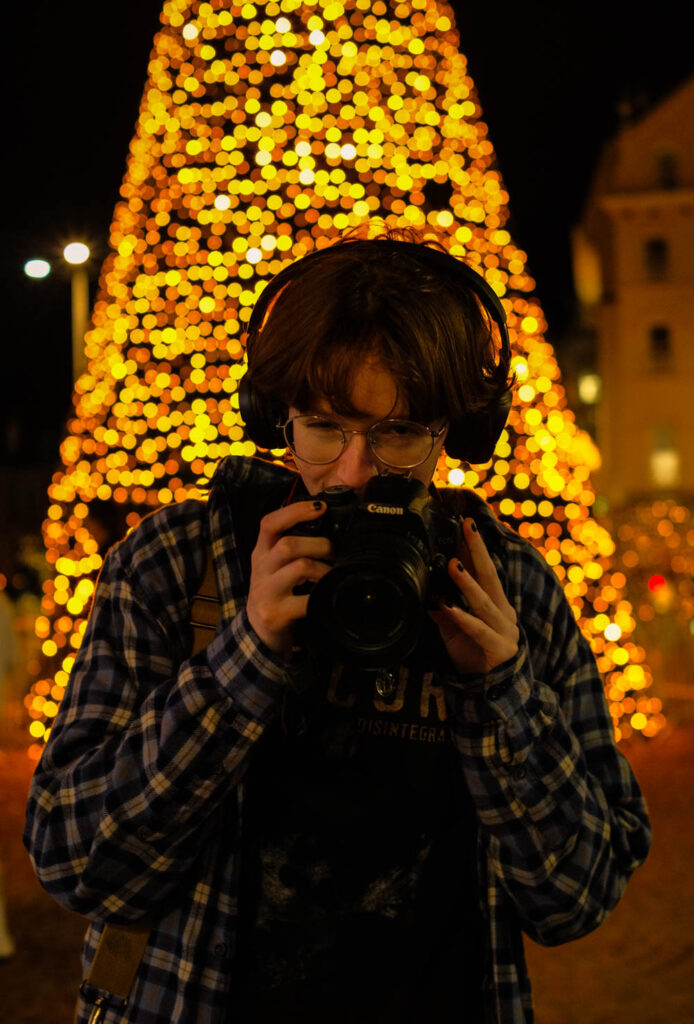
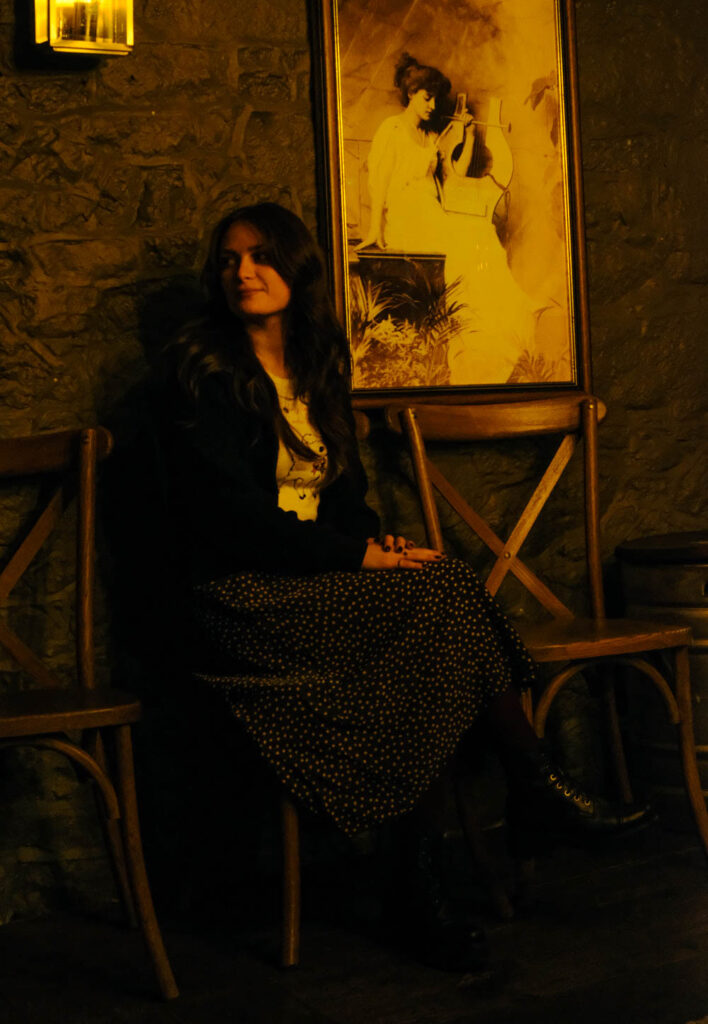
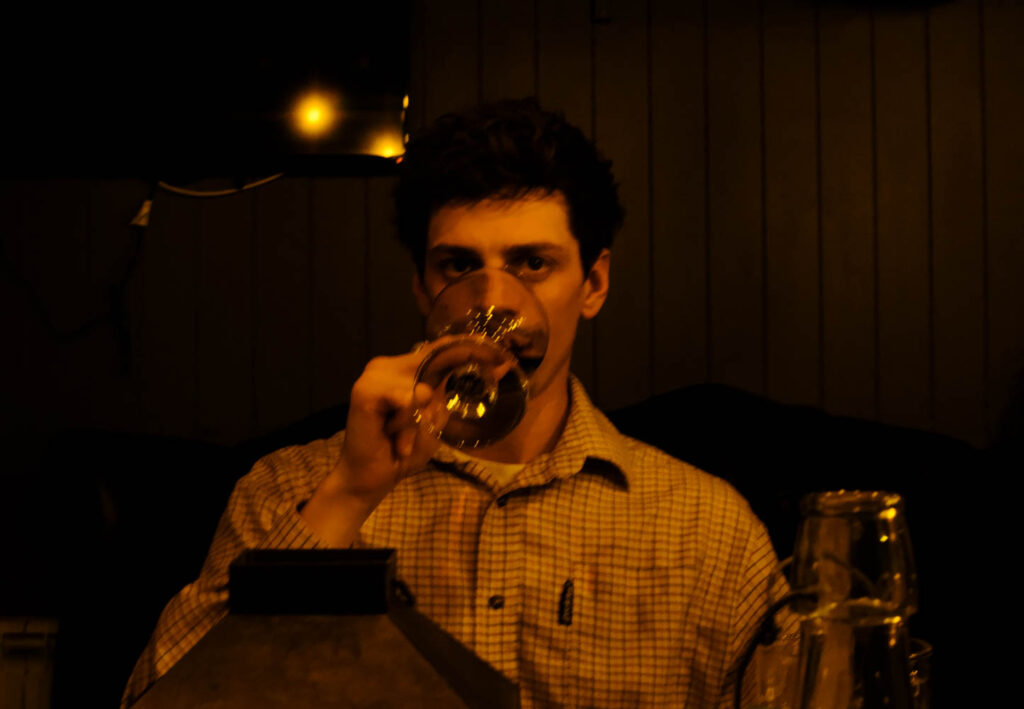
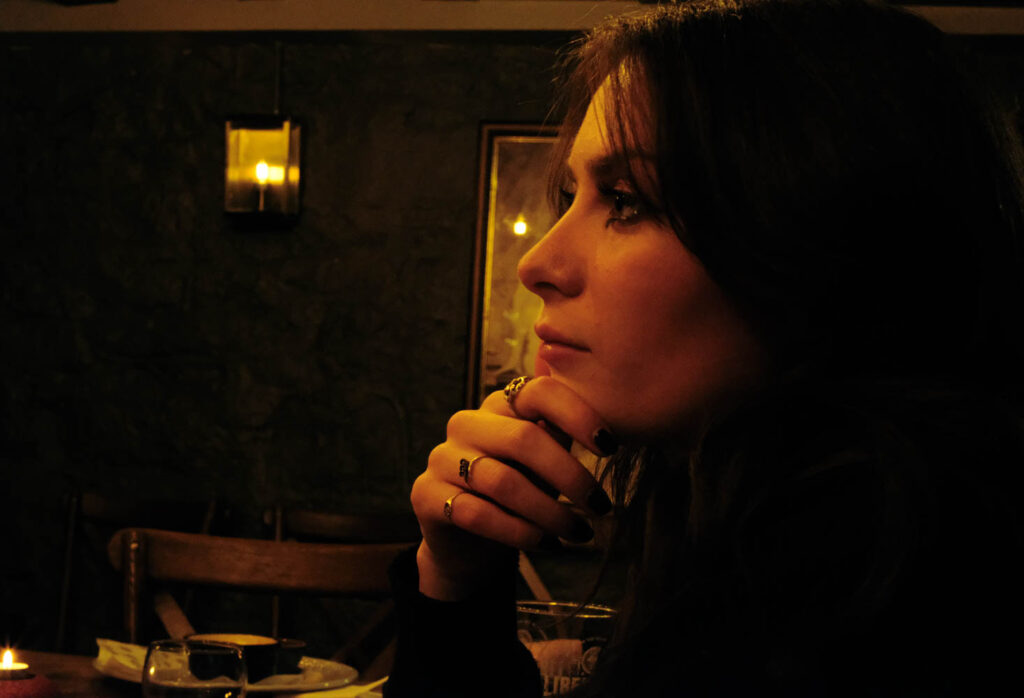
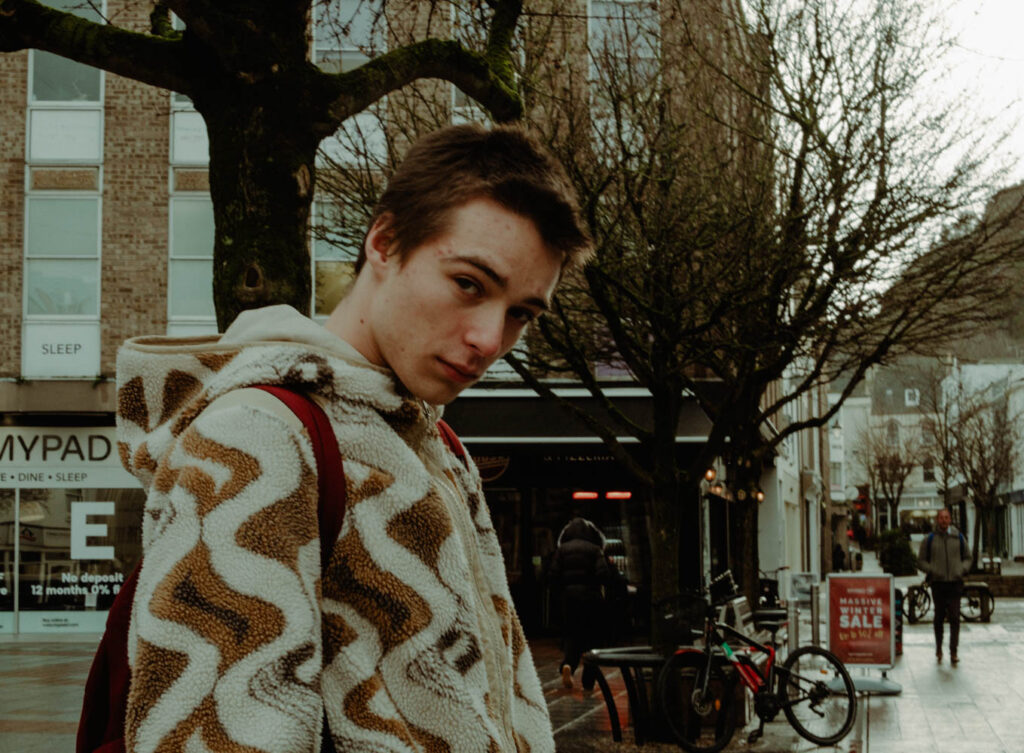
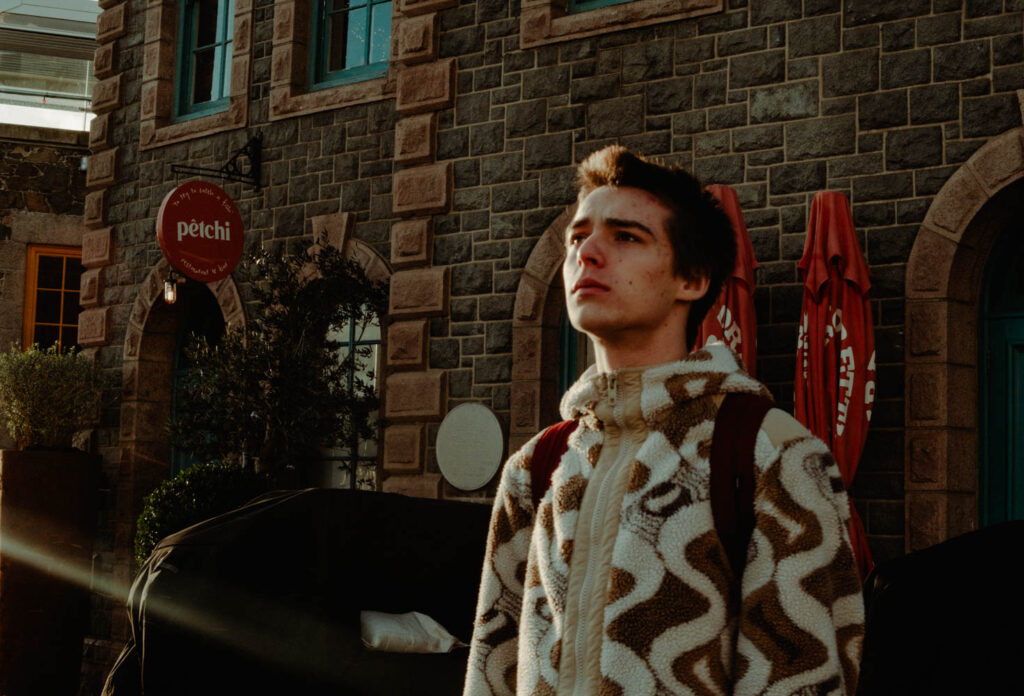
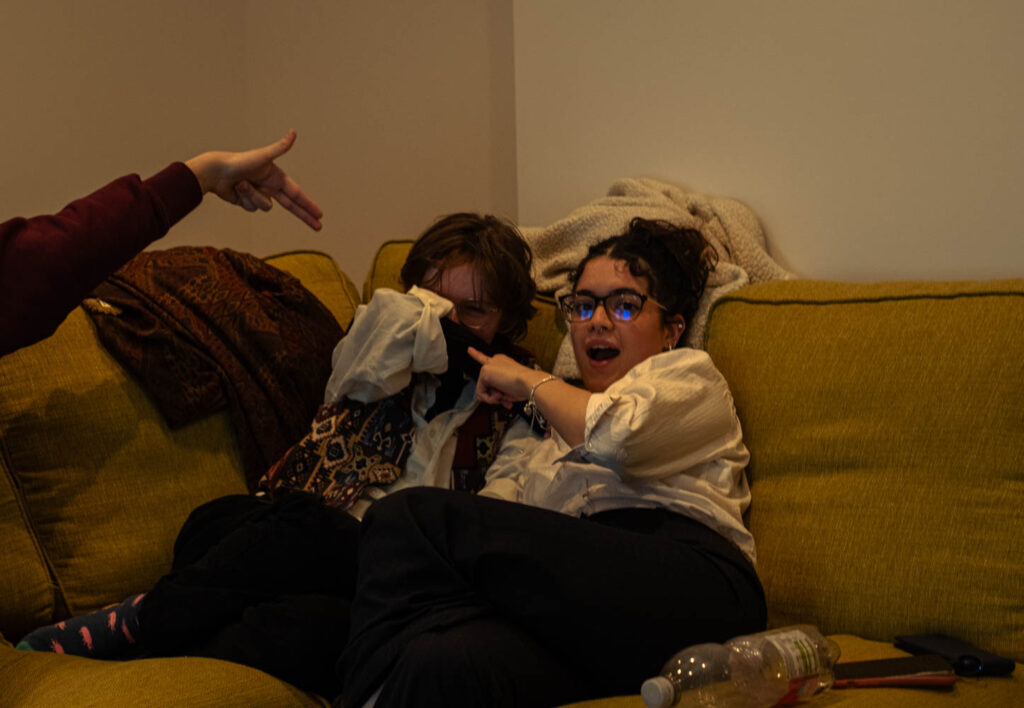
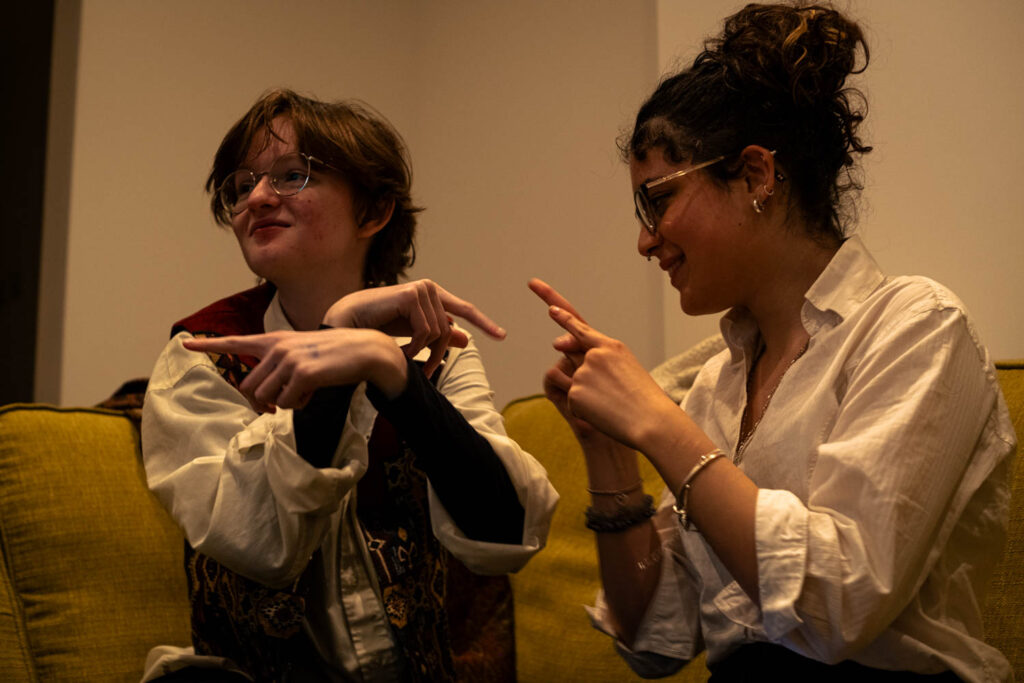
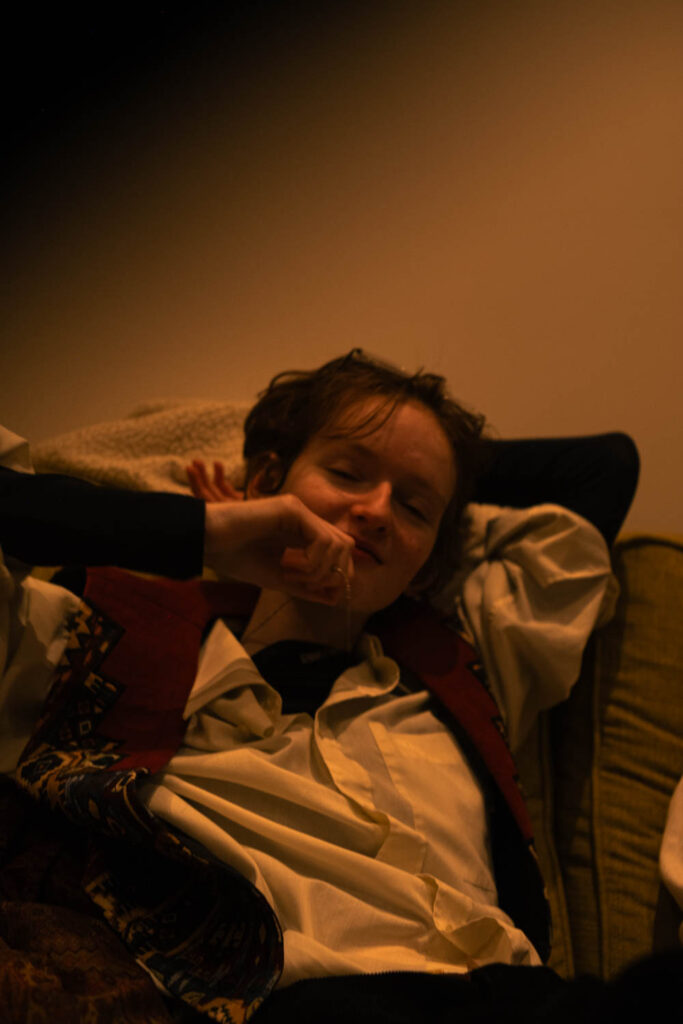
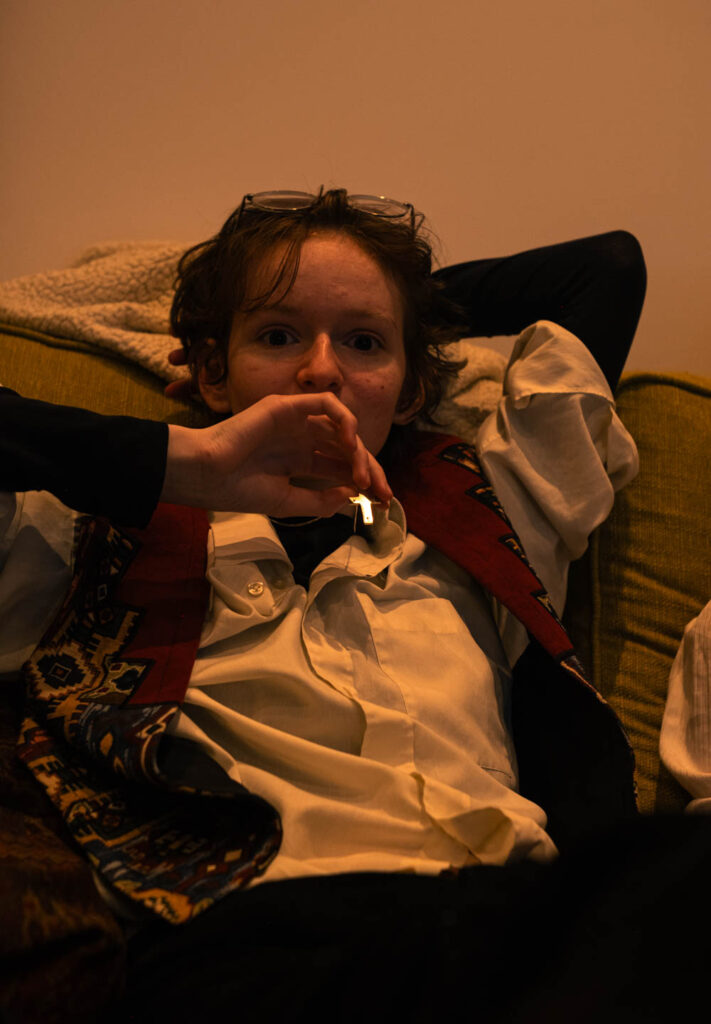
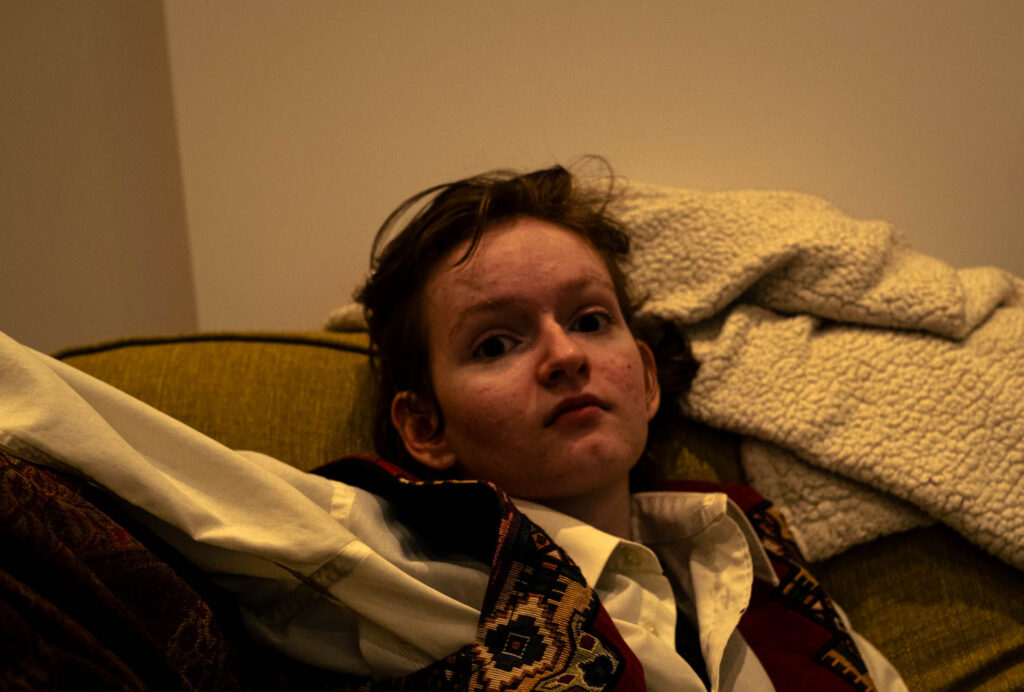
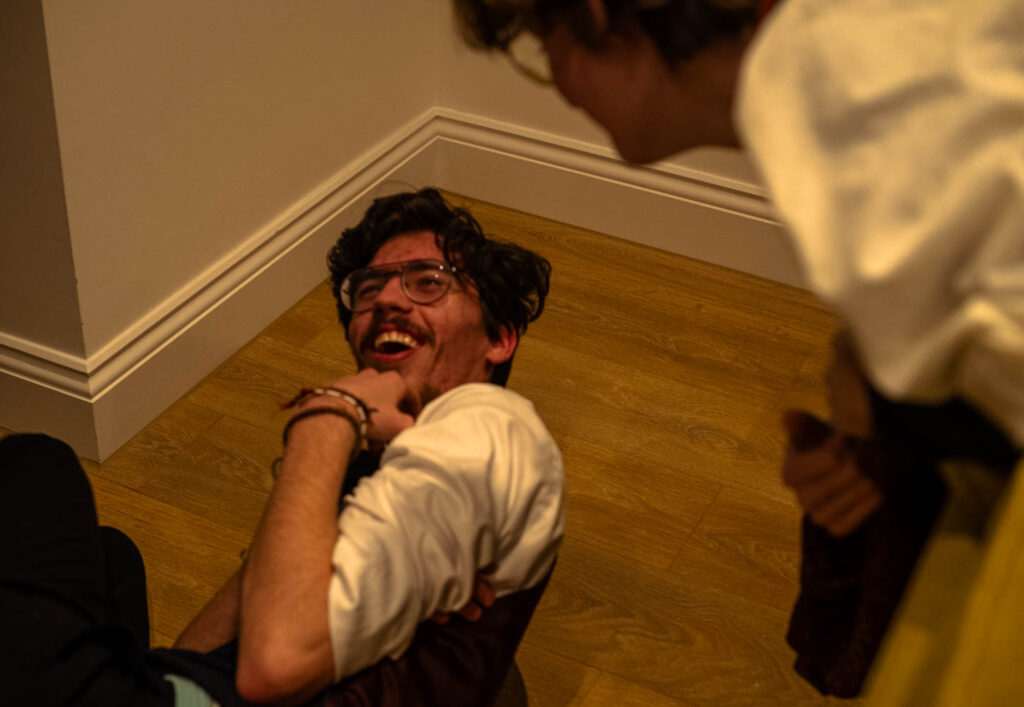
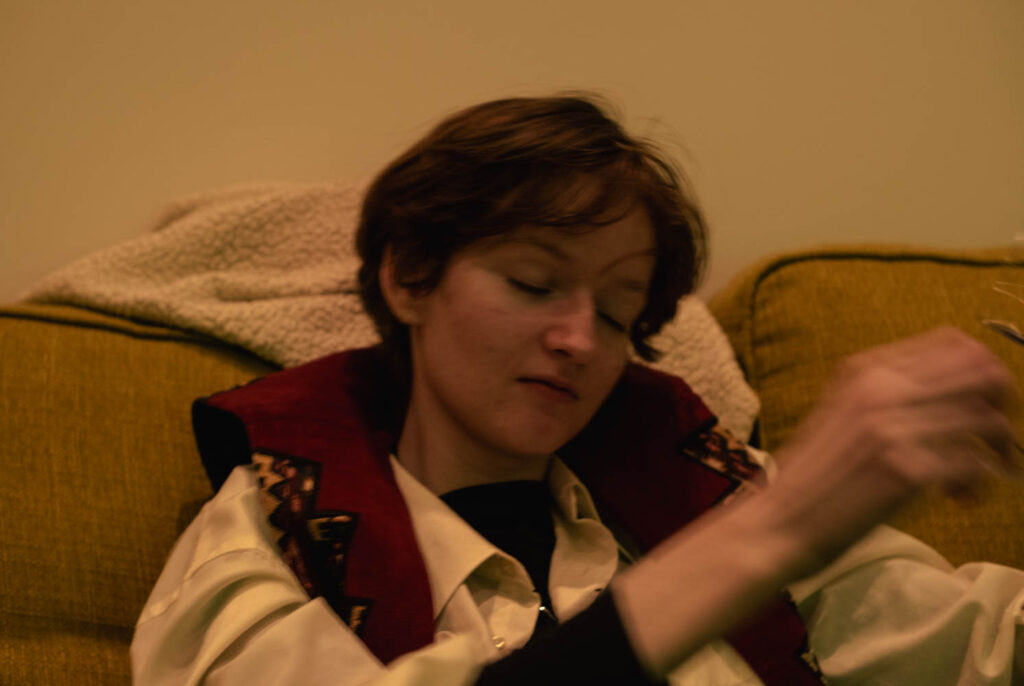
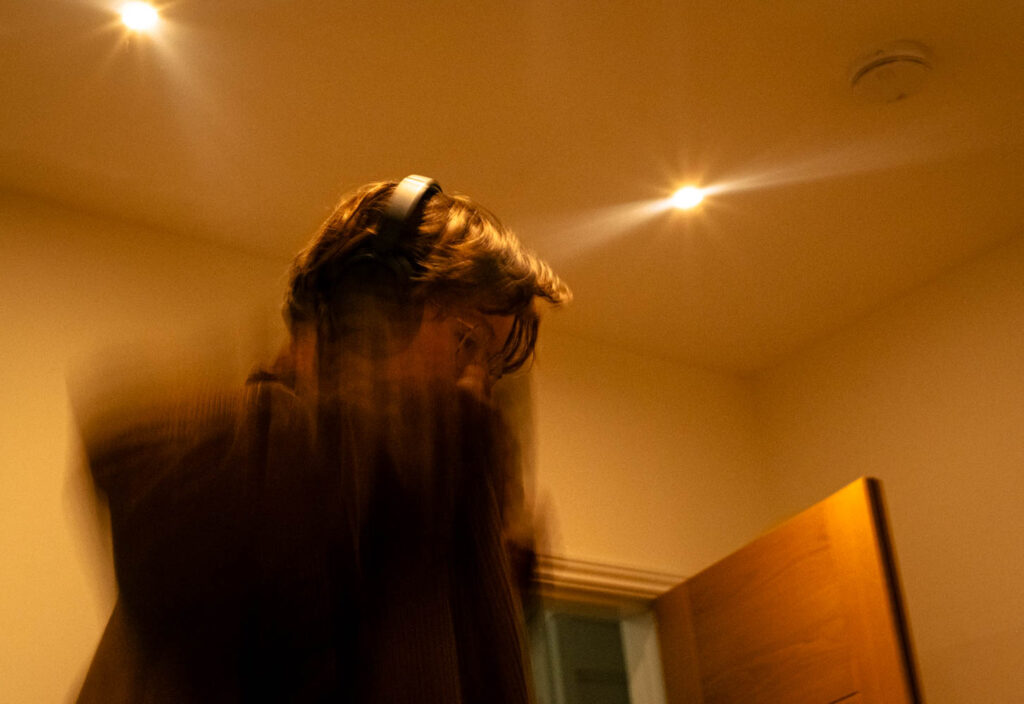




















What is a witches seat ?
Witches’ stones (in Jèrriais: pièrres dé chorchièrs) are flat stones jutting from chimneys in the islands of Jersey and Guernsey.[1]
According to folklore in the Channel Islands, these small ledges were used by witches to rest on as they fly to their sabbats. Householders would provide these platforms to appease witches and avoid their ill favour.
Traditional vernacular architecture in Jersey is in granite and such witches’ stones can be seen protruding from many older houses. The real origin of this architectural feature is to protect thatched roofs from seeping water running down the sides of the chimney stack. Thatched roofs being thicker than tiled roofs, the jutting stones would sit snugly on the thatch – as can be seen on the few remaining thatched roofs in Jersey. When thatch began to be generally replaced by pantiles in the 18th century, and later by slates, the witches’ stones were left protruding prominently from the chimney stack. This either gave rise to the belief in witches’ resting places, or reinforced an existing belief. Fear of witches was widespread in country areas well into the 20th century in Jersey.

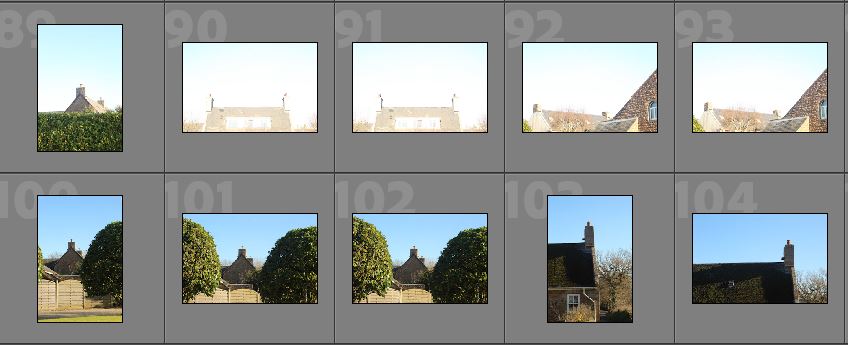
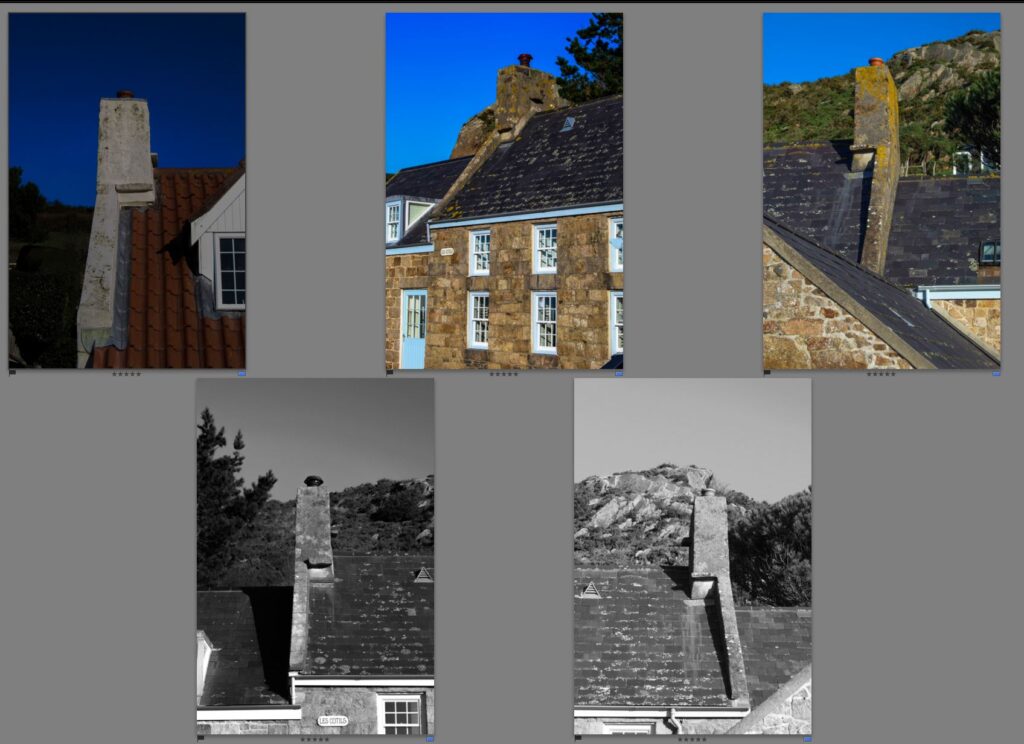


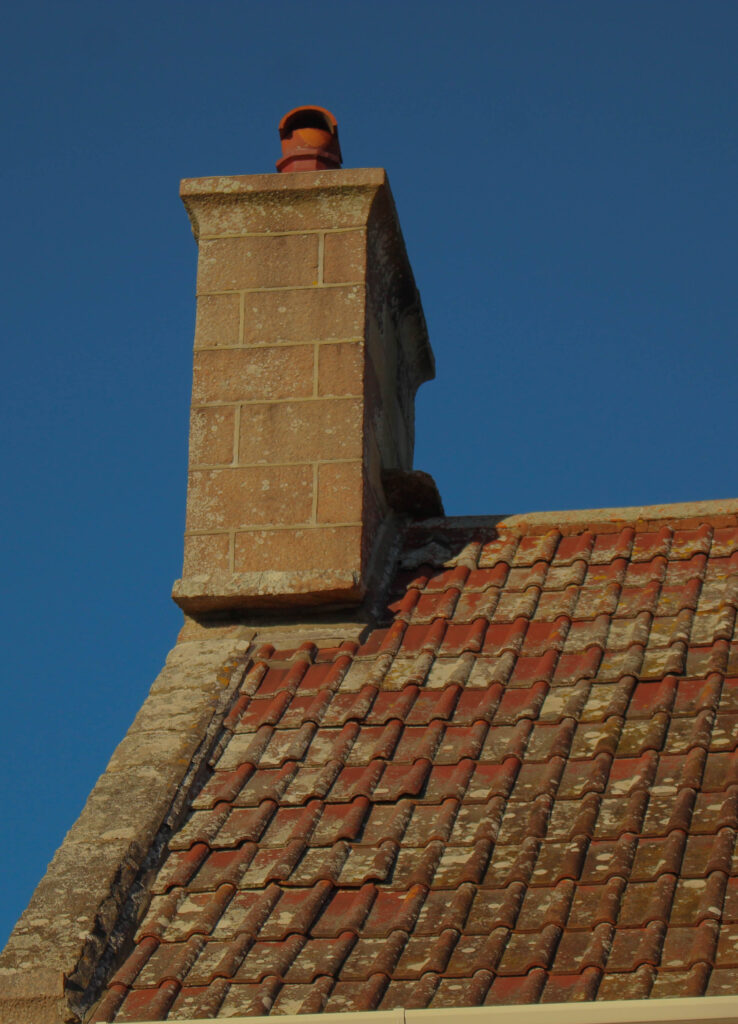
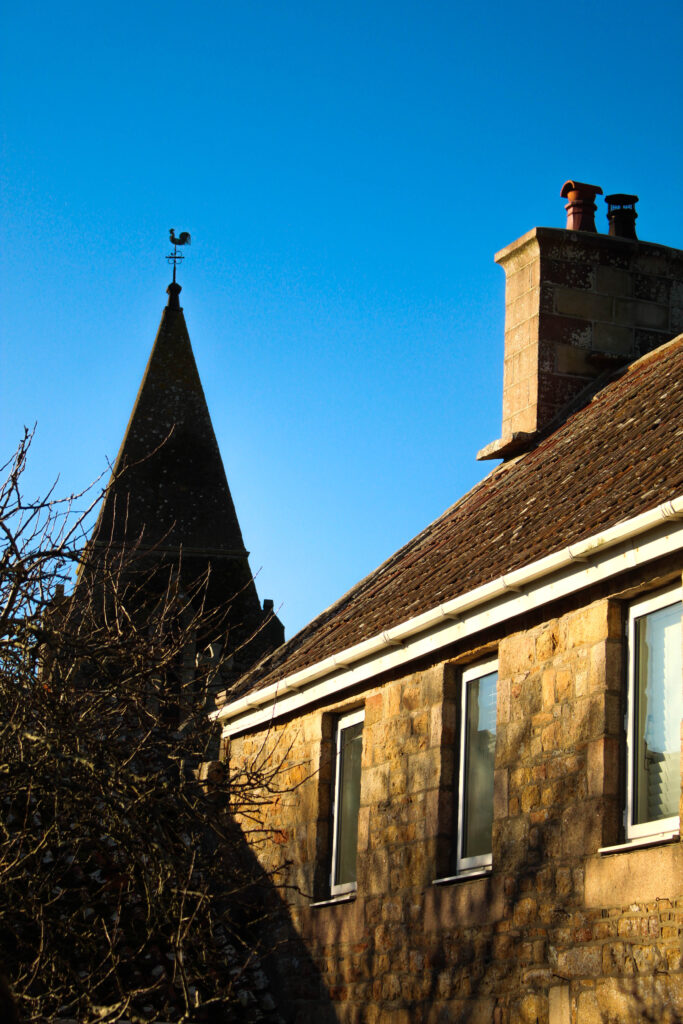
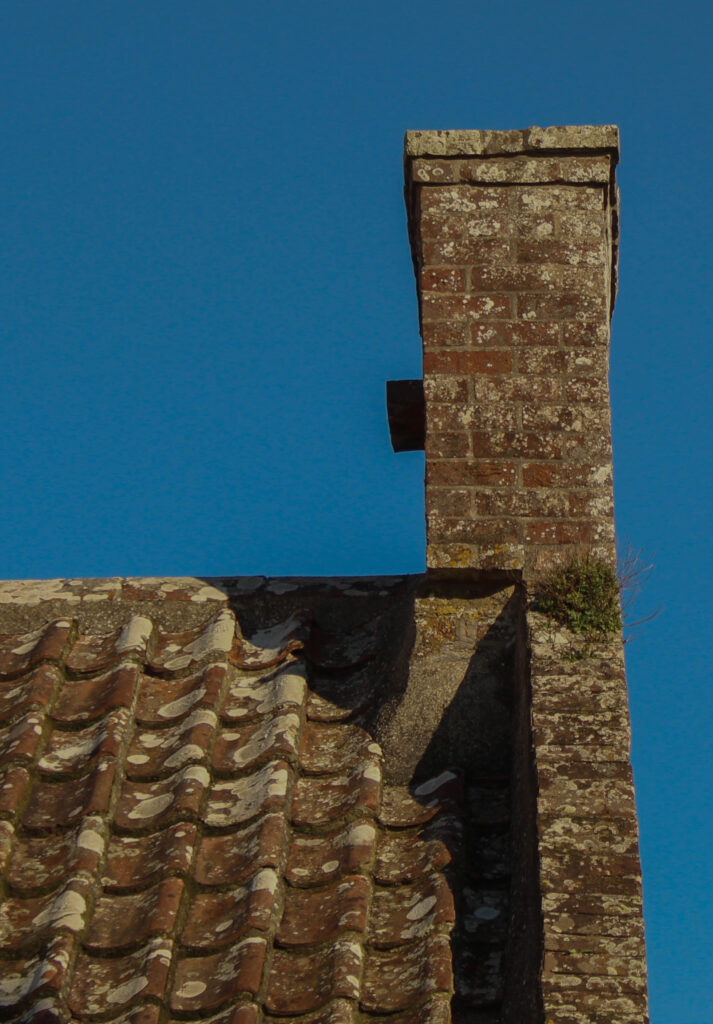
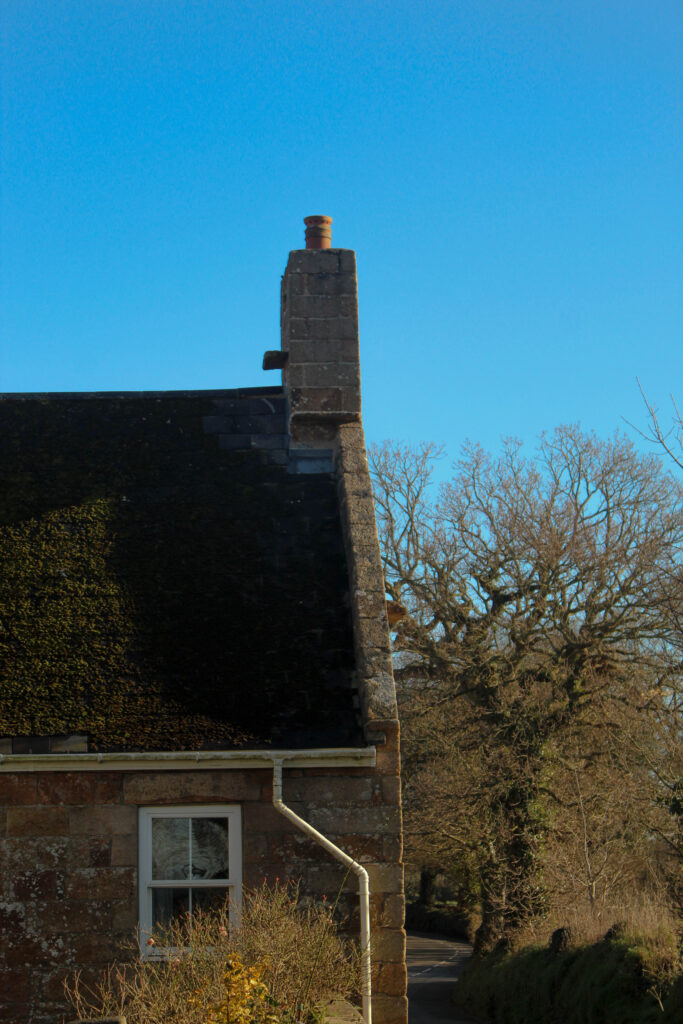
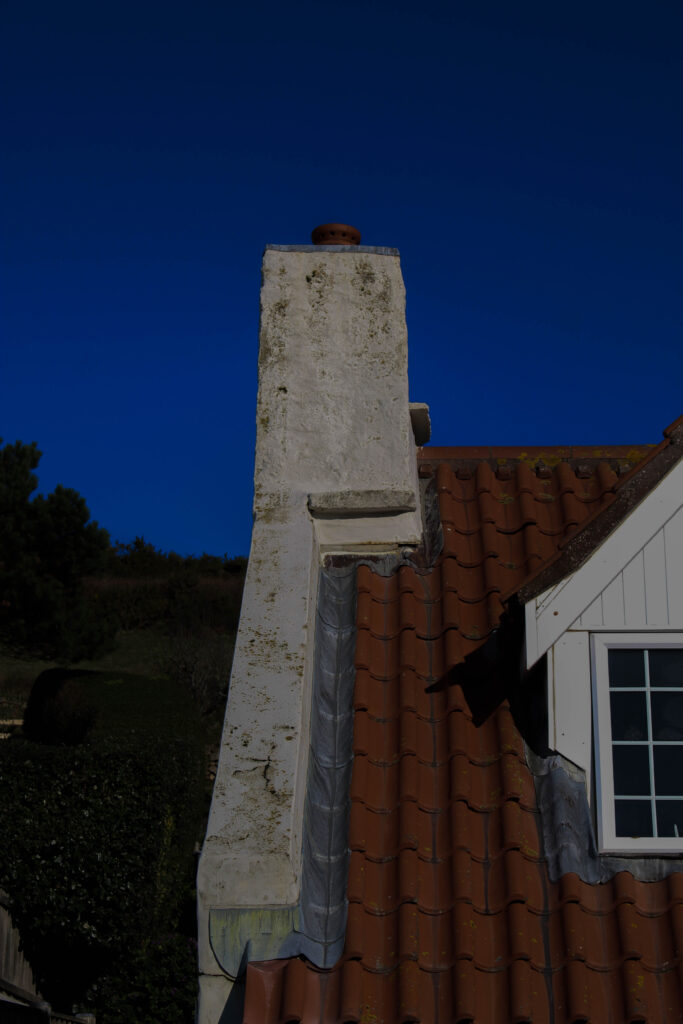
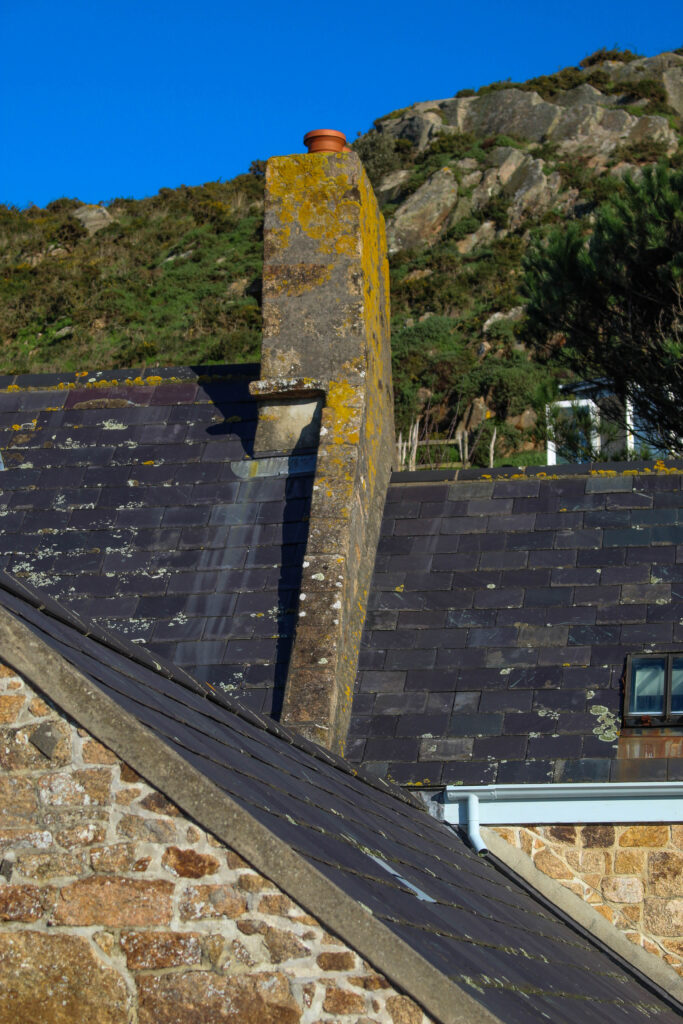
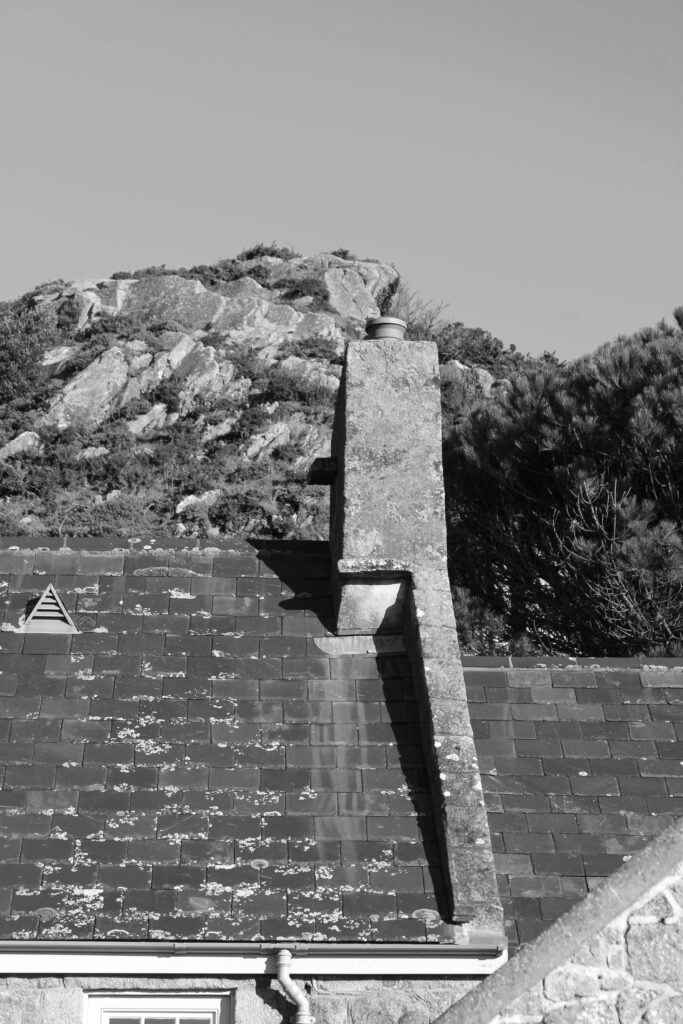
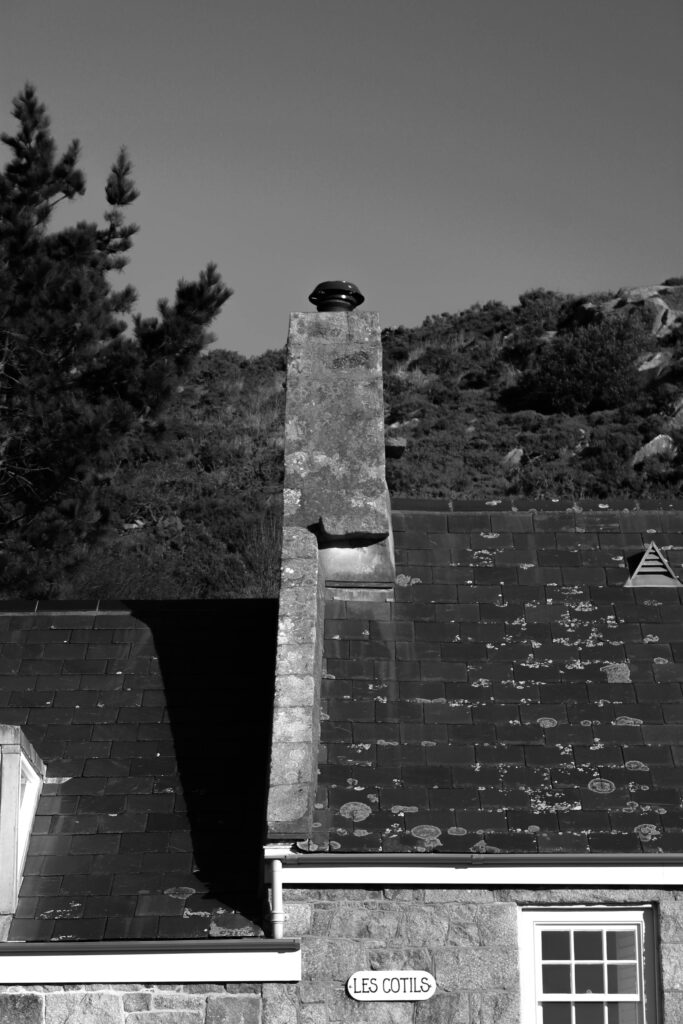
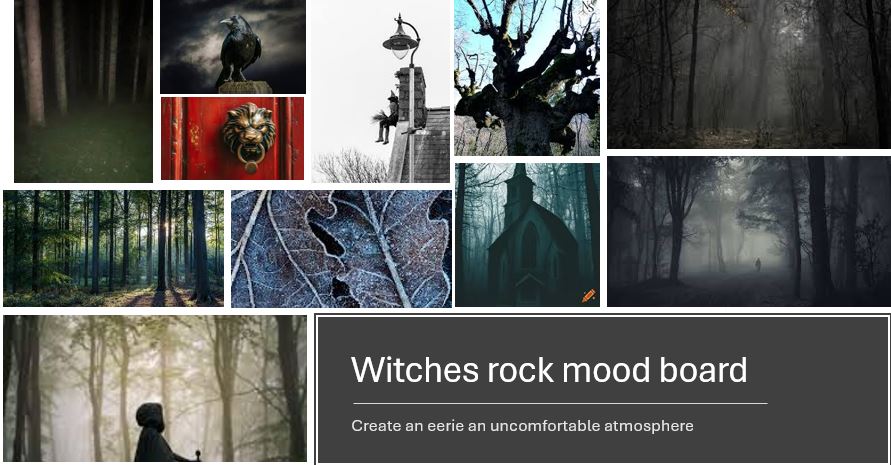
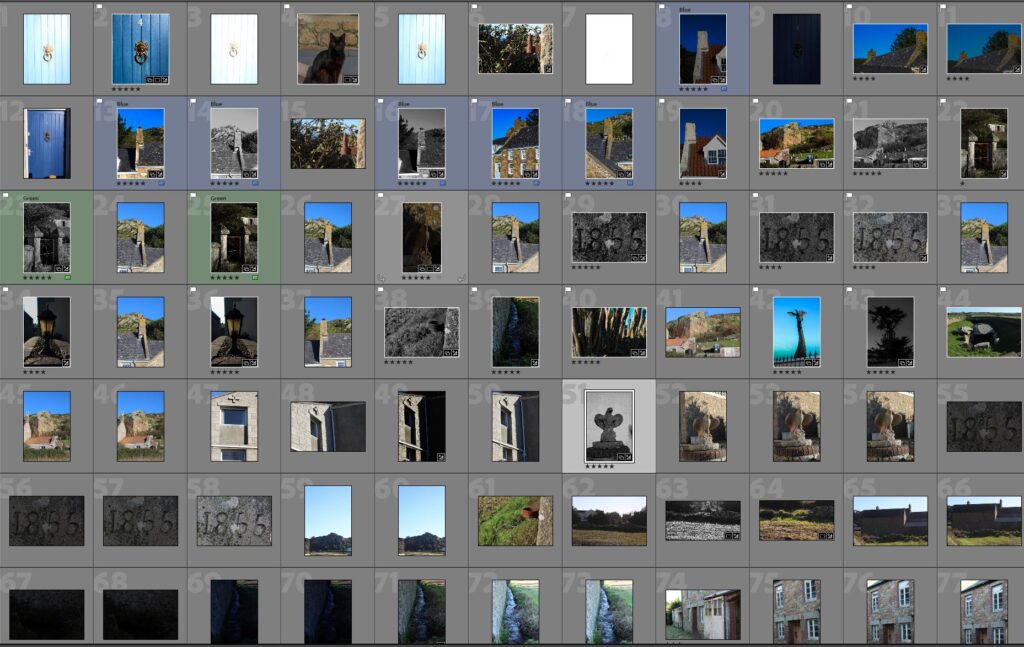
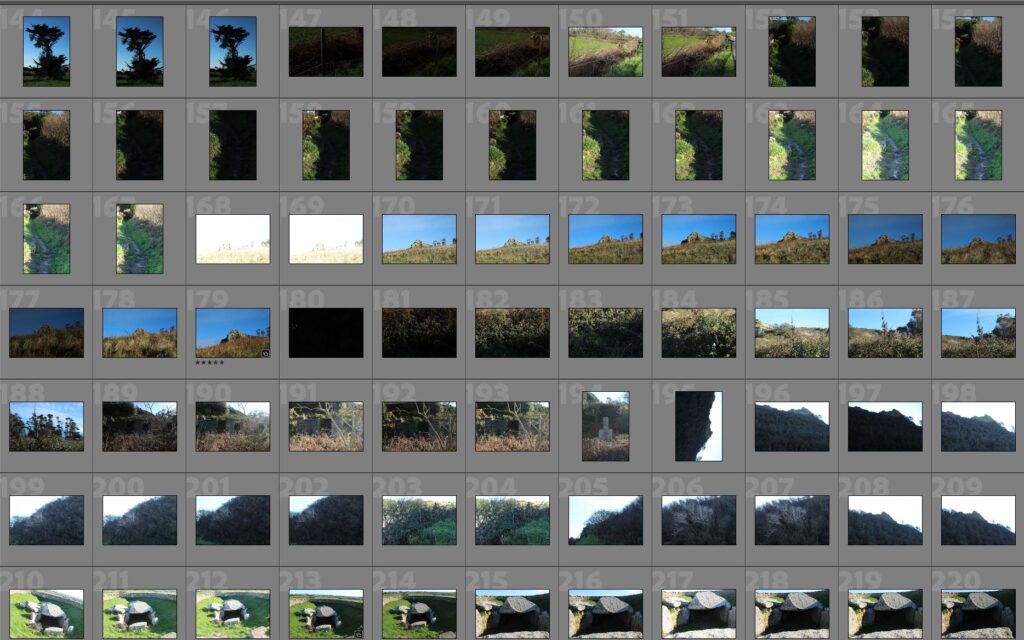
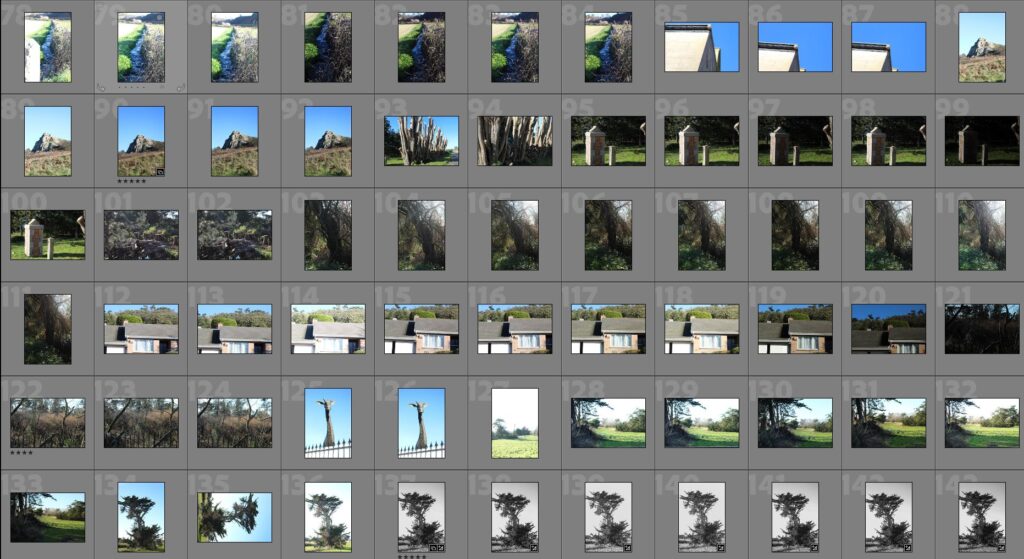
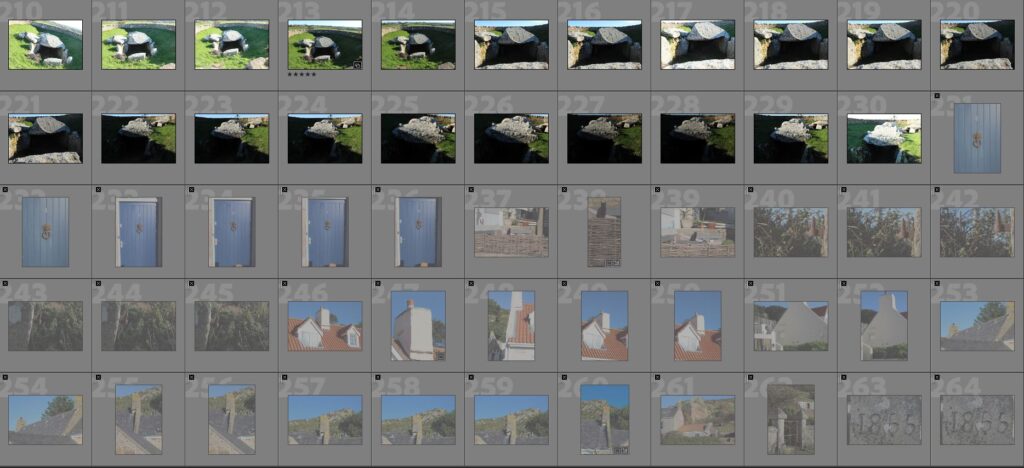

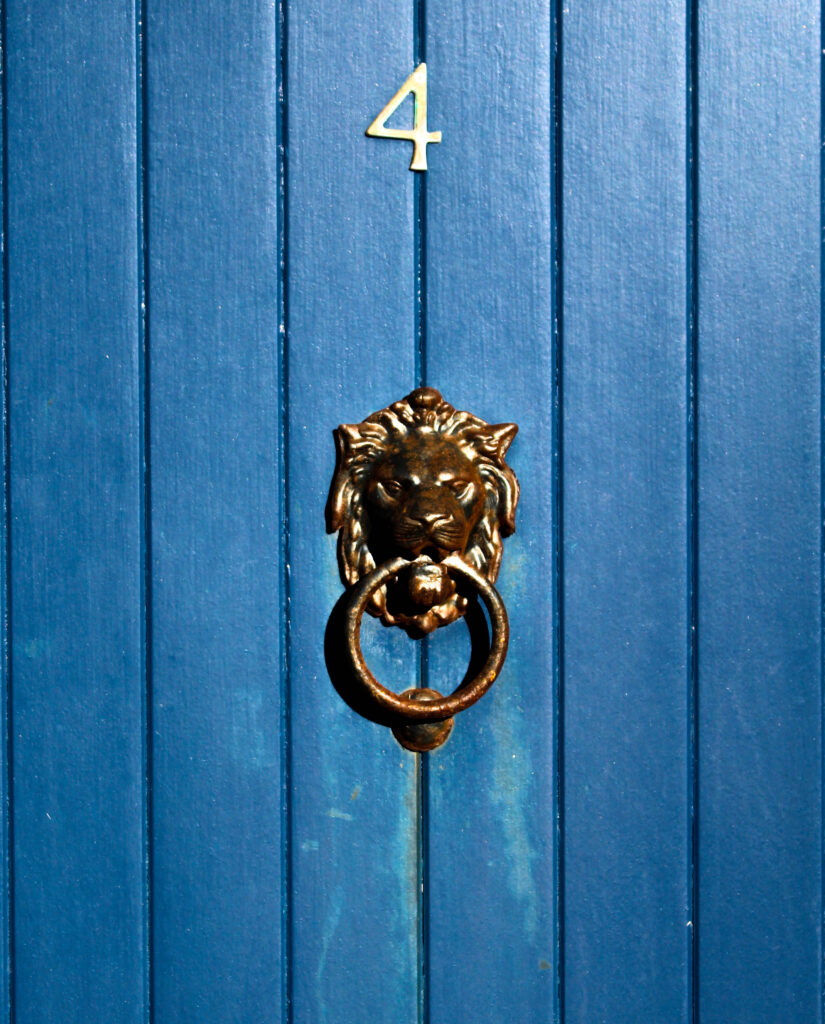
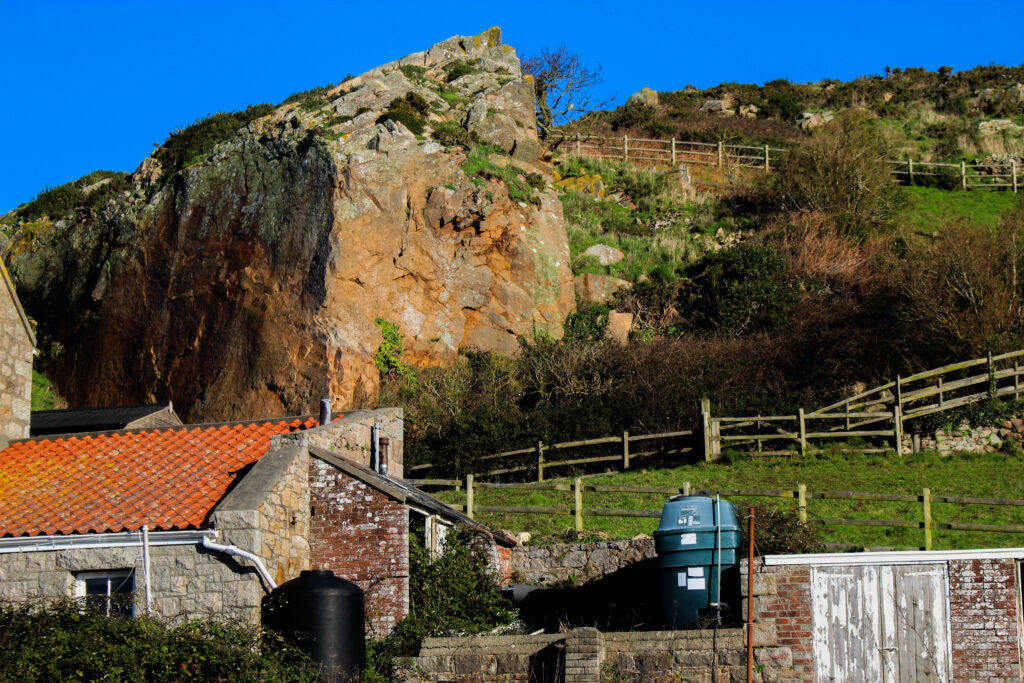
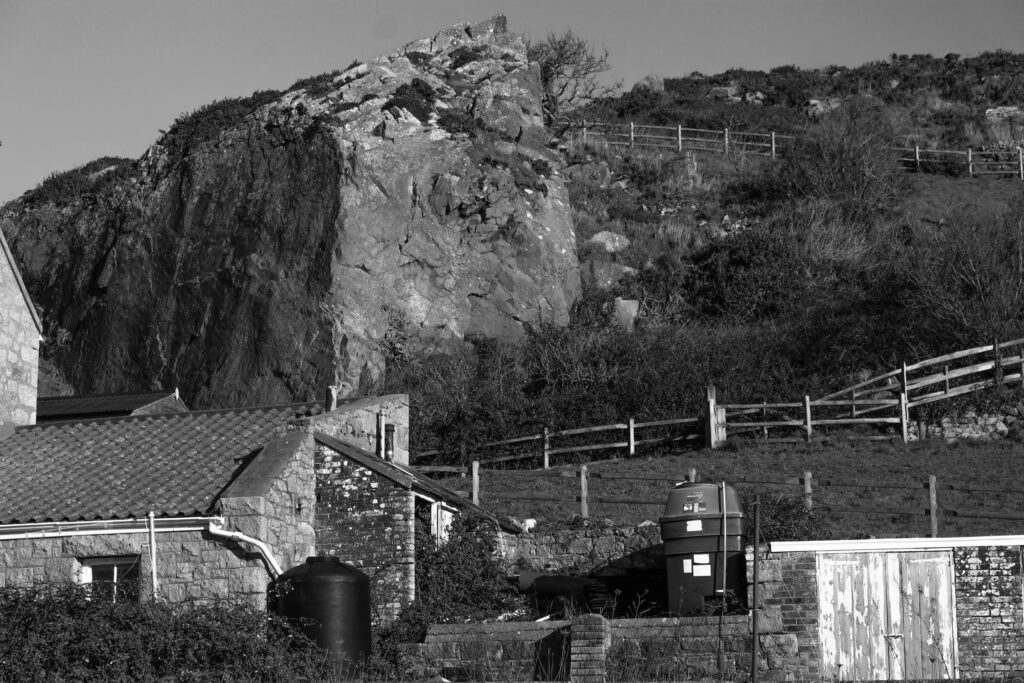
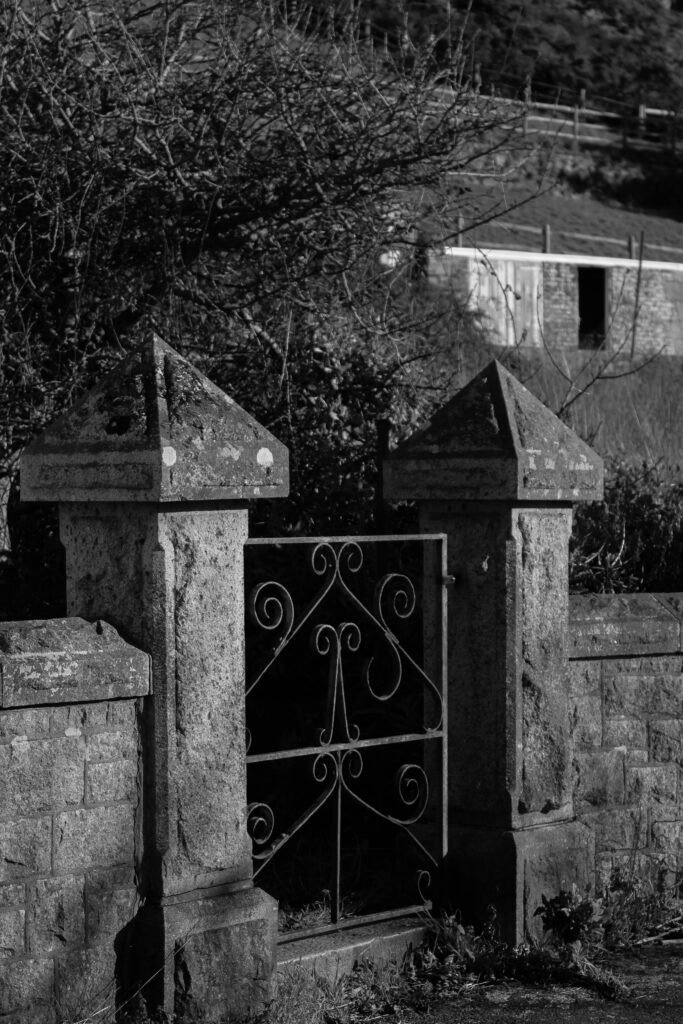
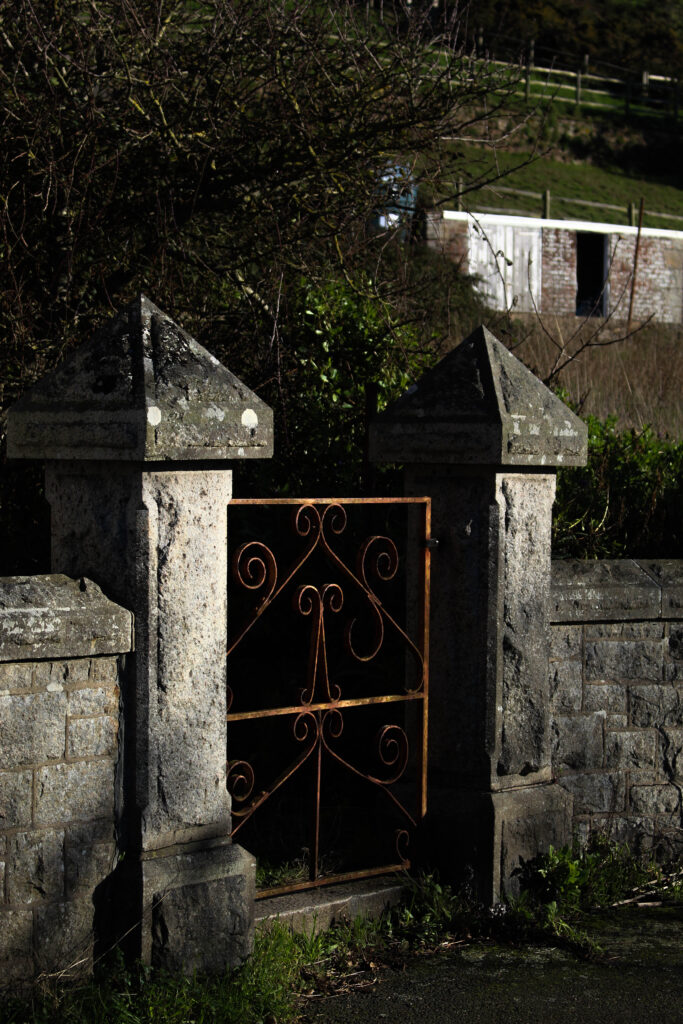

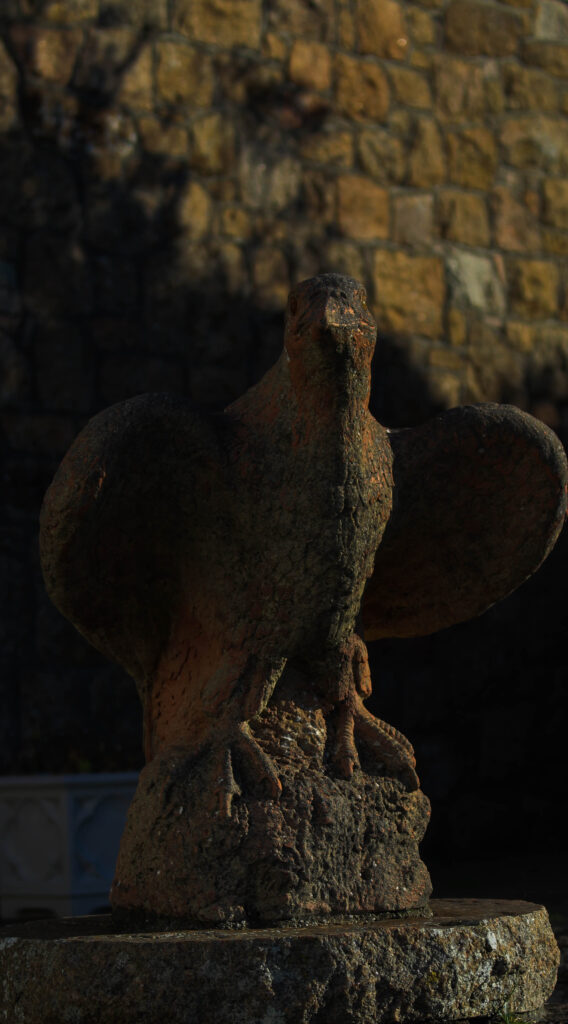
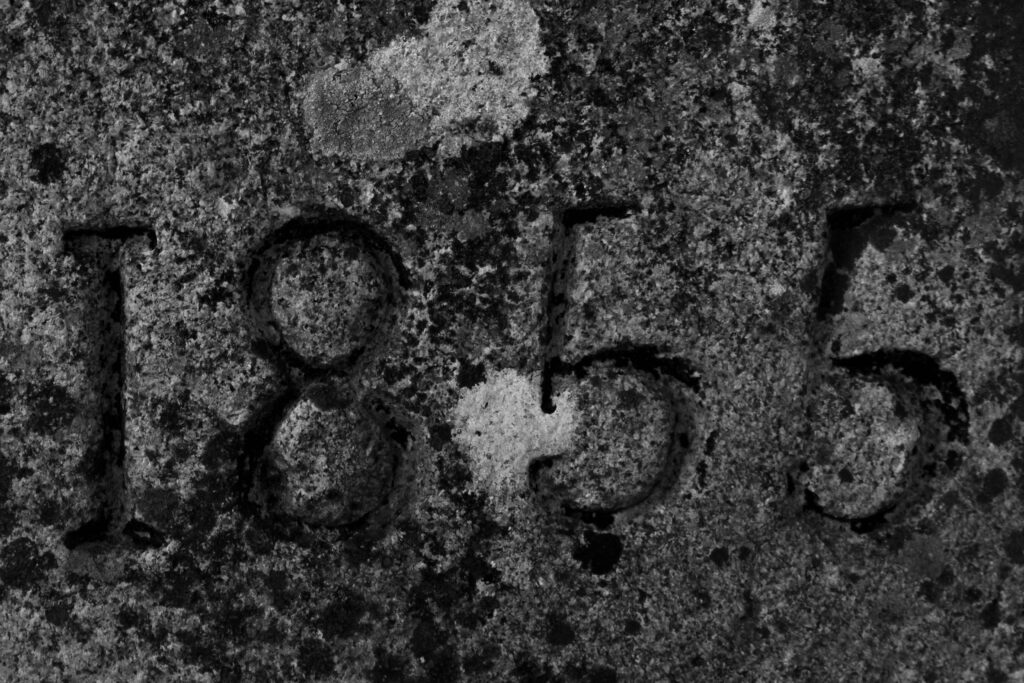
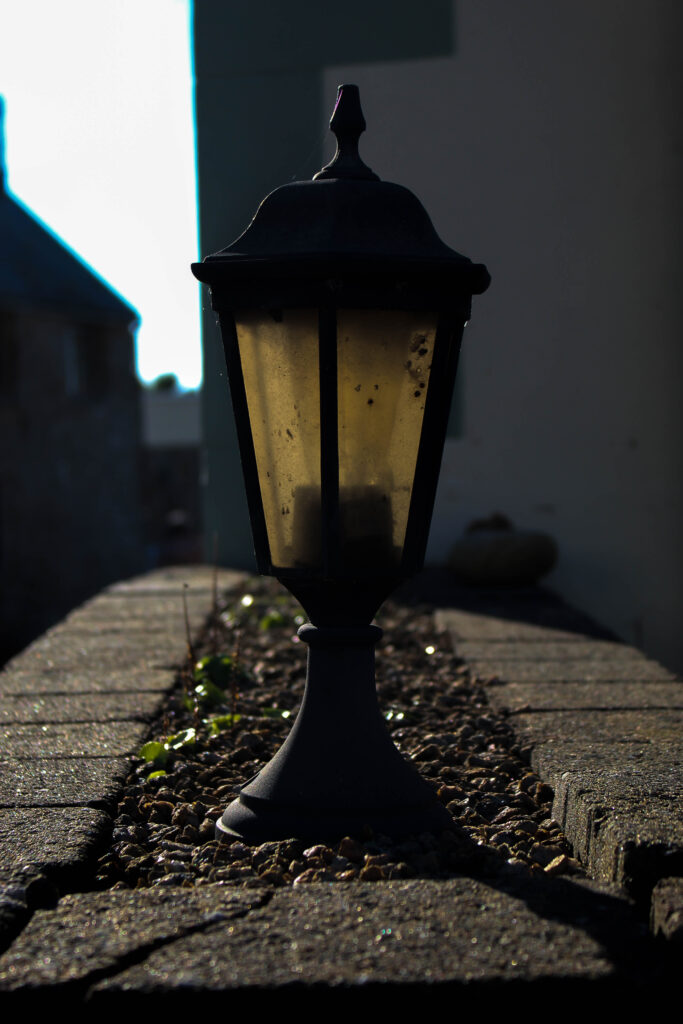
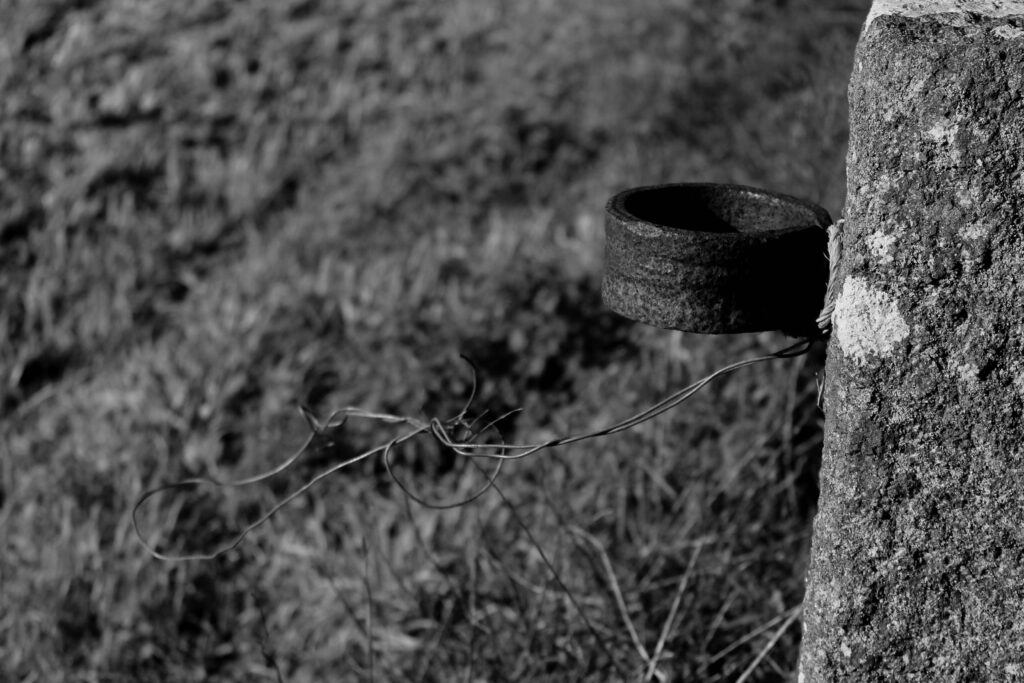
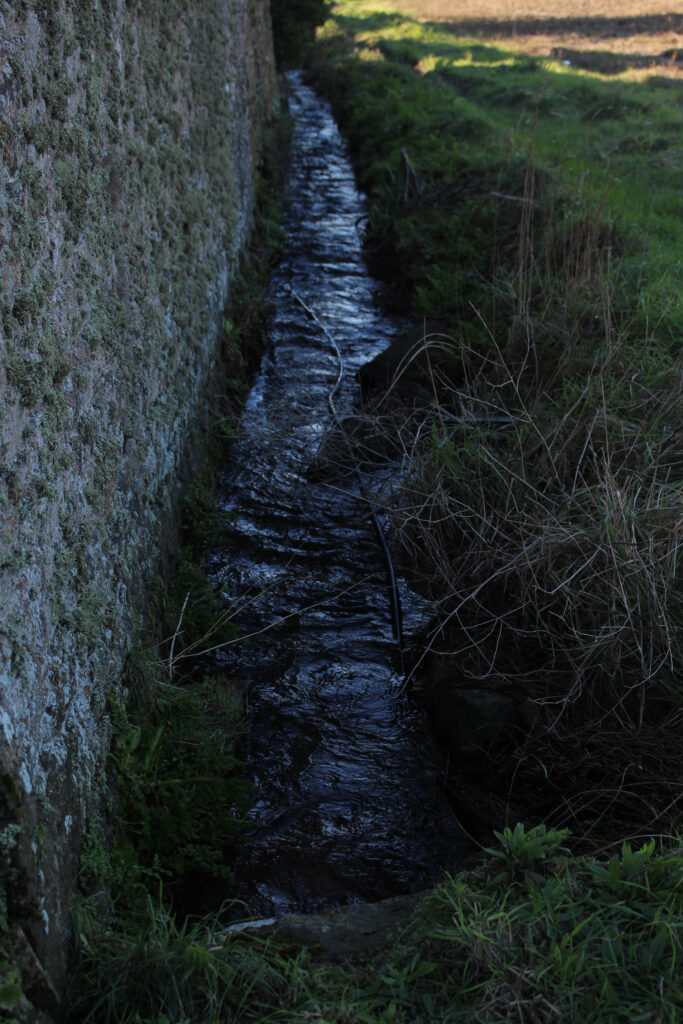
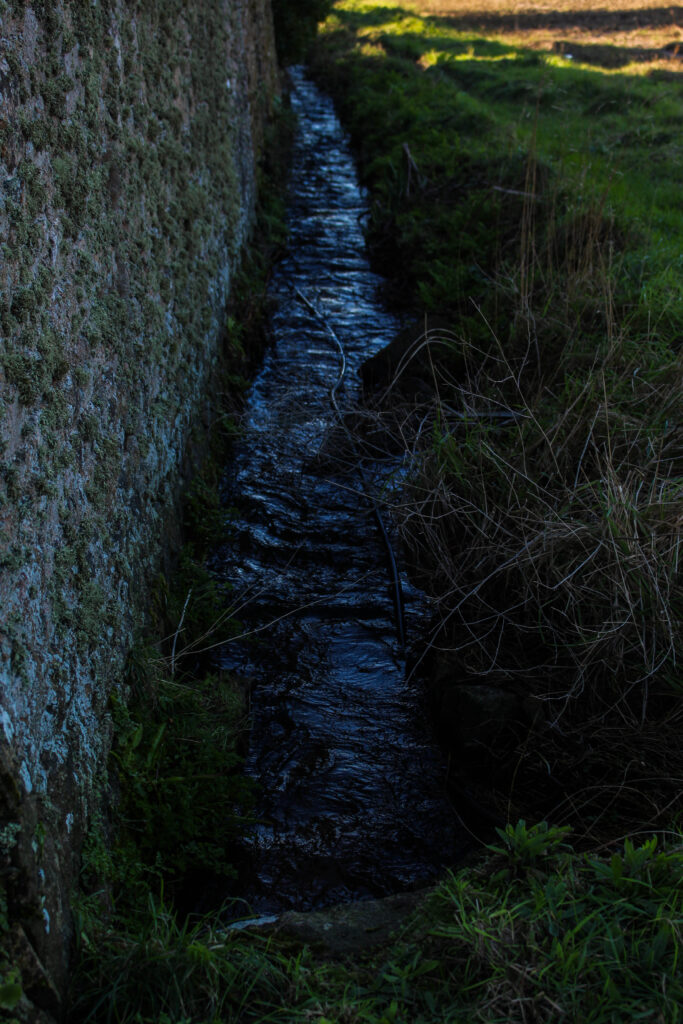
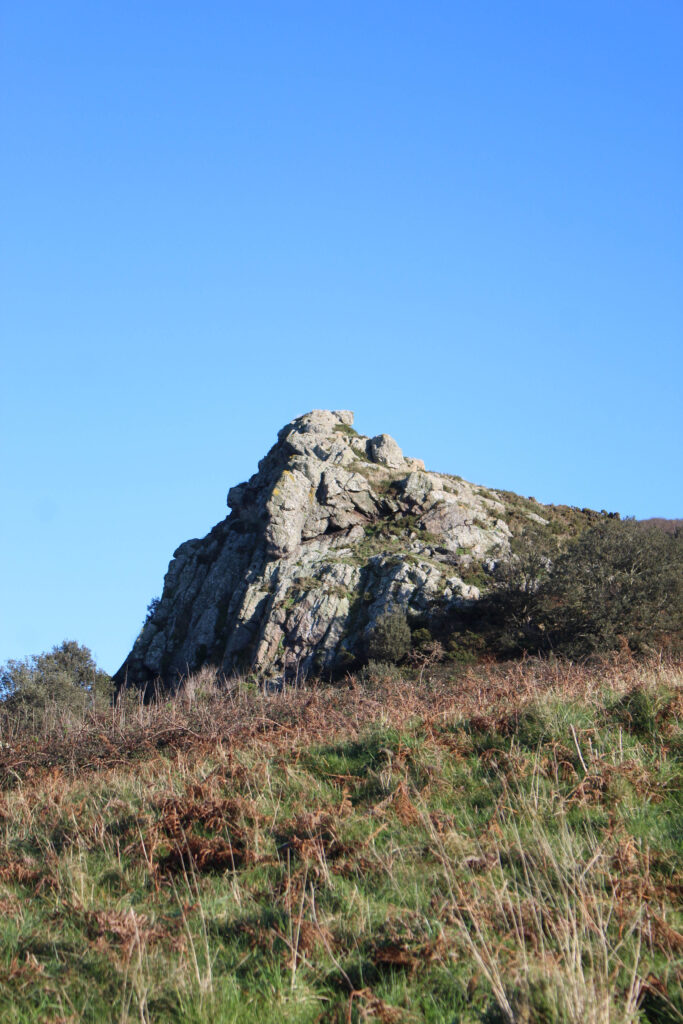
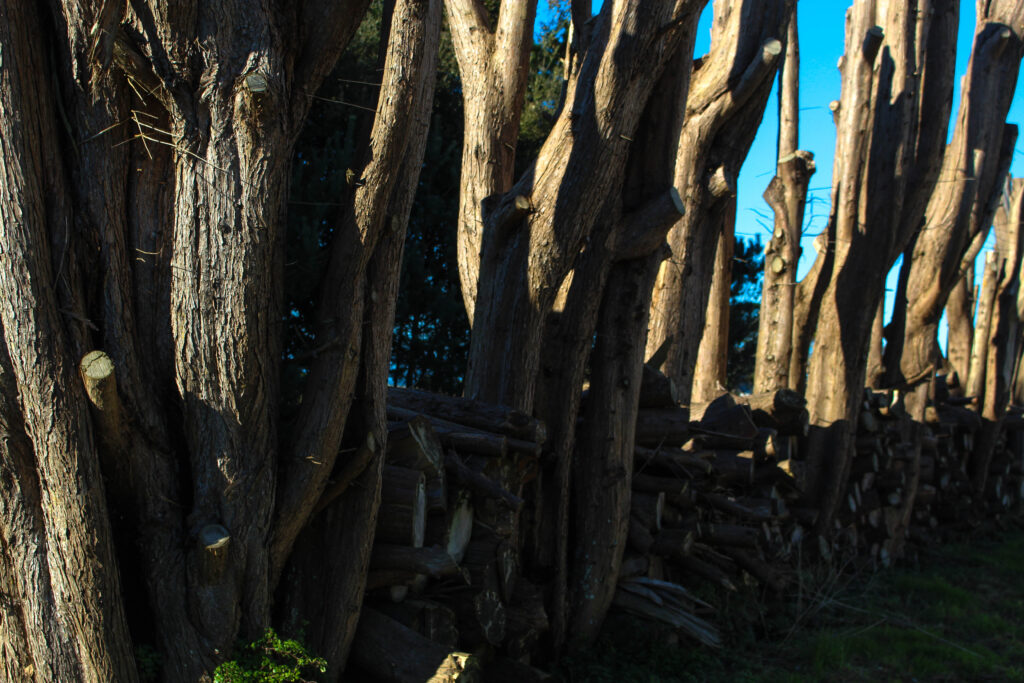
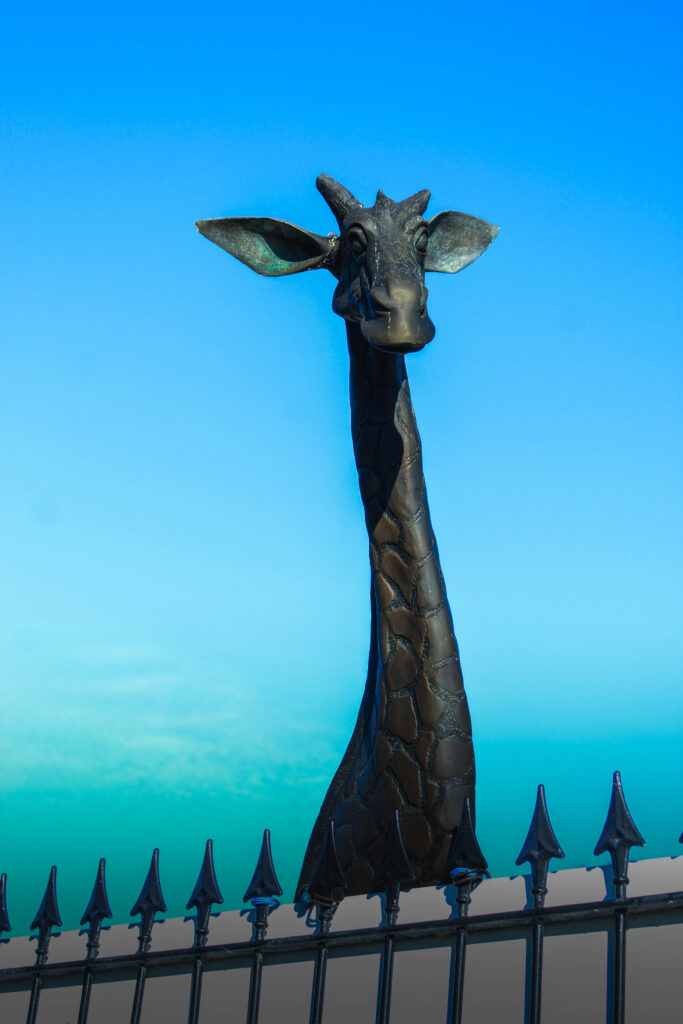
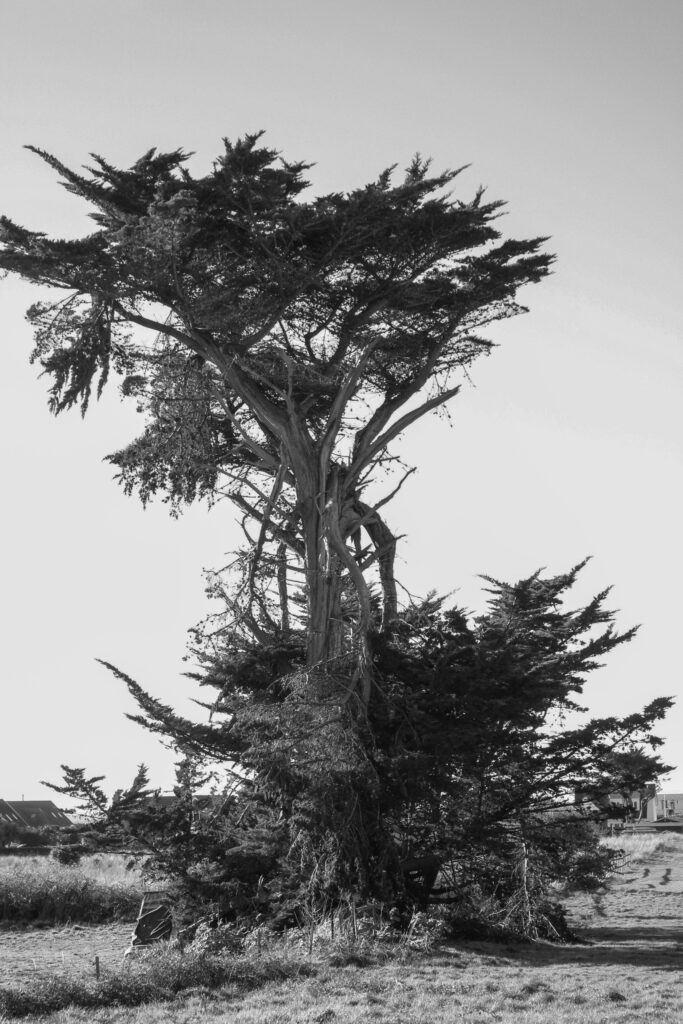
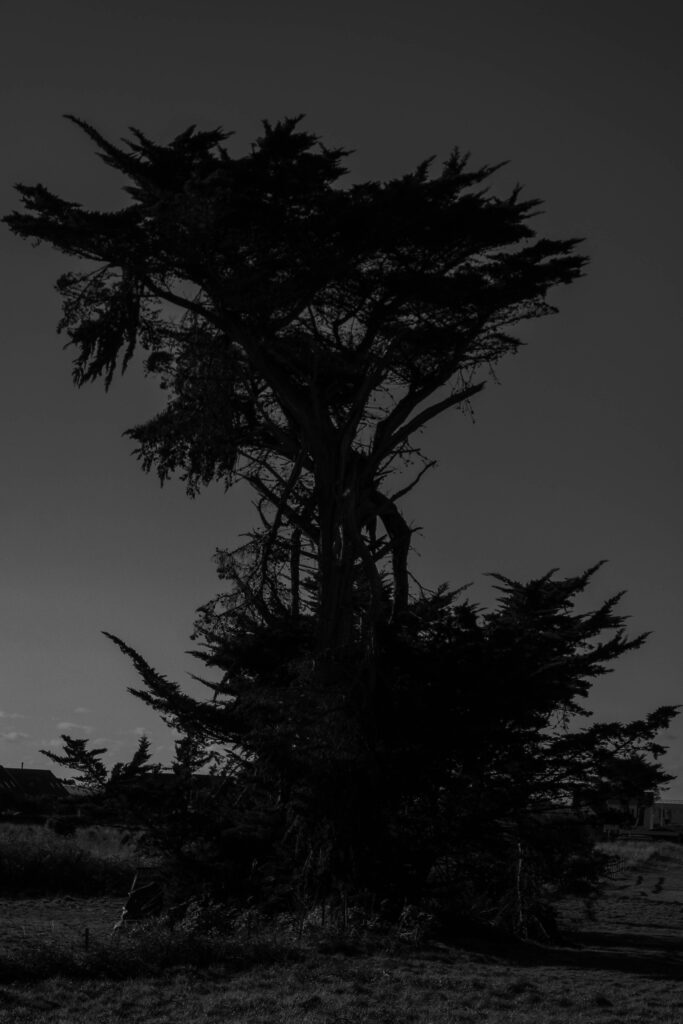
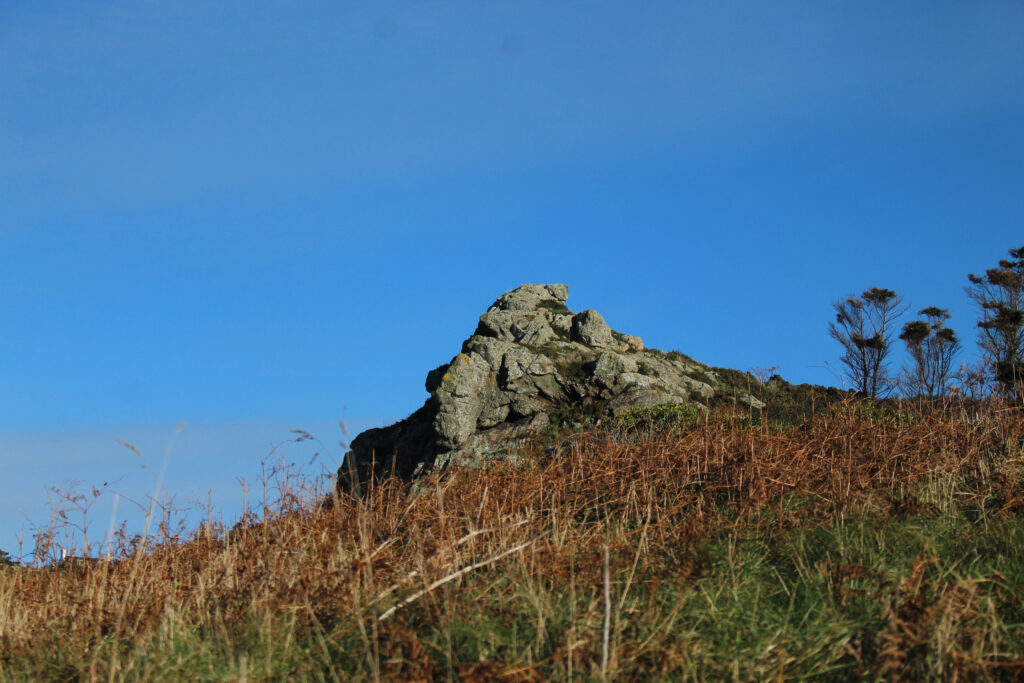
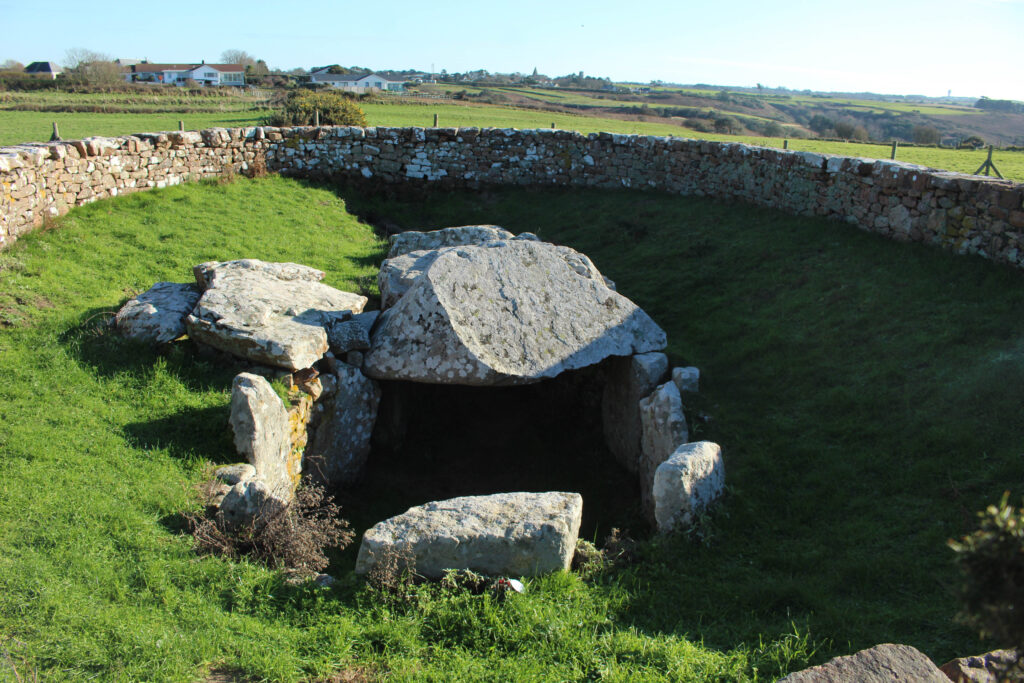
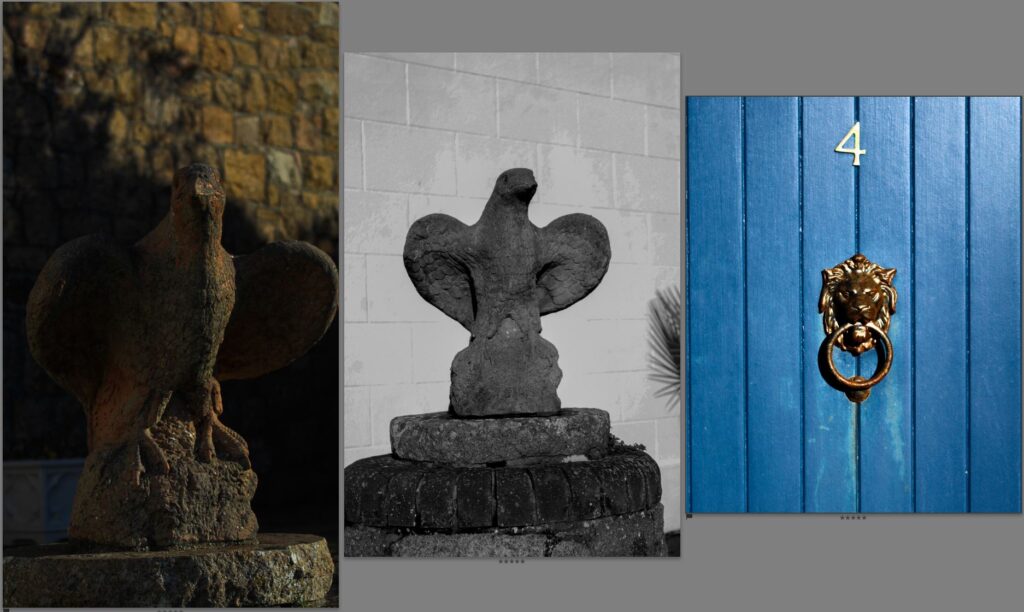
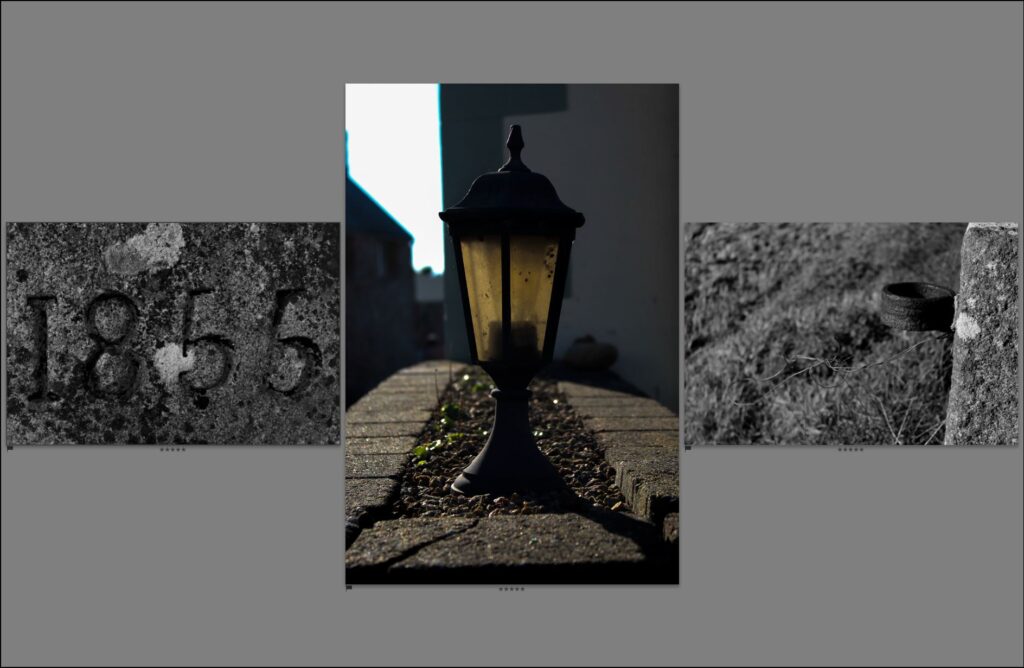
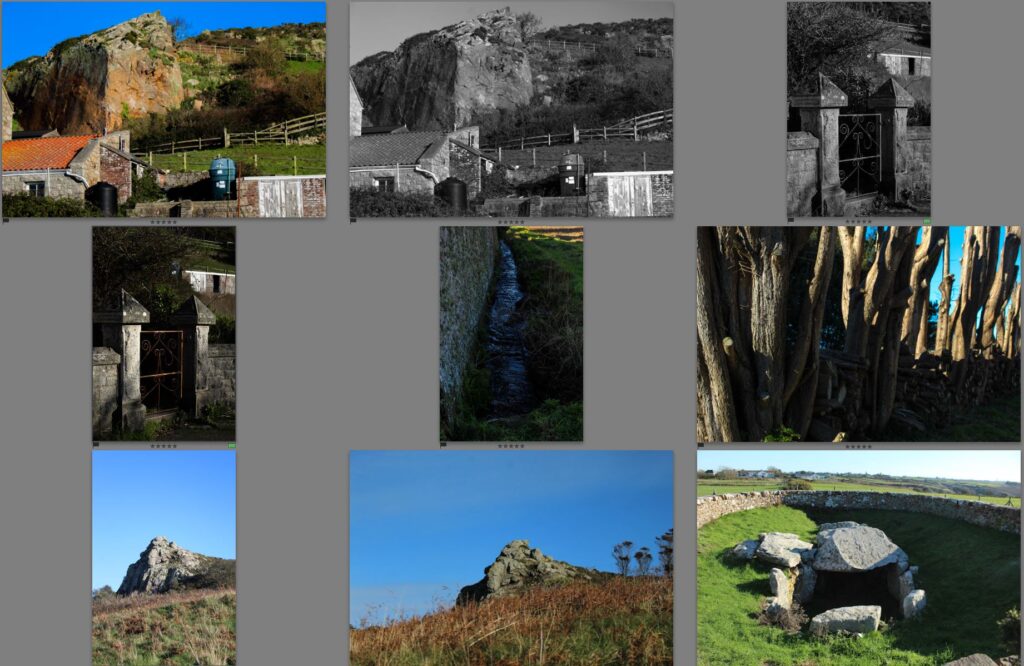
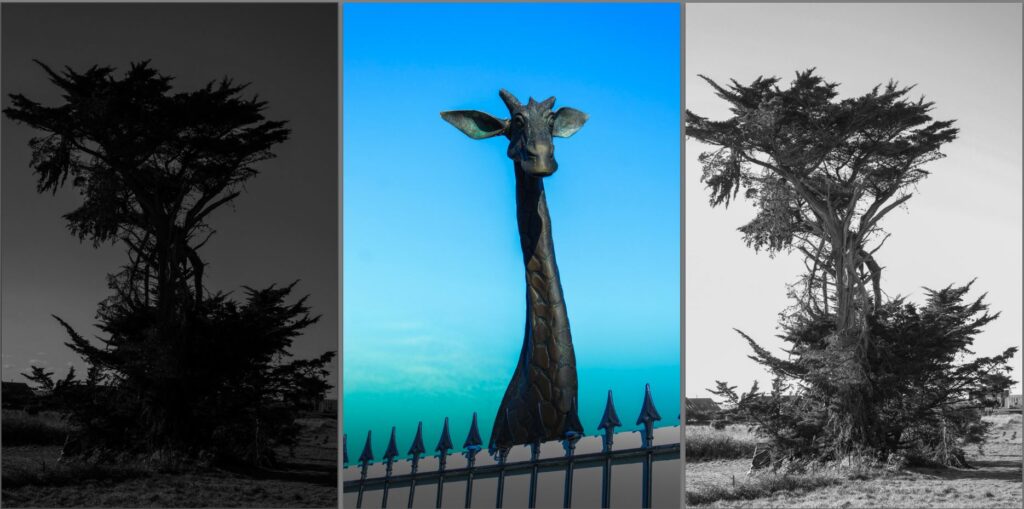
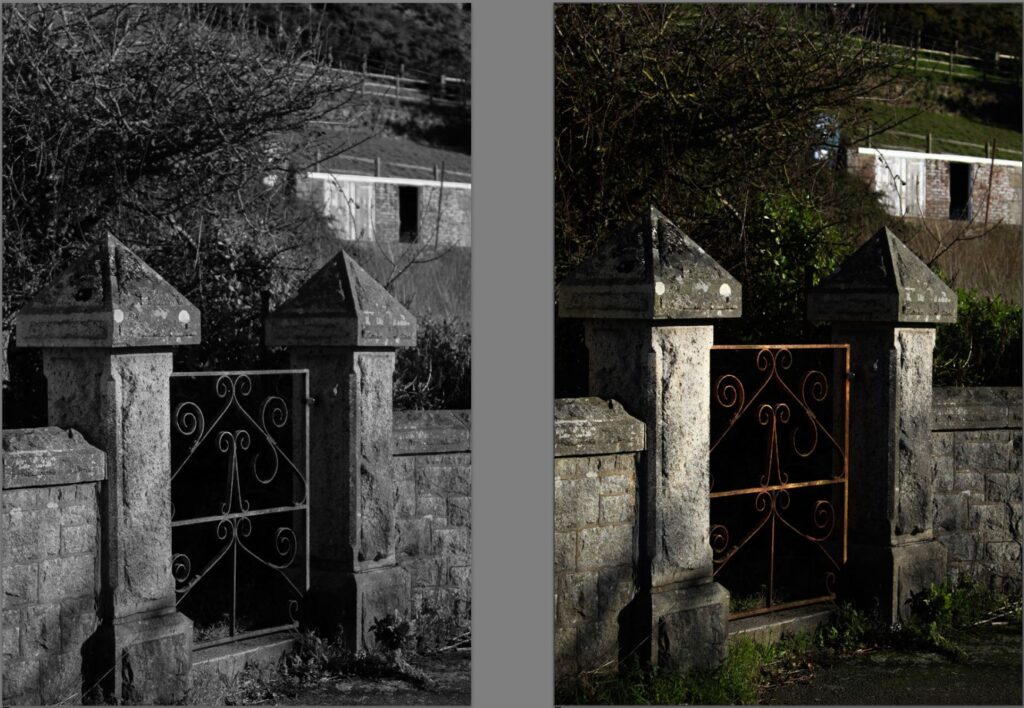
CONTACT SHEETS
I started out with 250 photos. after selecting the best of the shoot. I was left with 51, which was further altered to 31 with edited copies of a few images.
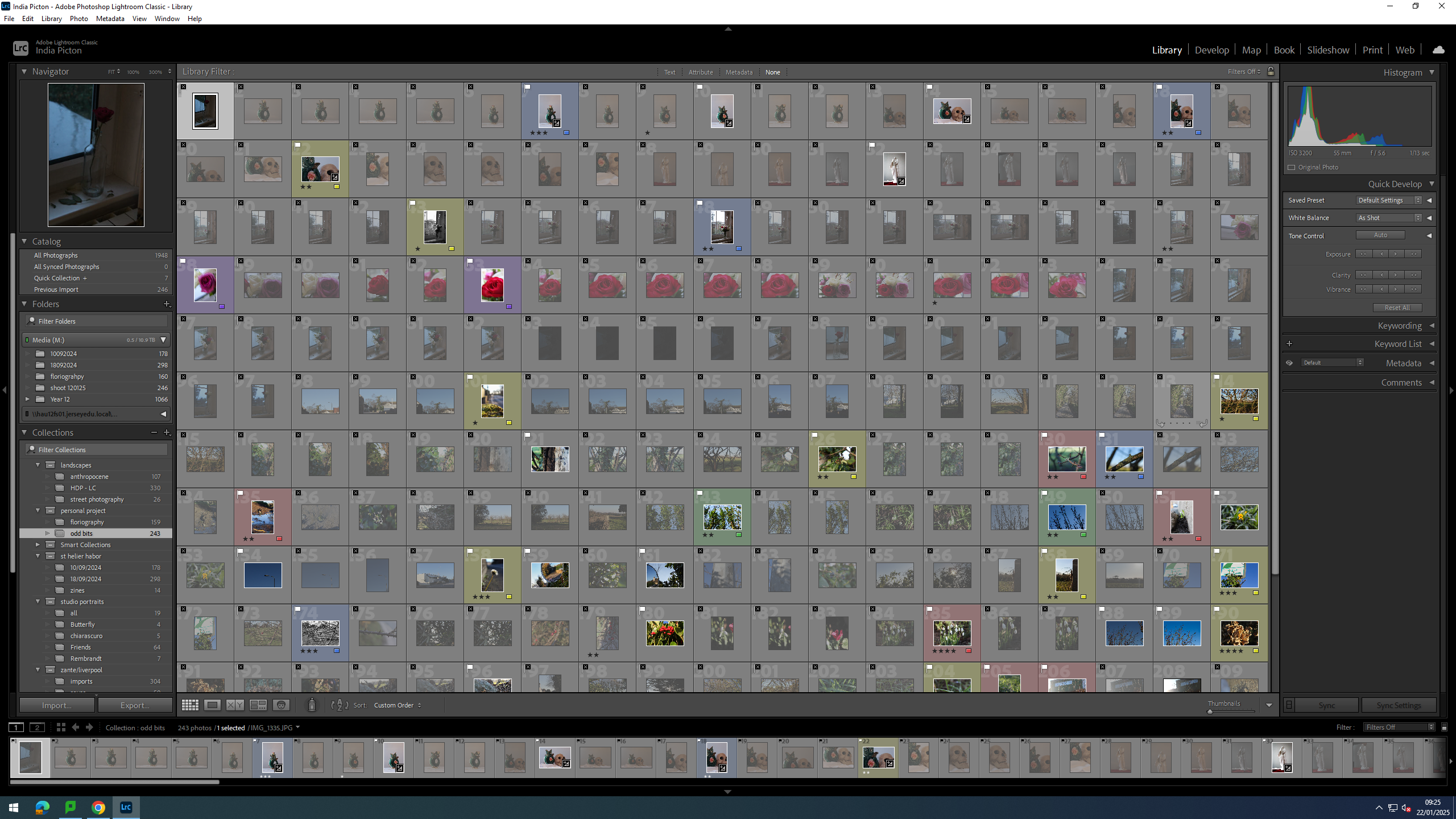
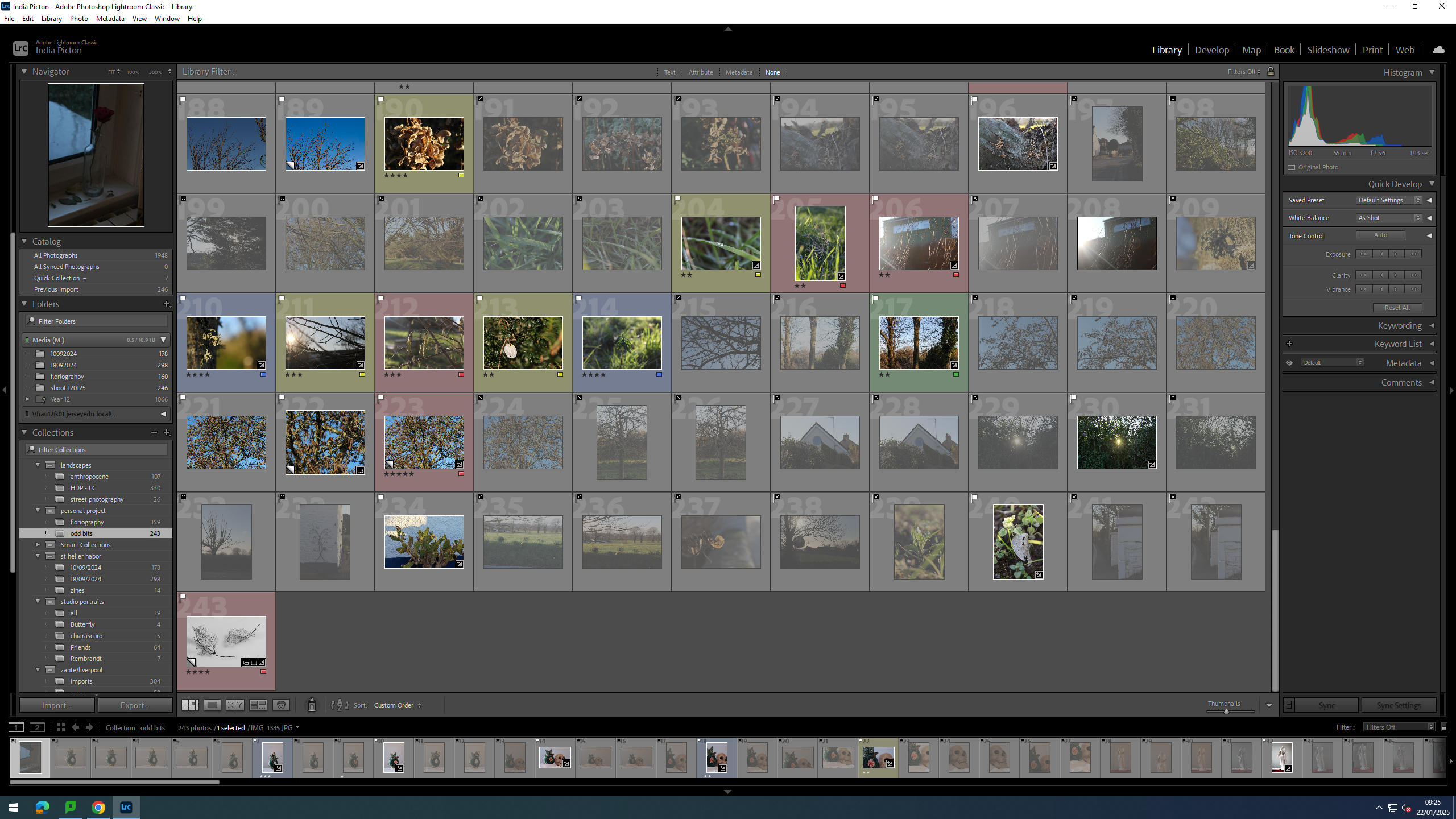
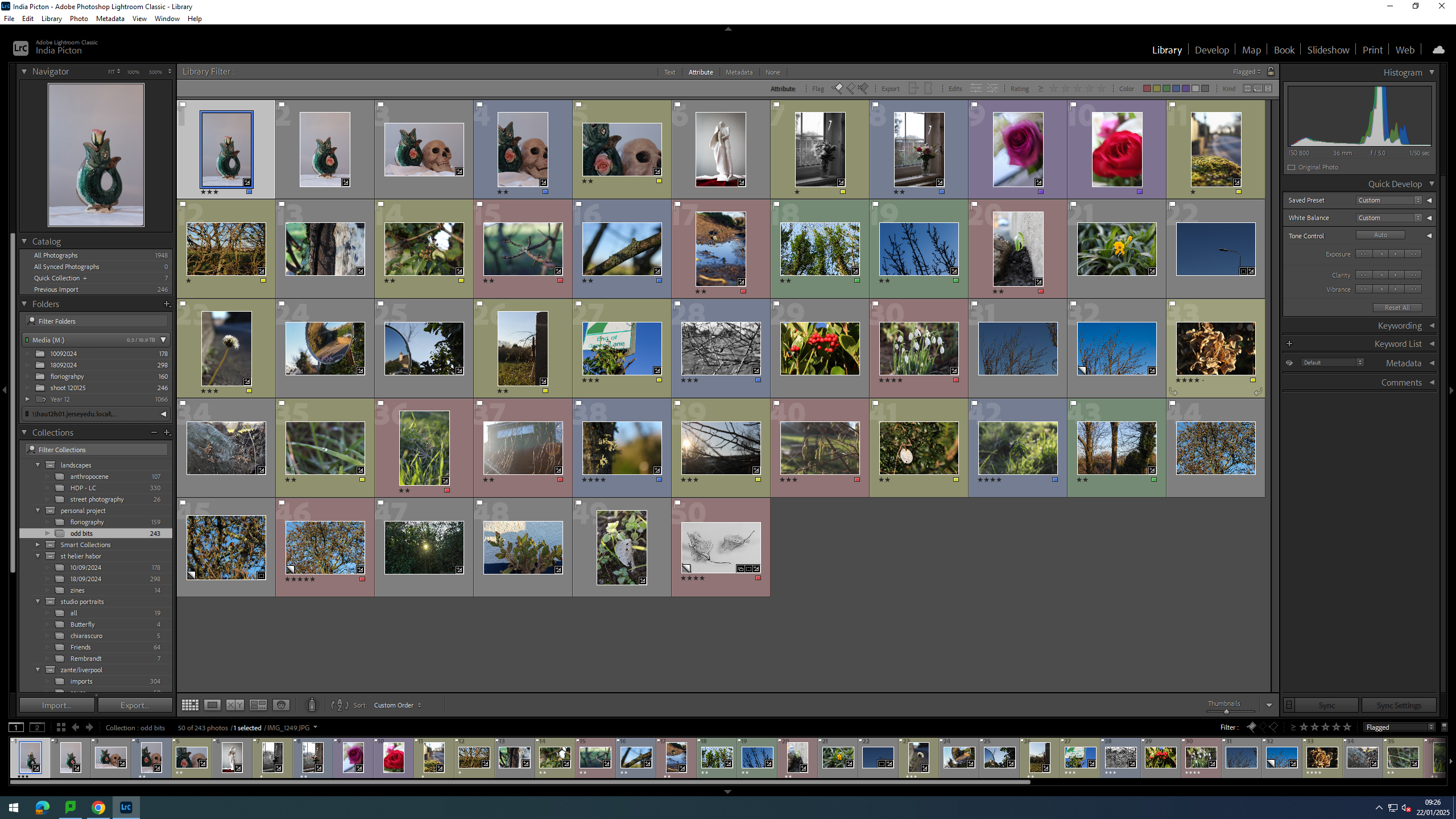
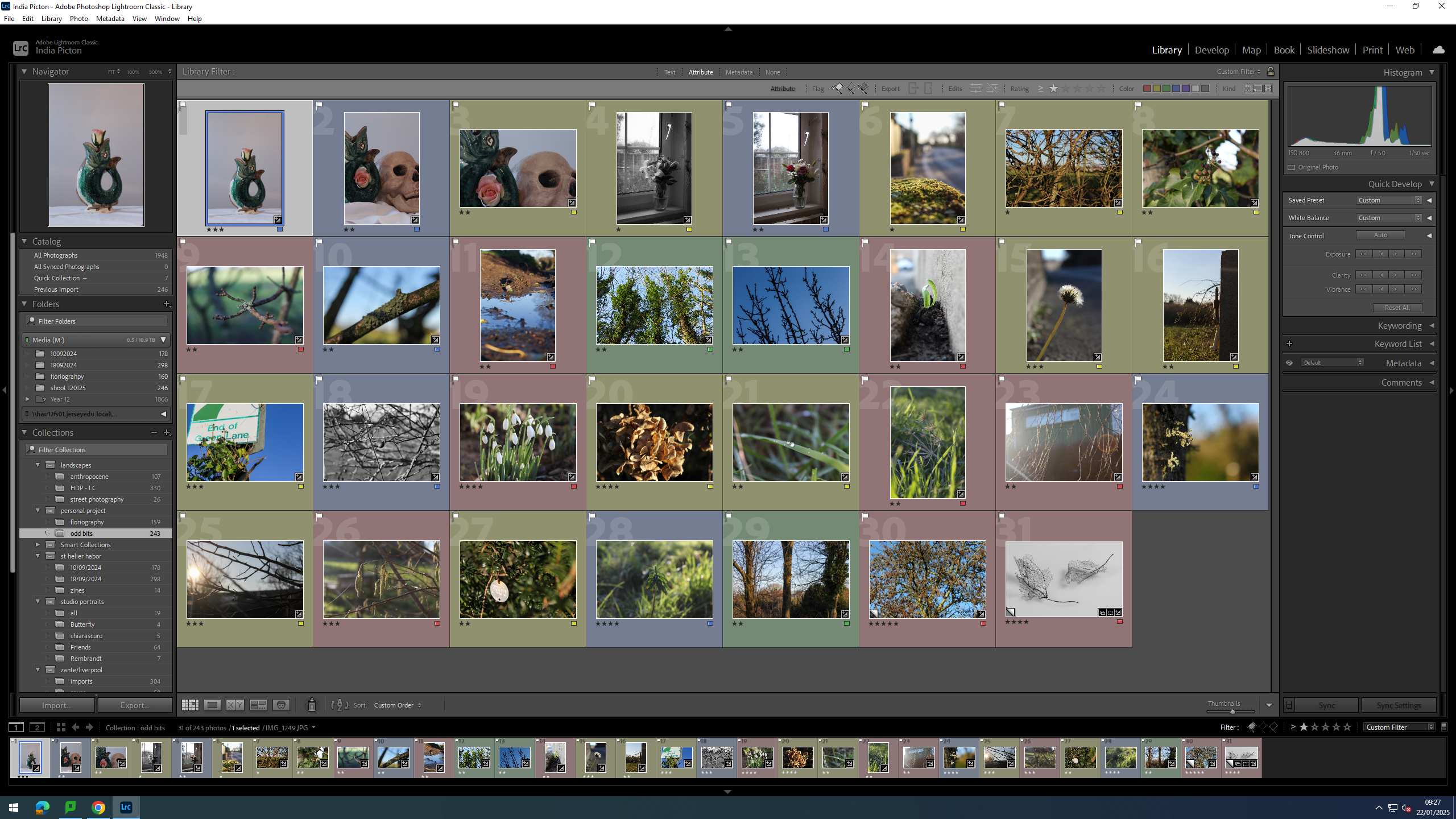
EDITING
I brightened this image up a little to make the texture stand out more.
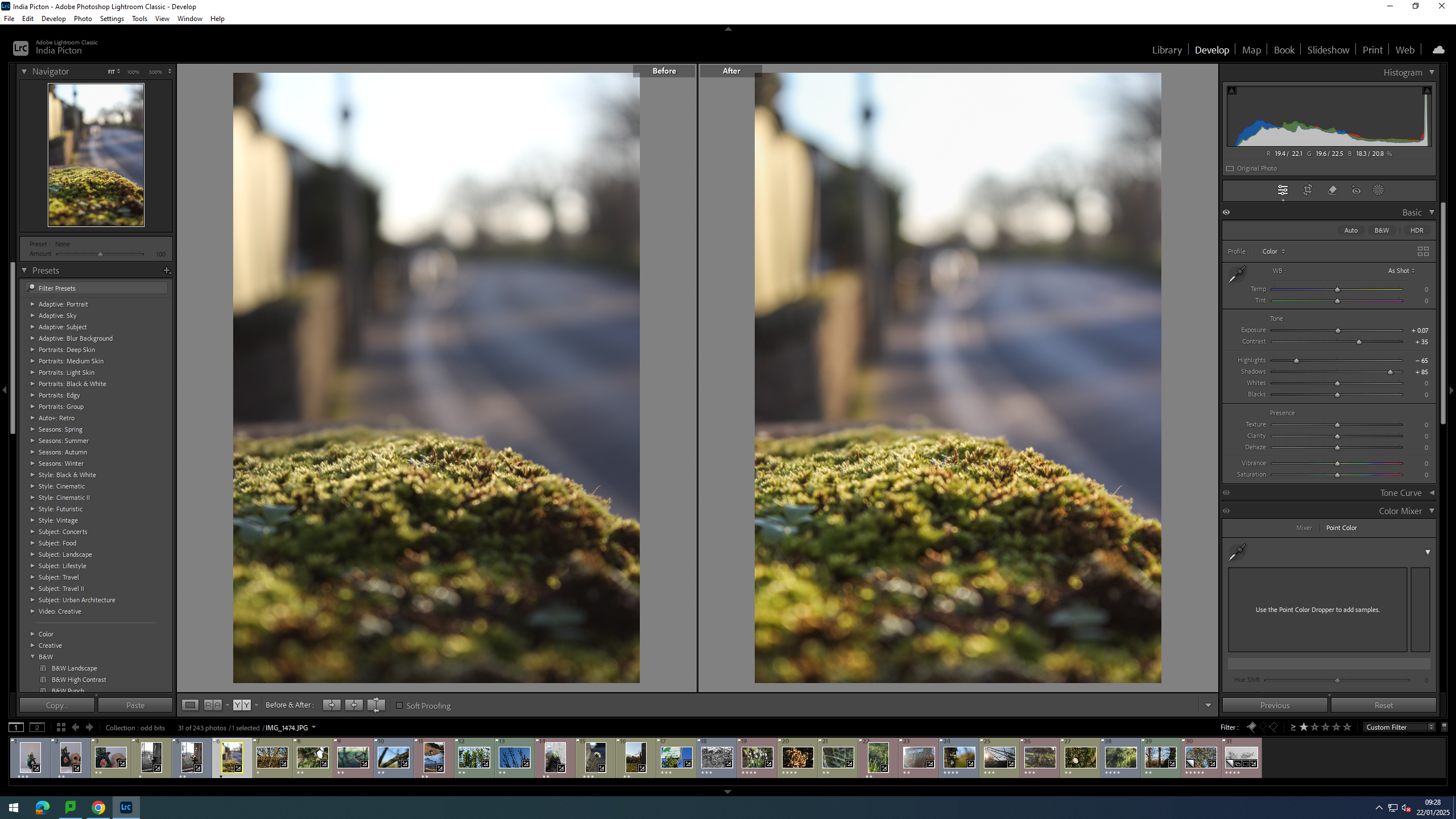
There is a superstation that snowdrops blooming in a house can bring around death. to match this I’ve made the image black and white to add the solemn aspect to it.
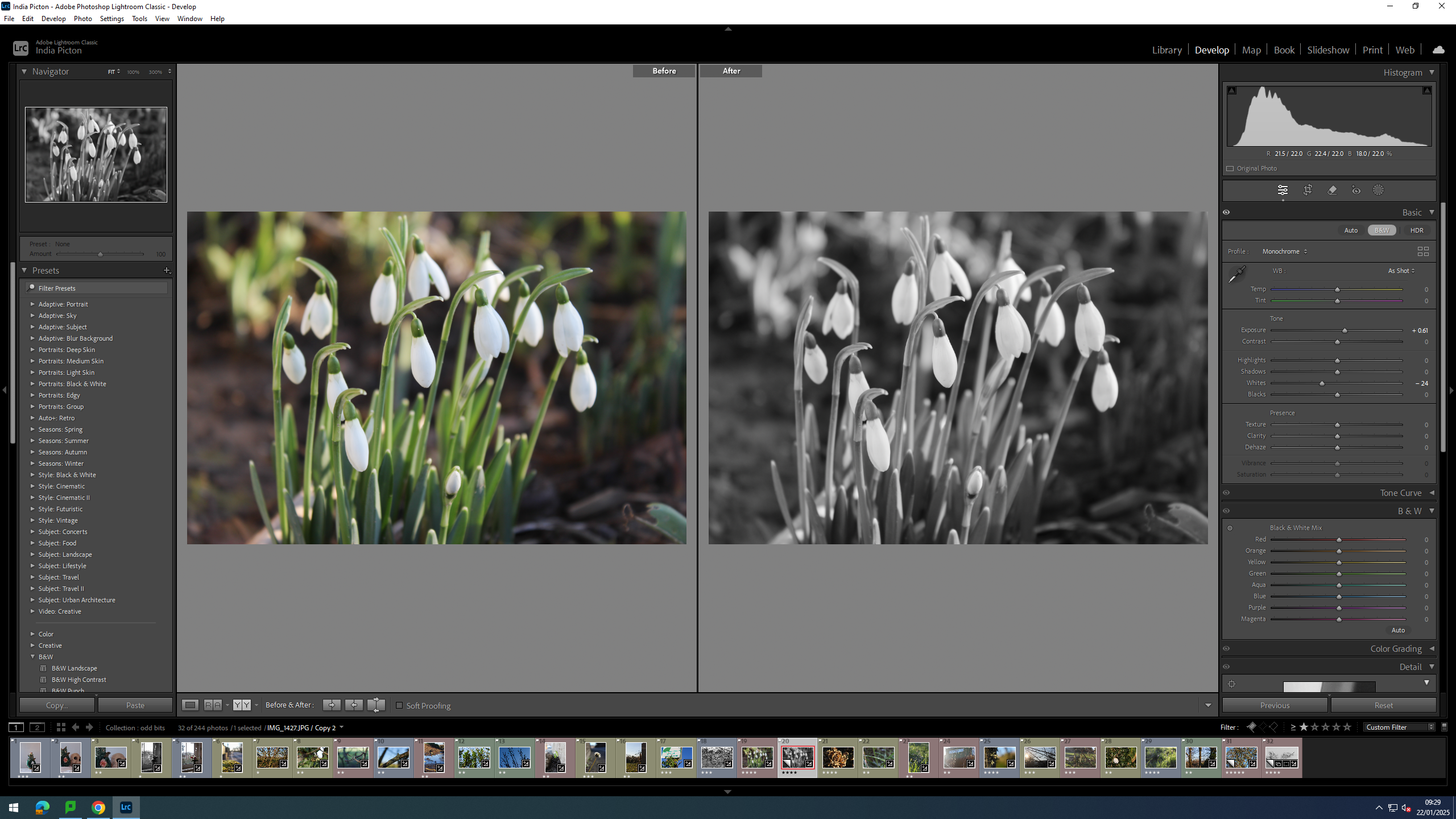
For this image I have isolated the robin so the he is the only section that is in colour. This little pop of colour against the black and white background can immediately catches the eye.
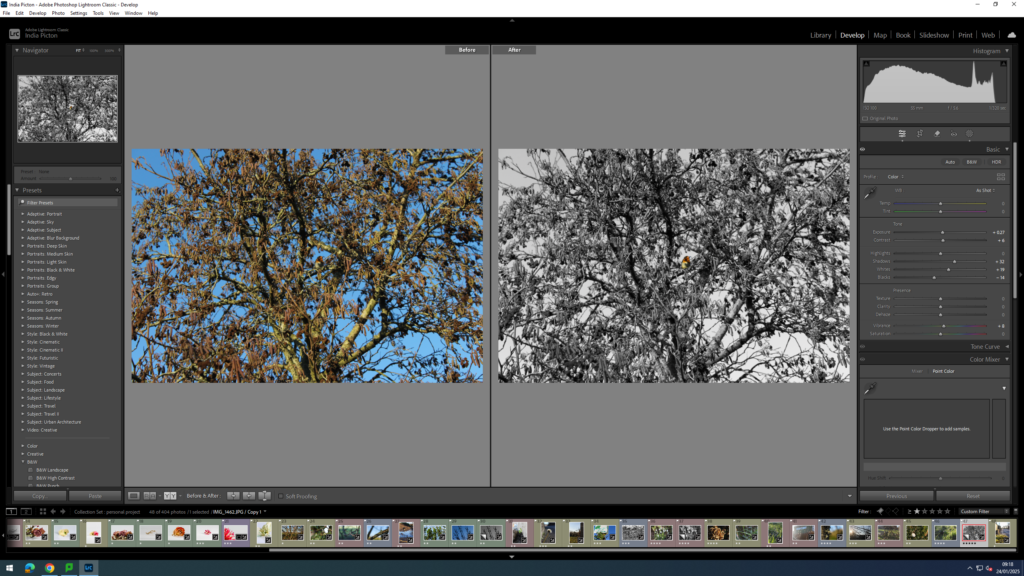
For this image I isolated to dew drops on the blade of grass. this makes it pop a little more, creating a sharper image.
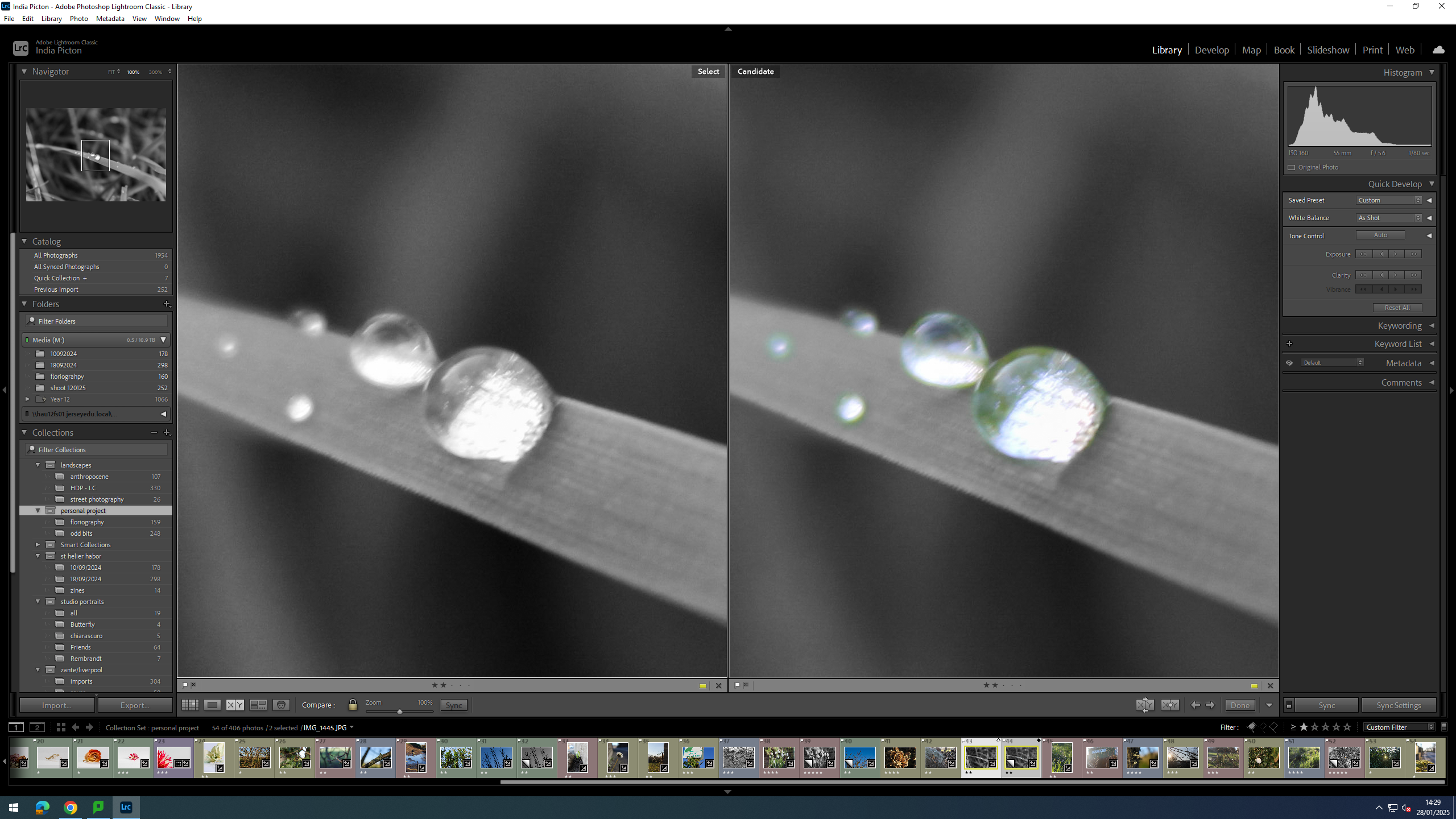
FINAL PHOTOS
This image immediately caught my eye when I was looking though them. The orange light flare contrasts nicely with the green warehouse in the background. the background being out of focus adds a nice depth of field to the image, and the rays of light in the bottom corner add a sort of ethereal quality to the image.
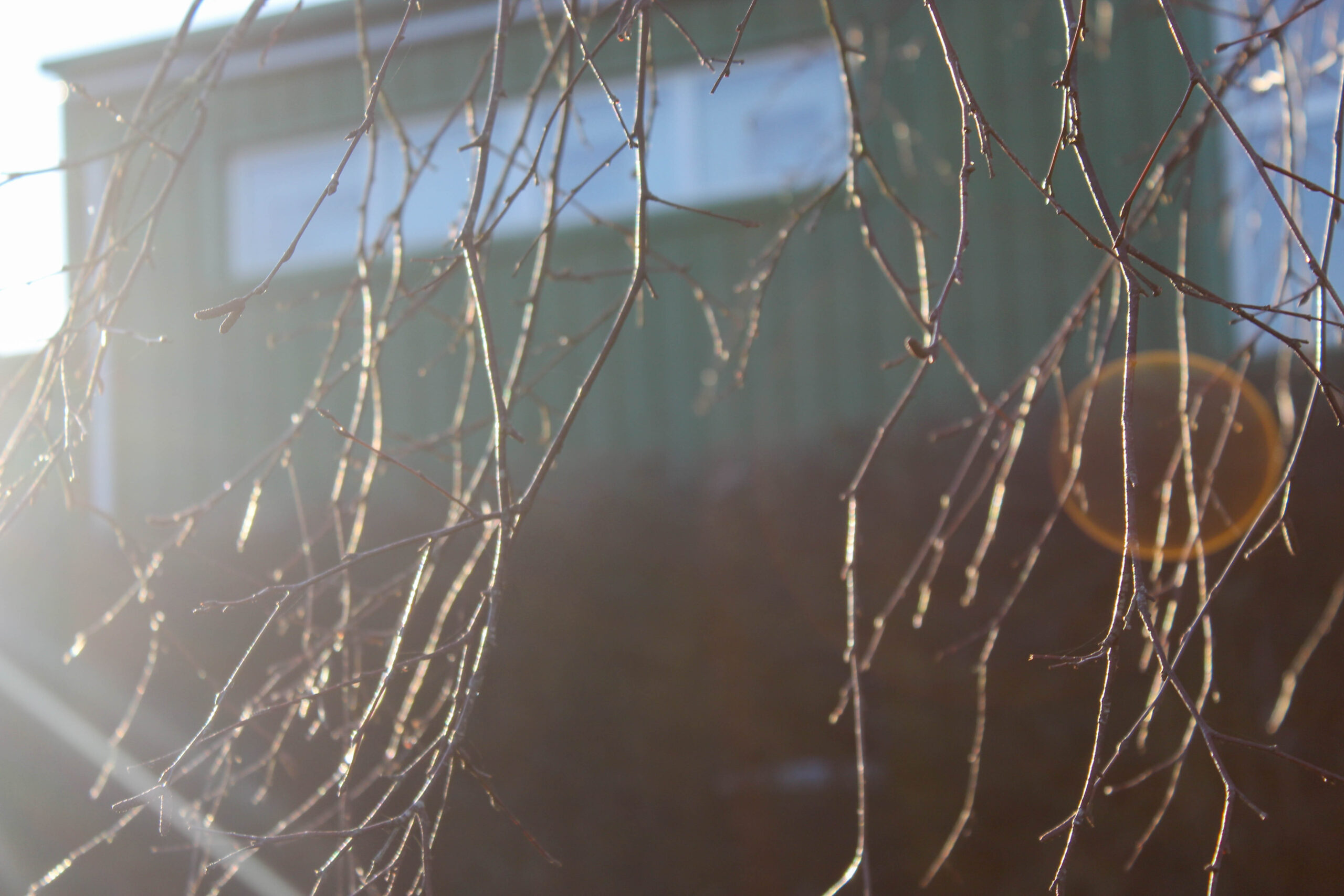
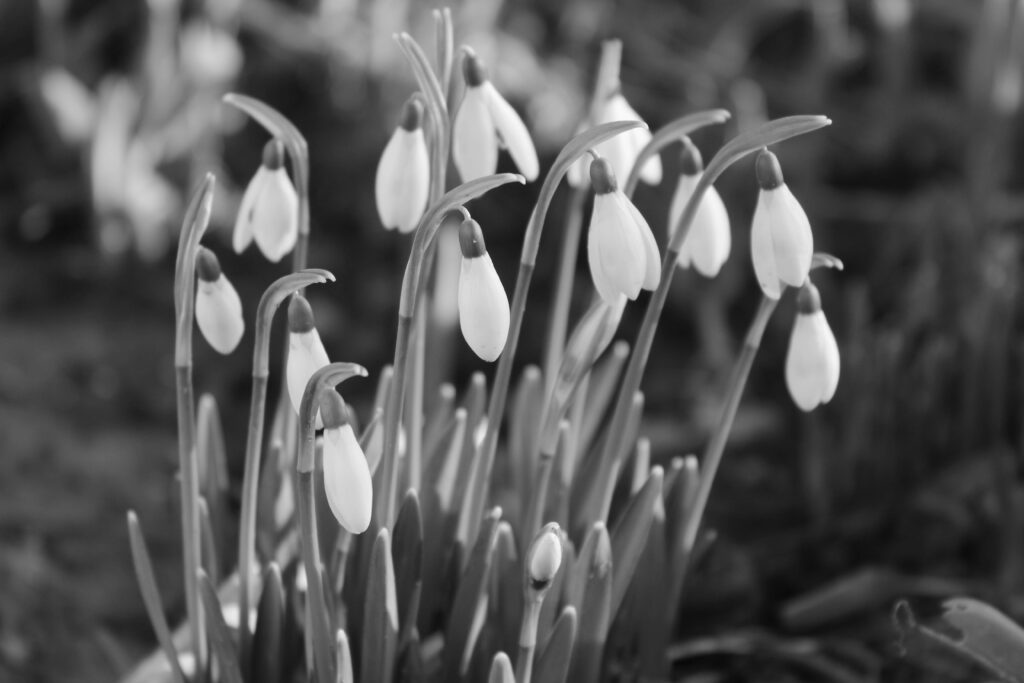
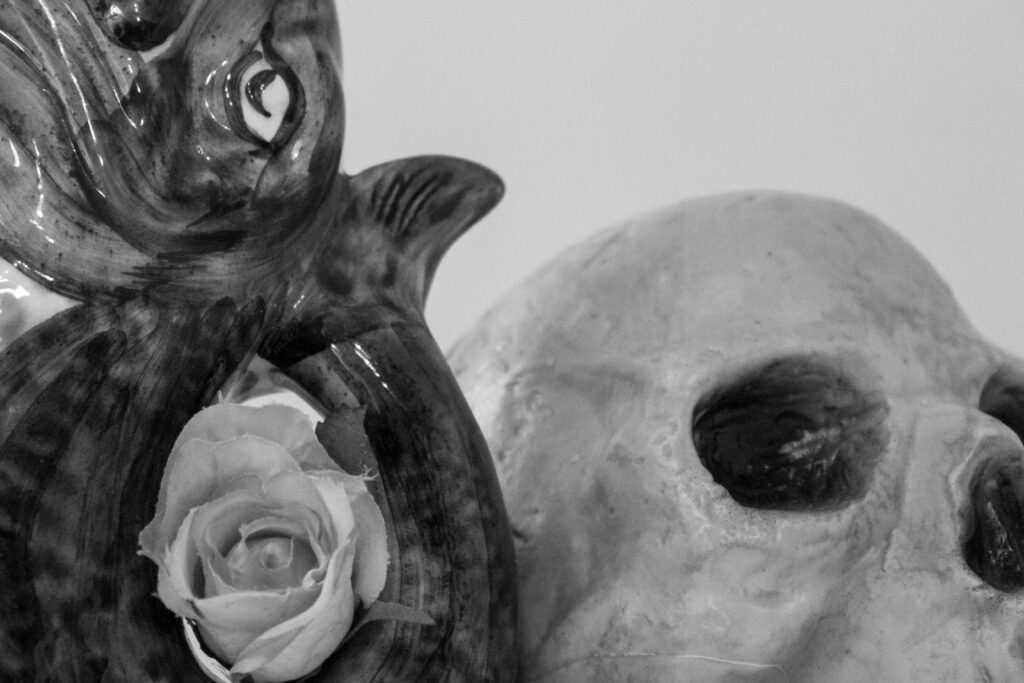
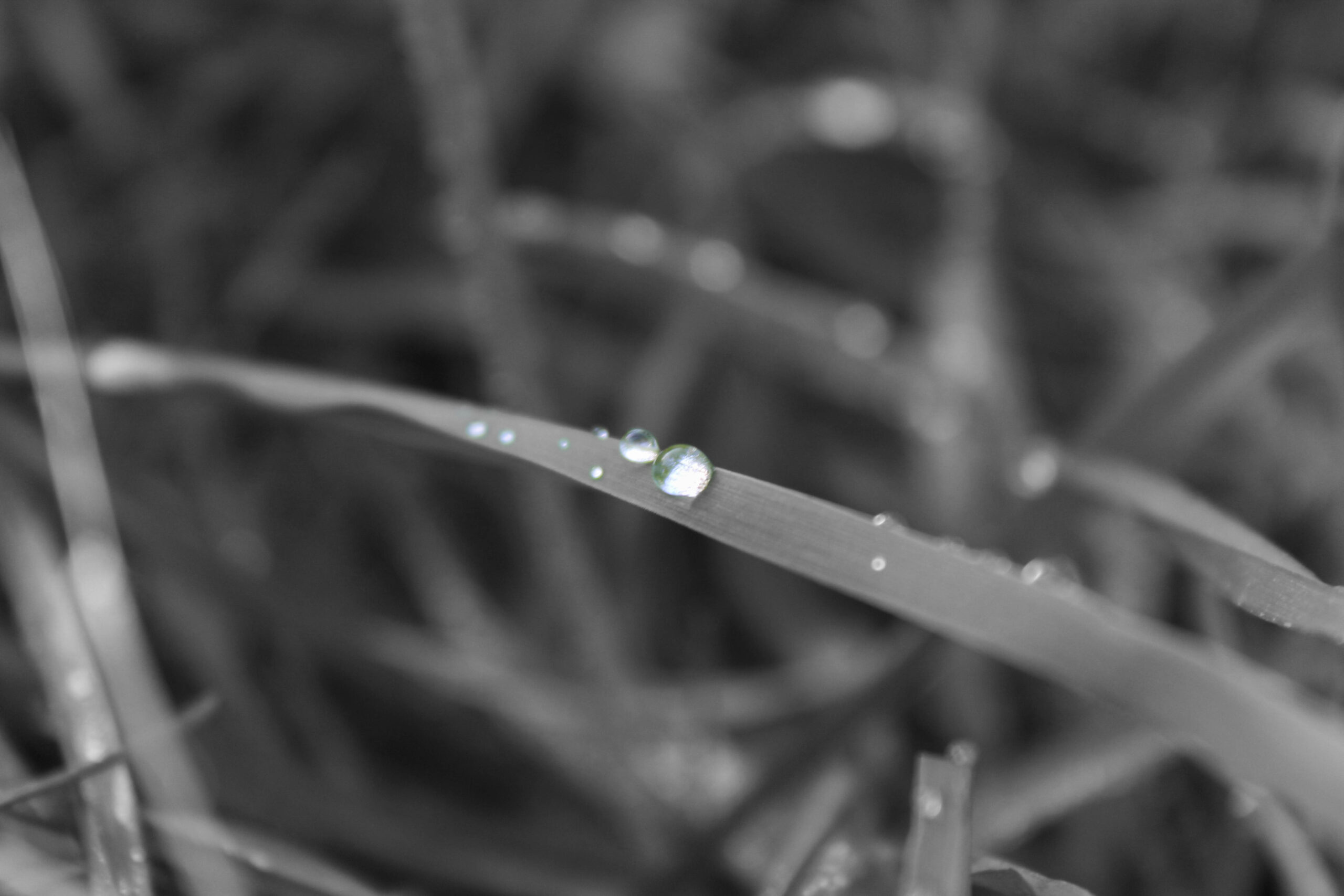
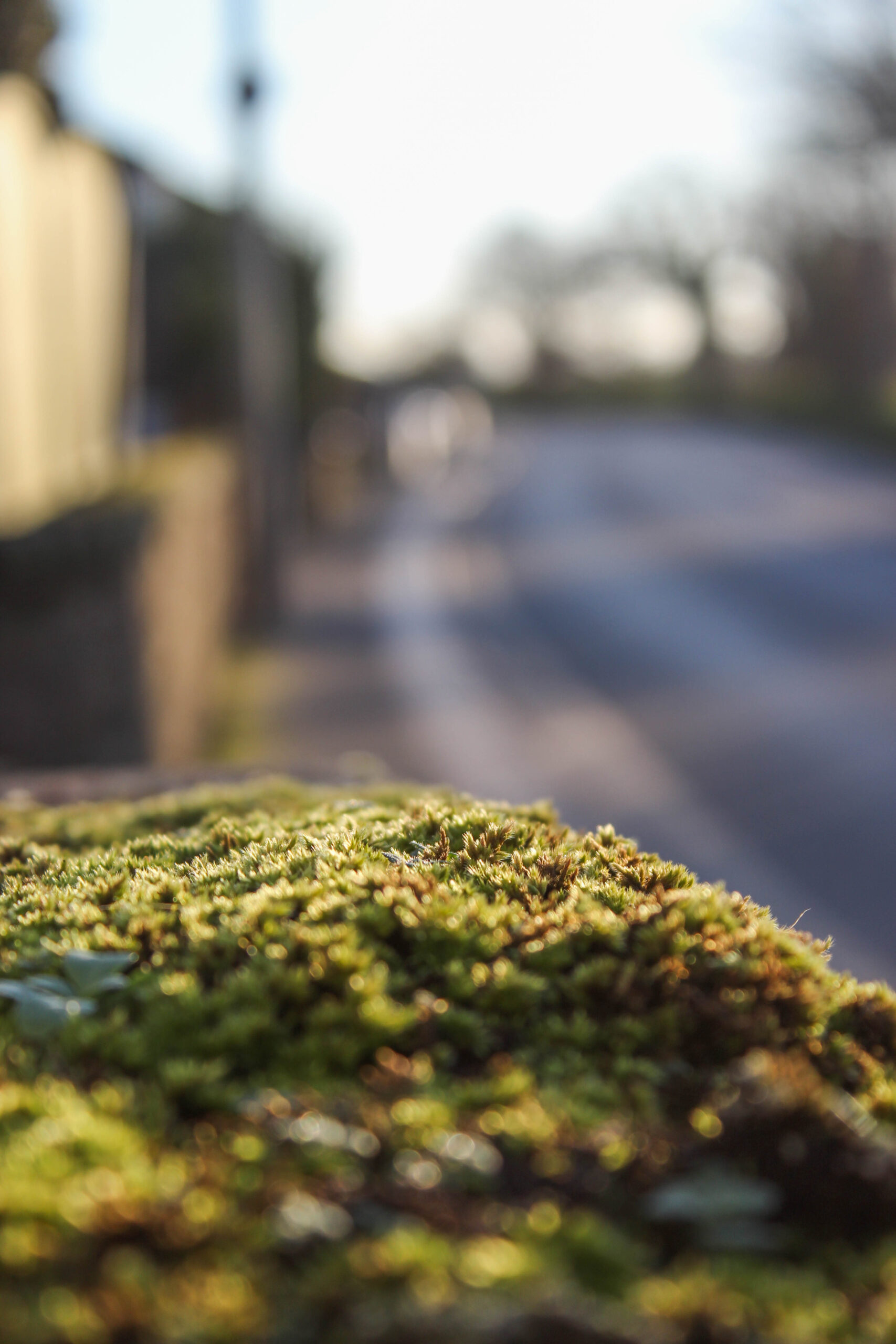
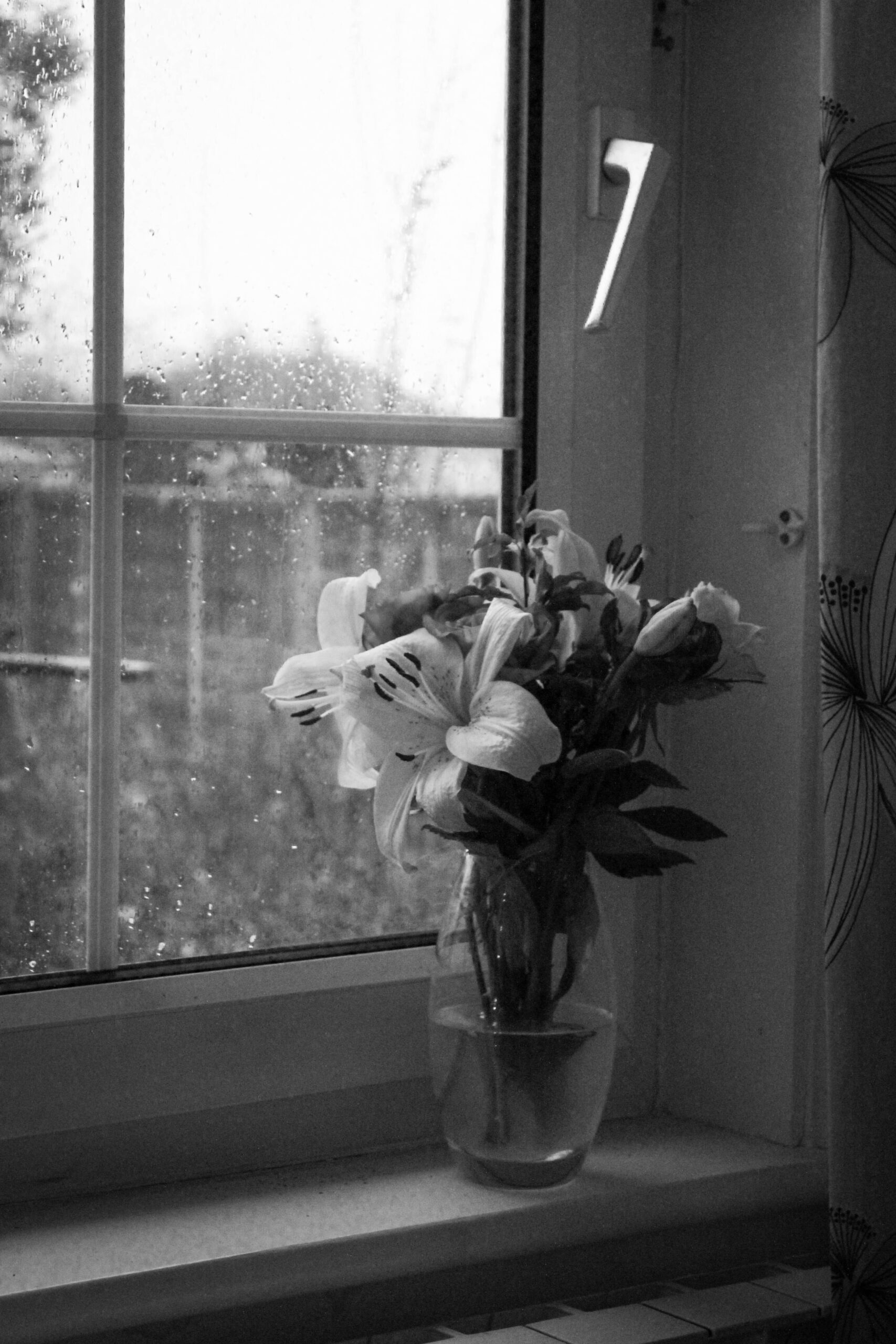
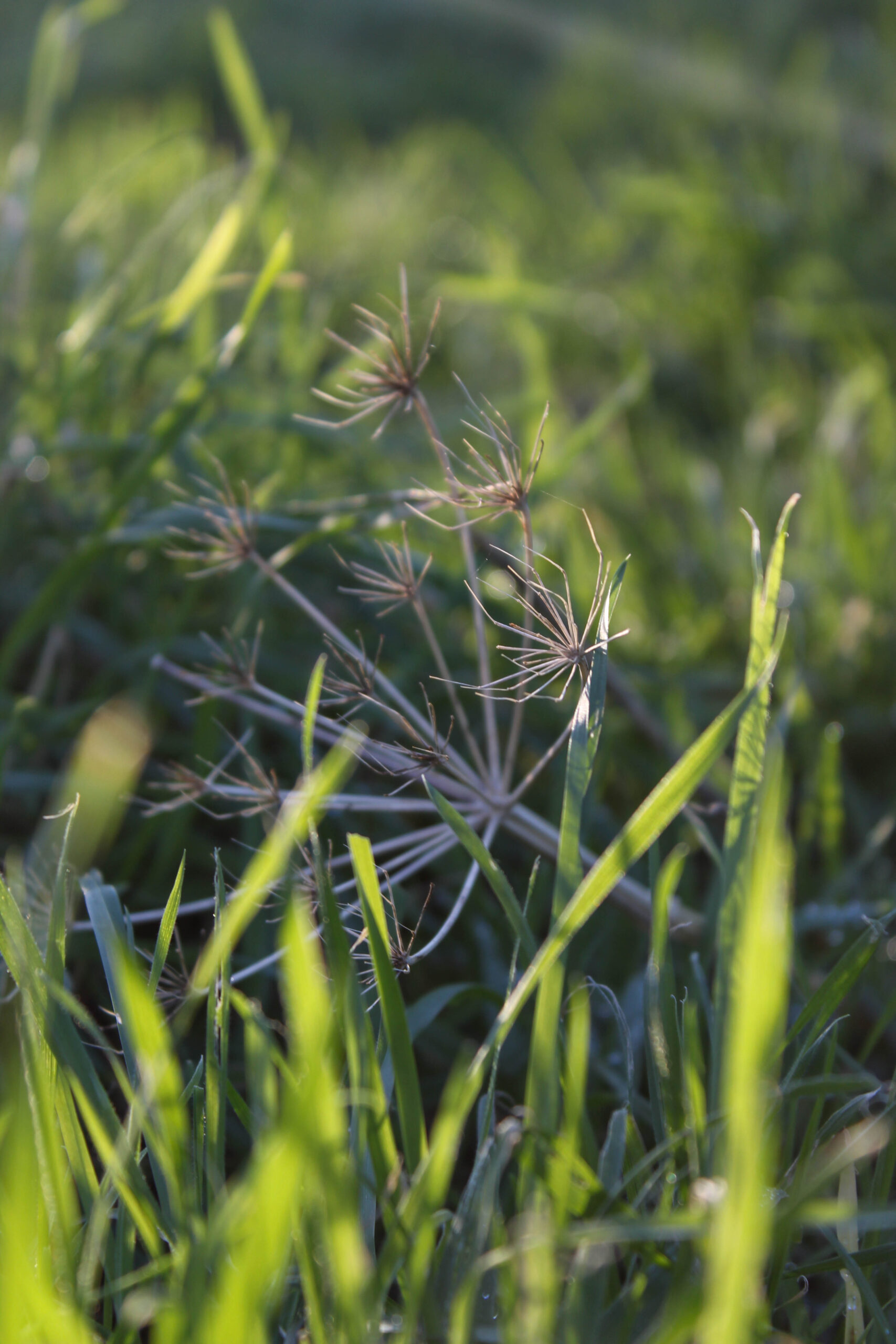
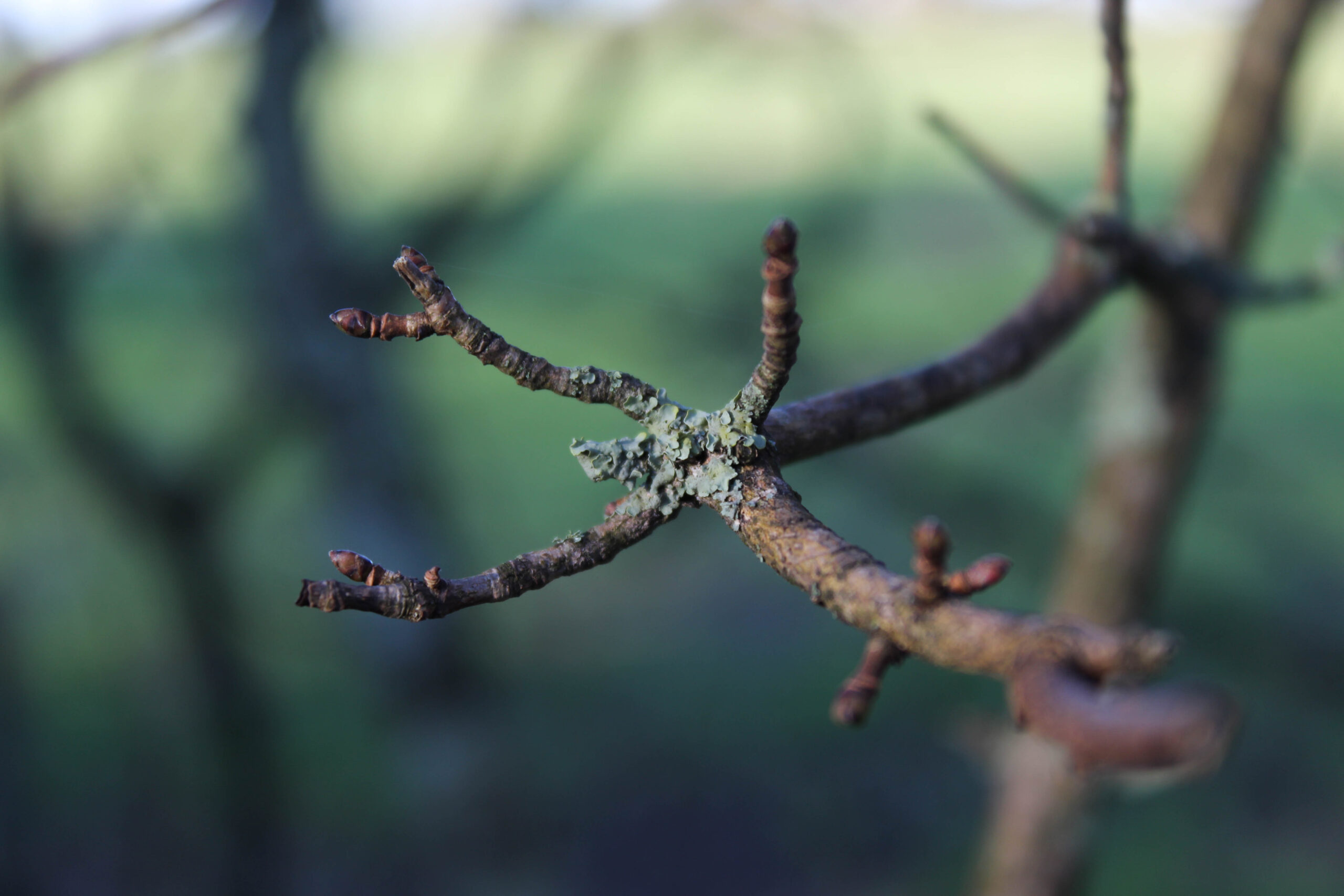
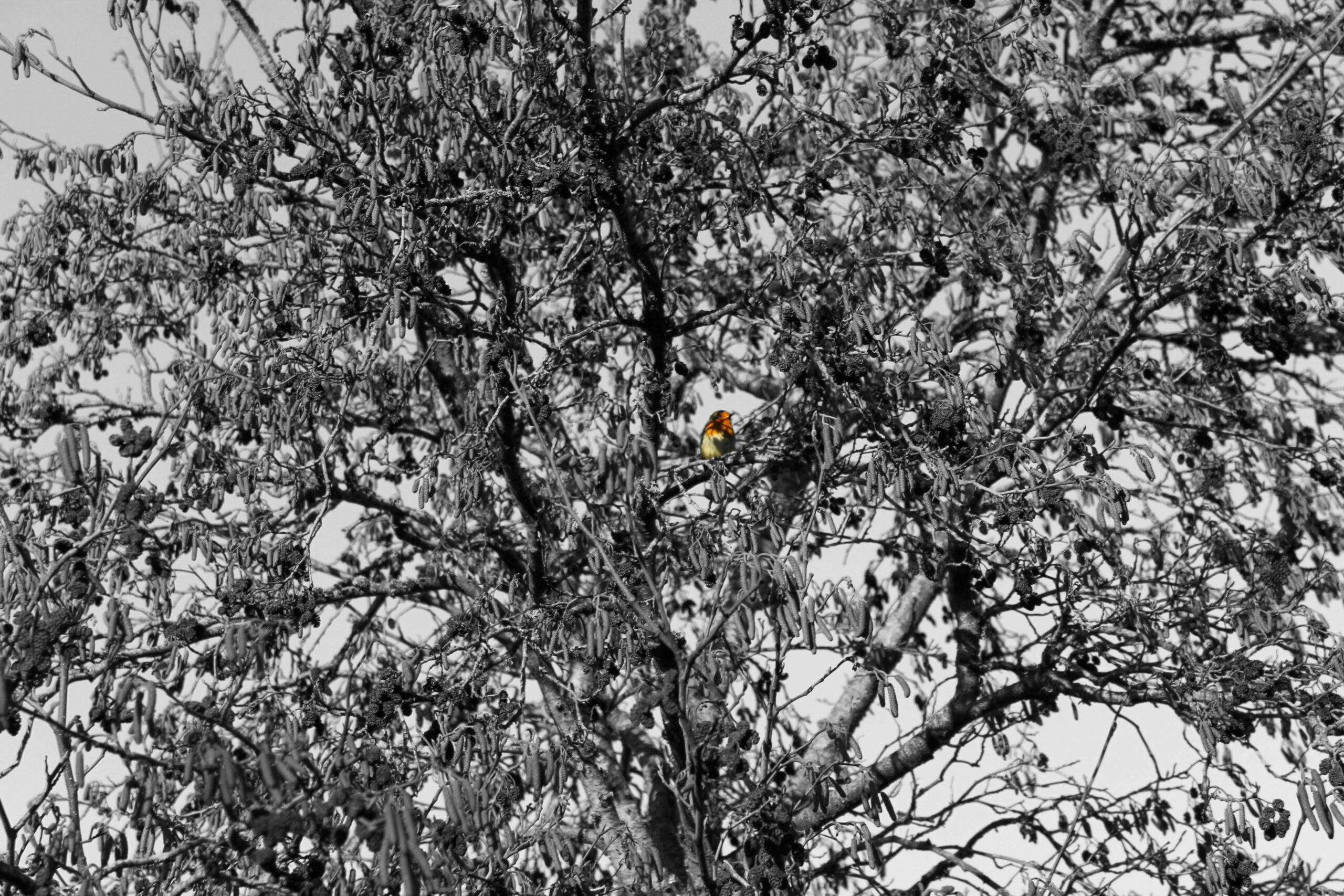

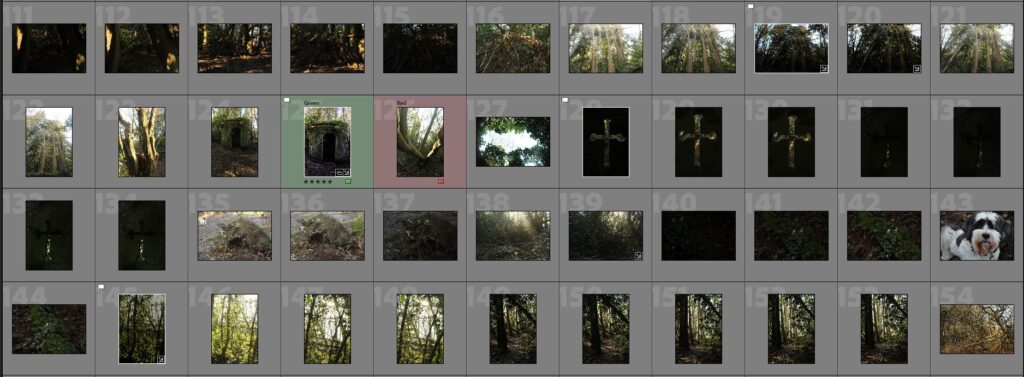
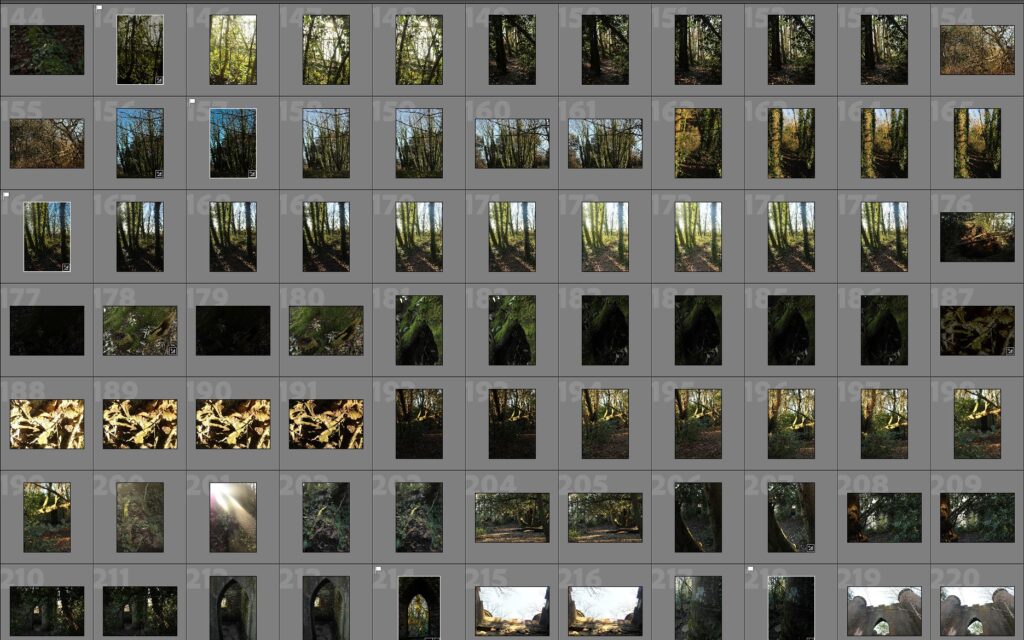
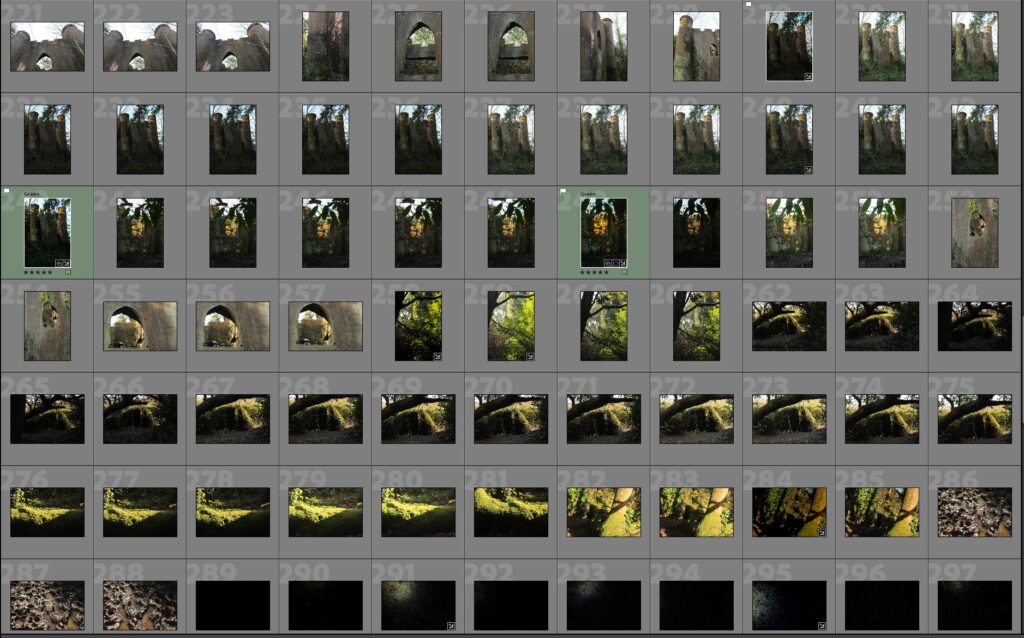
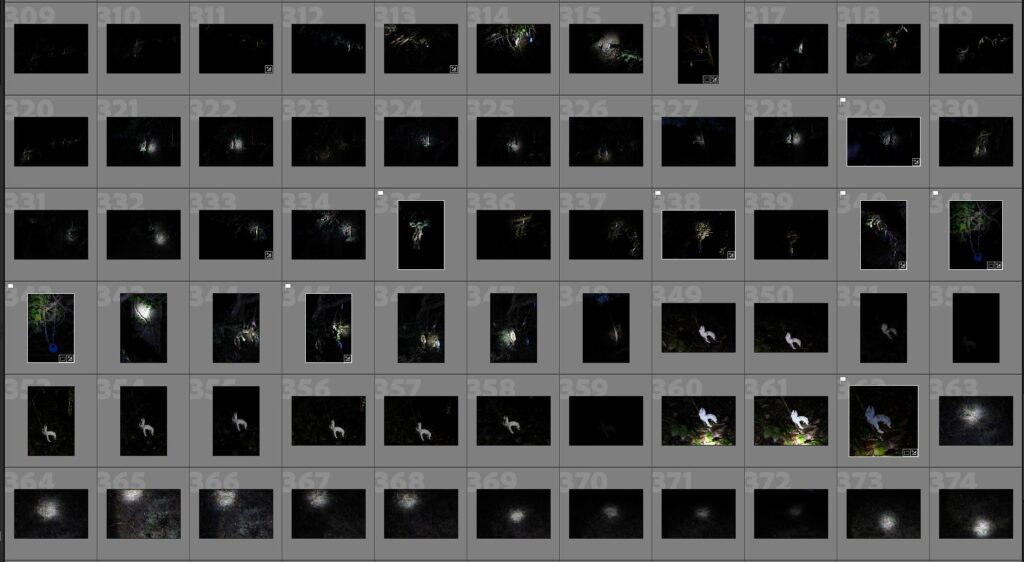
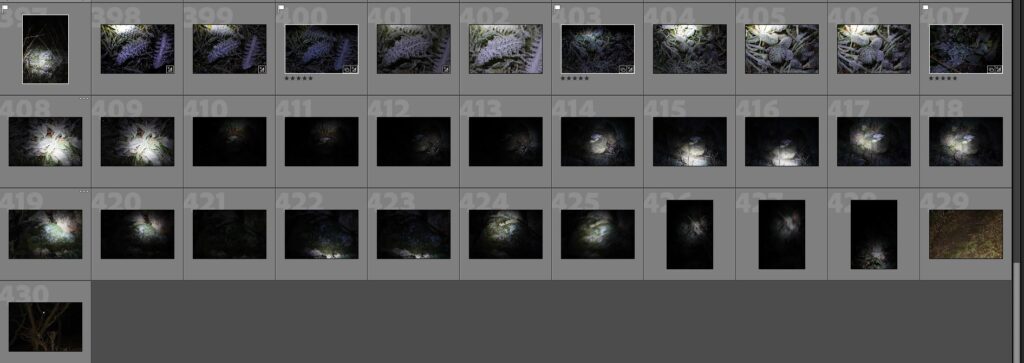


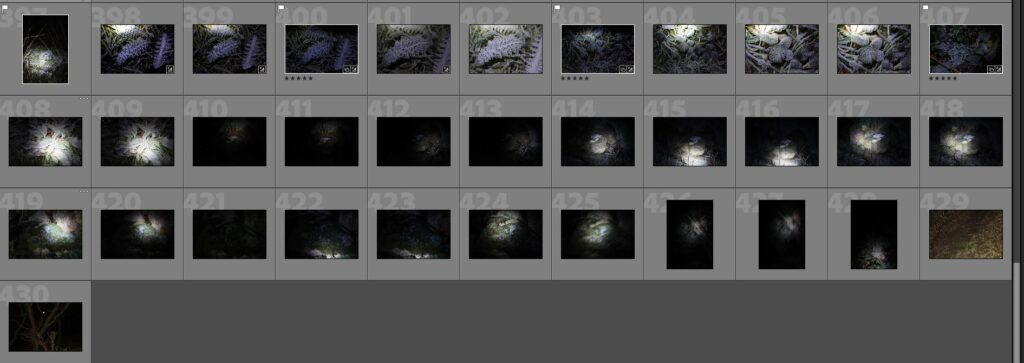

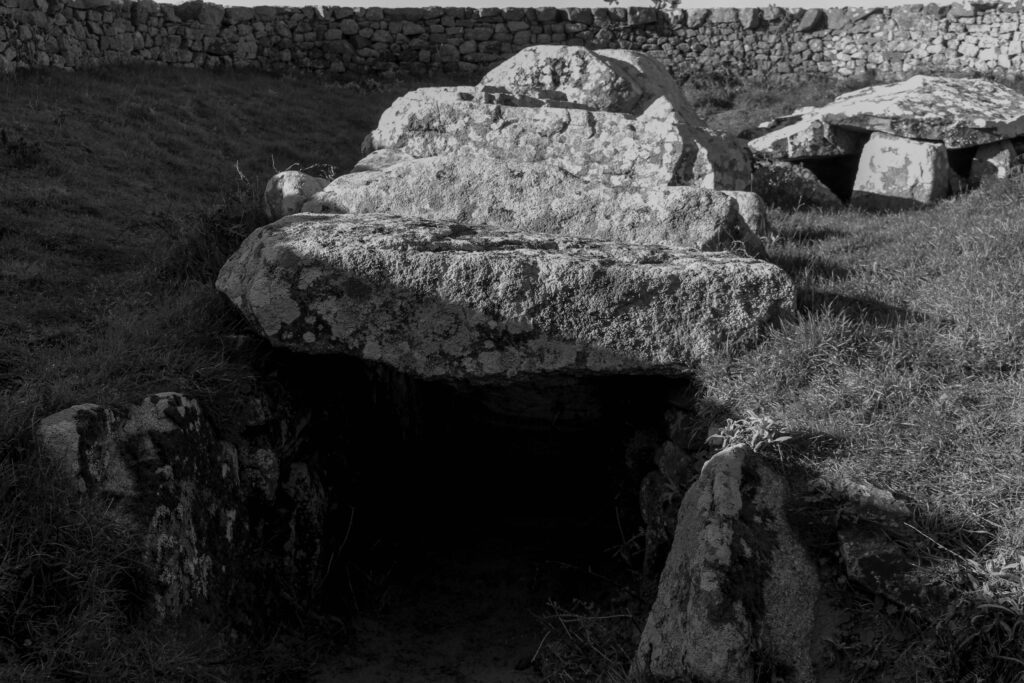
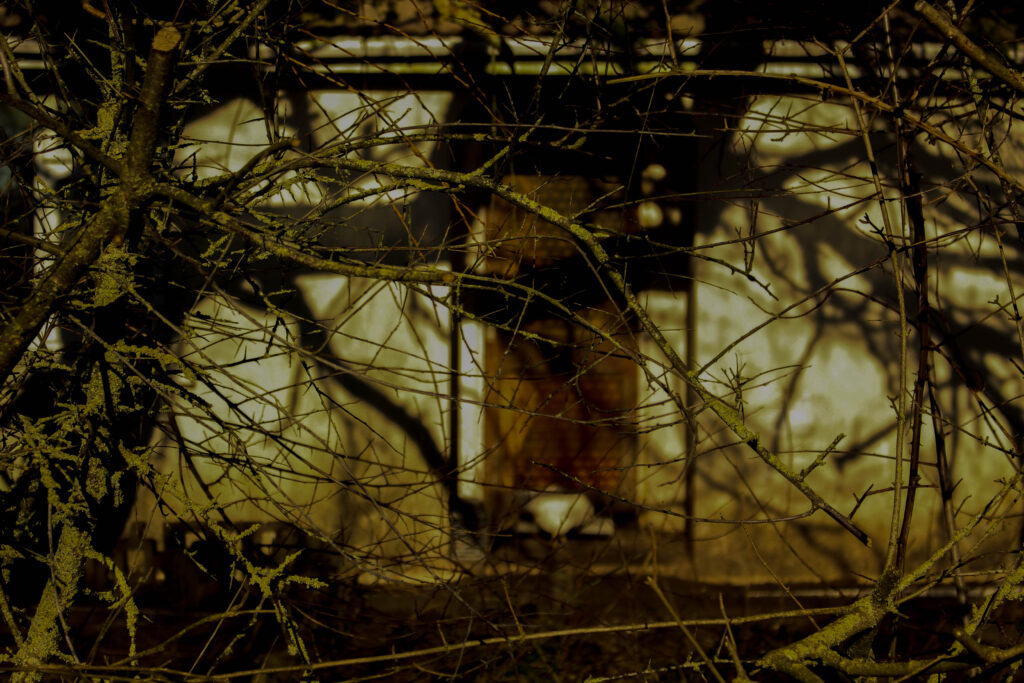
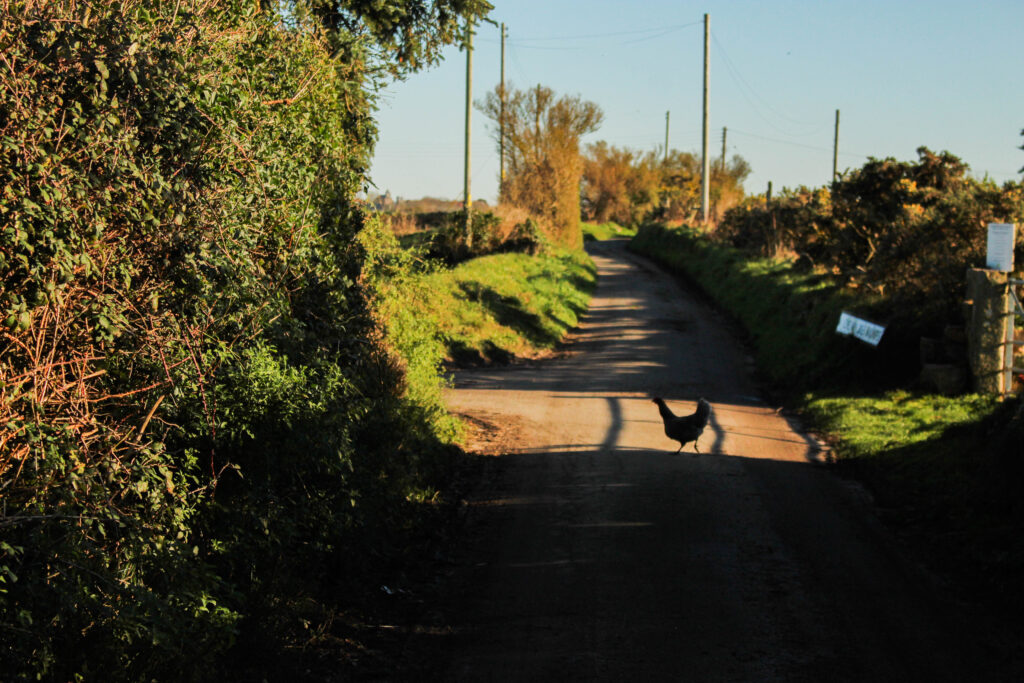
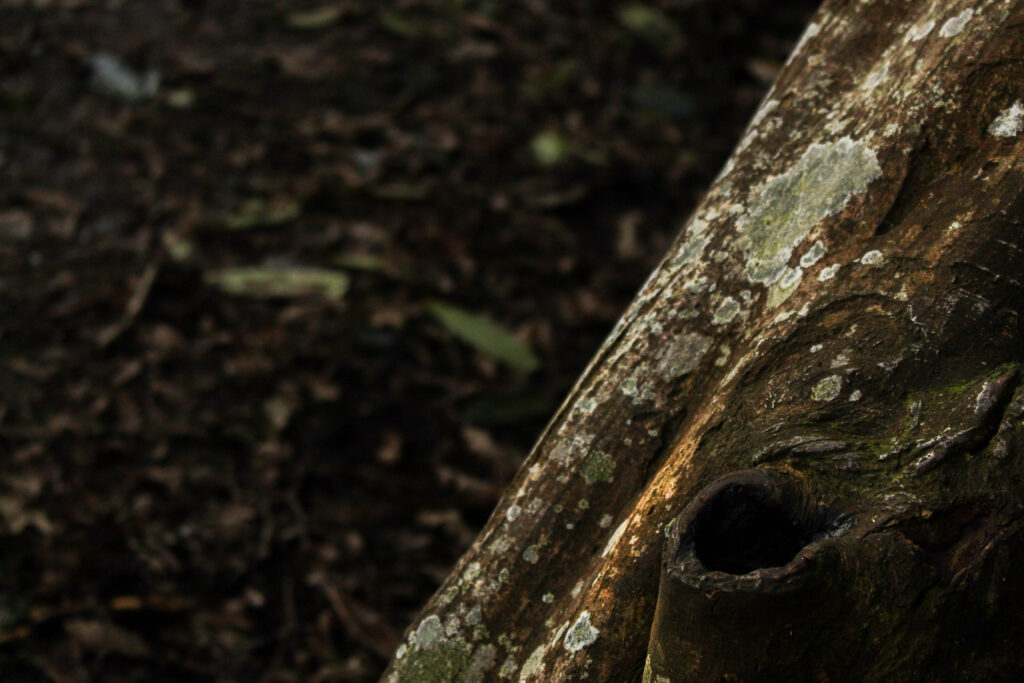
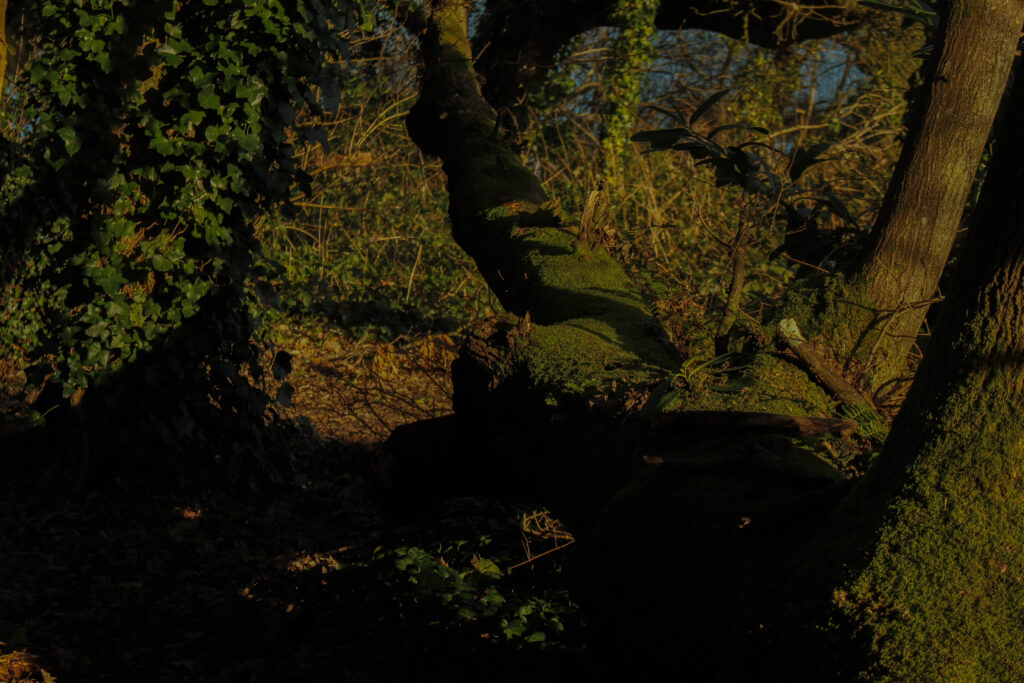
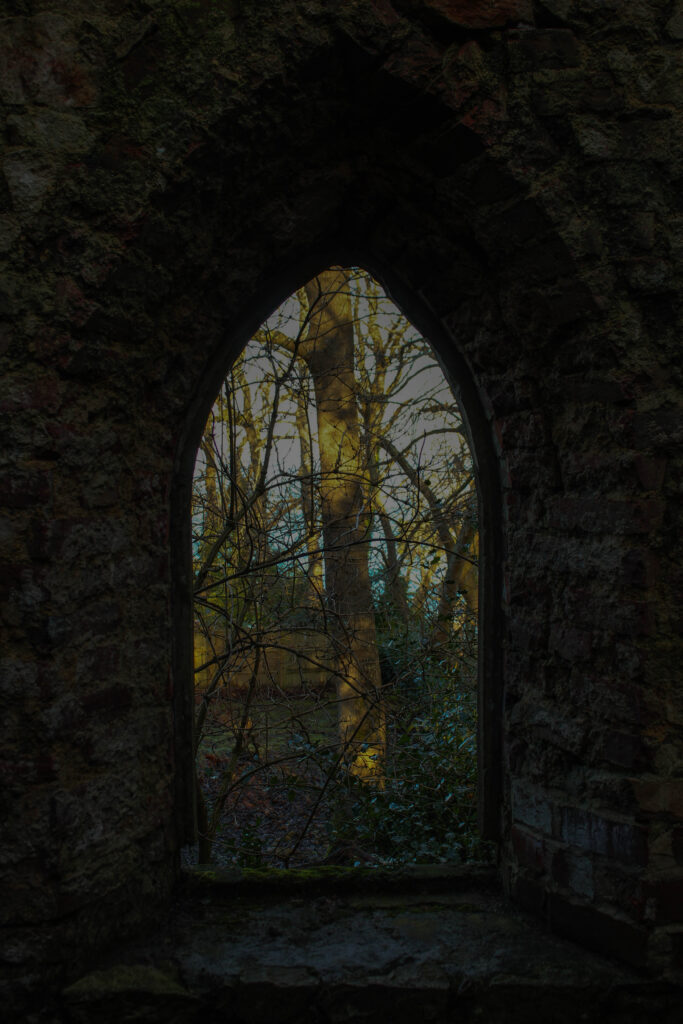
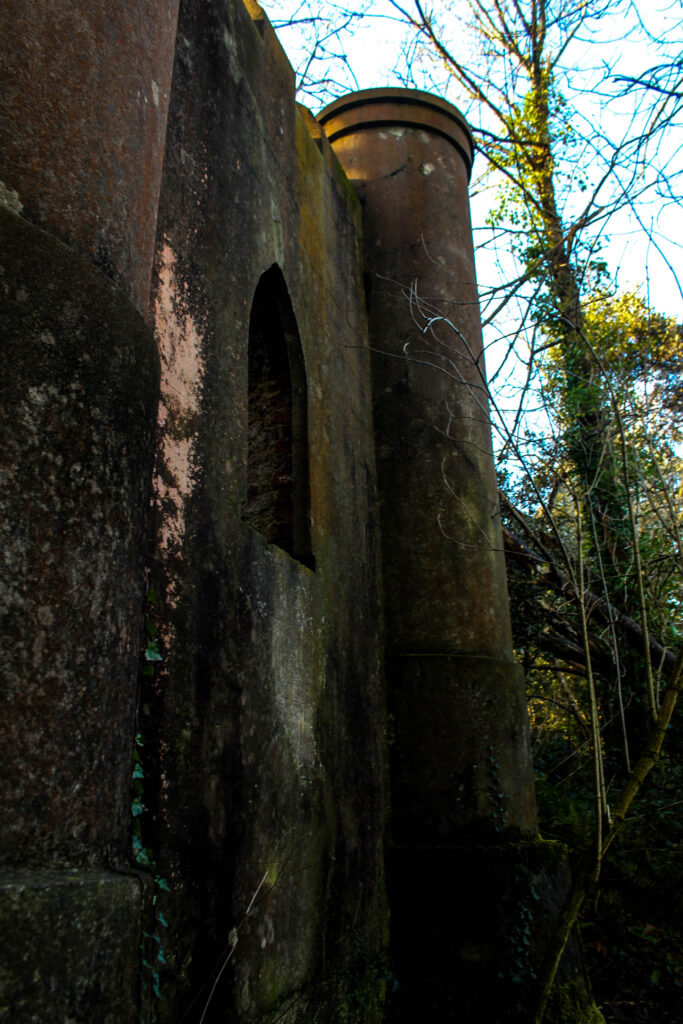
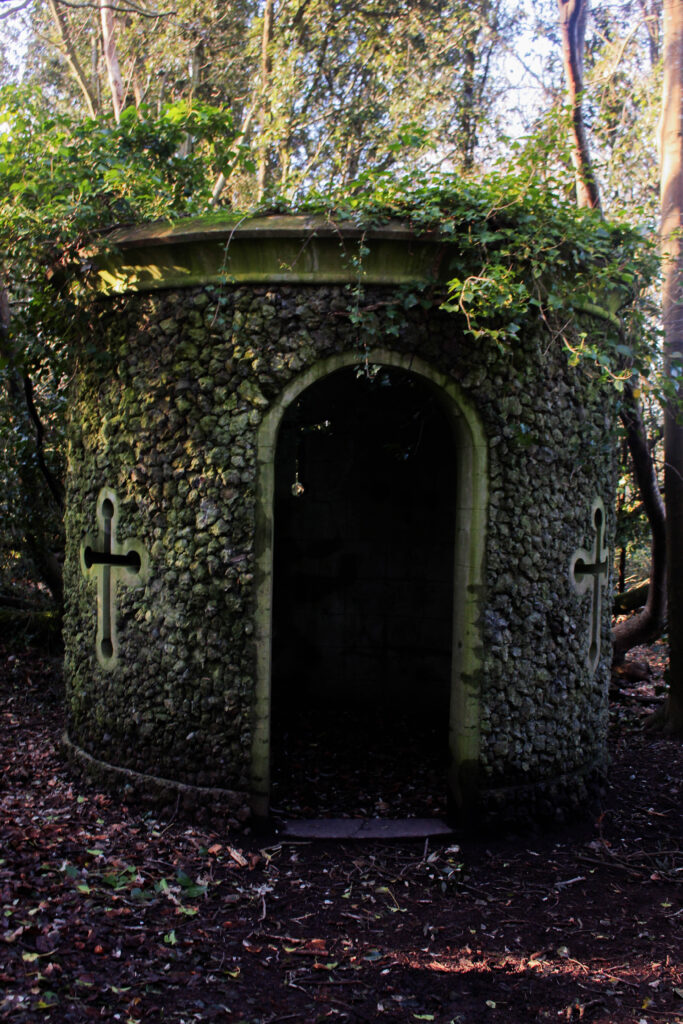
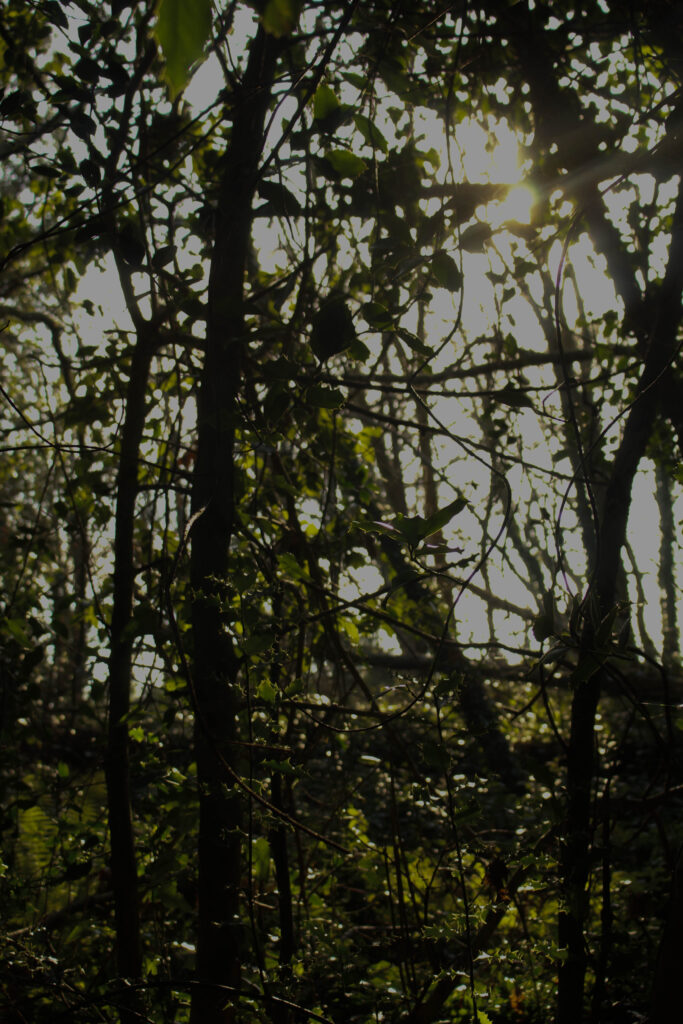
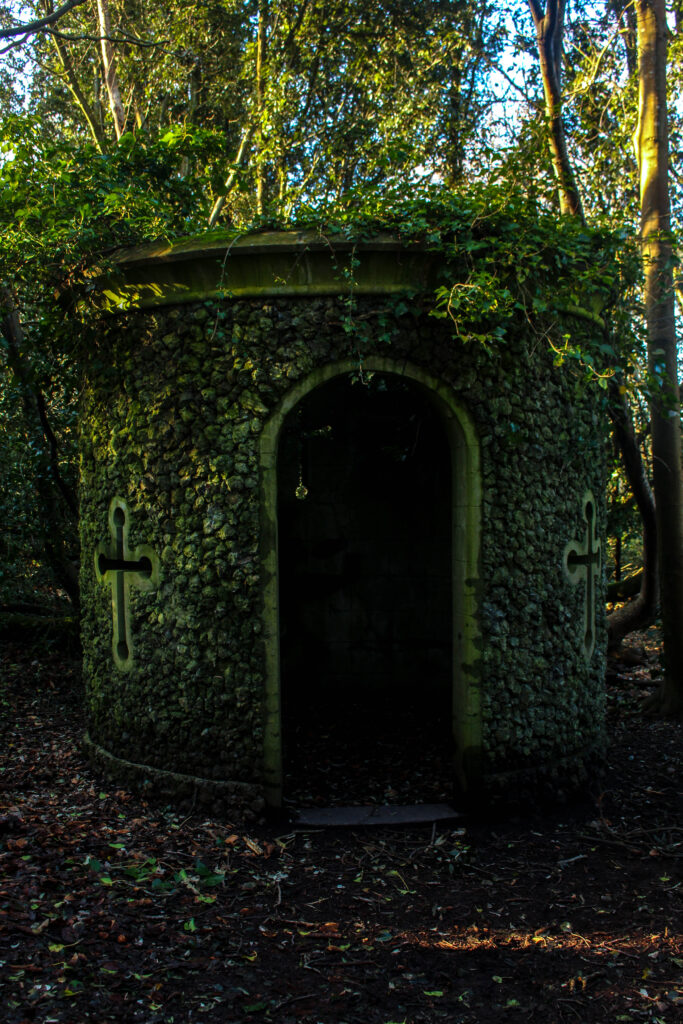
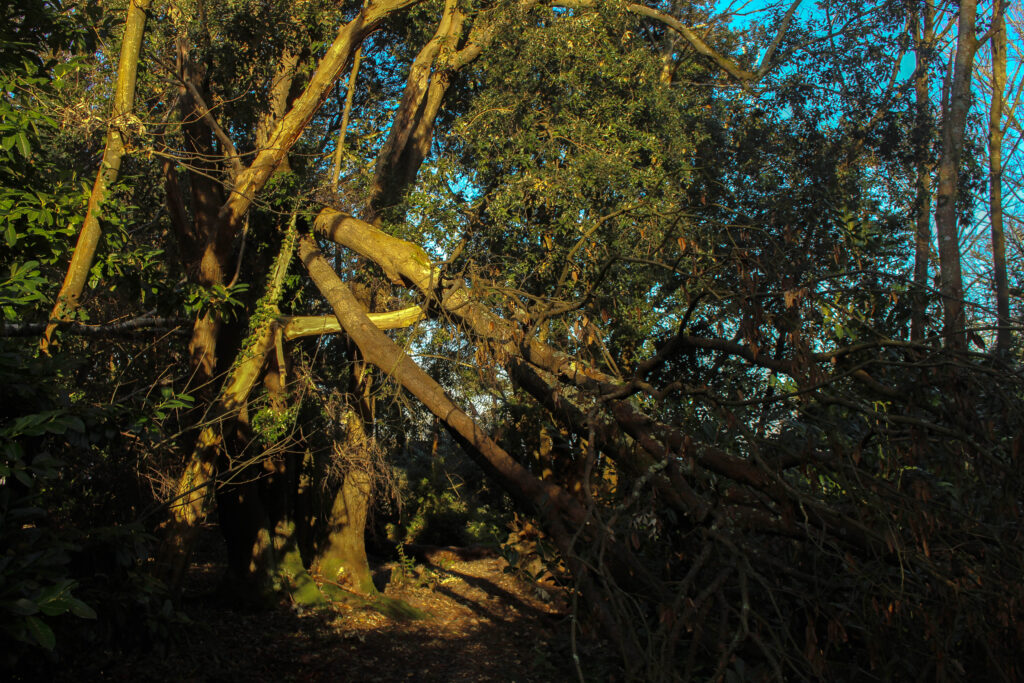
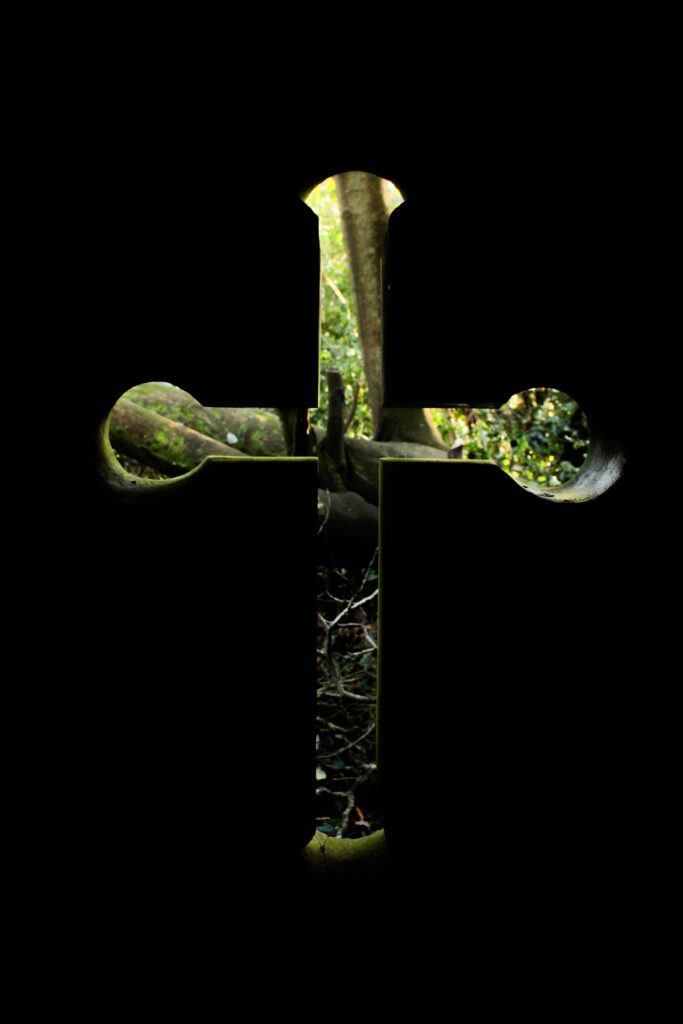
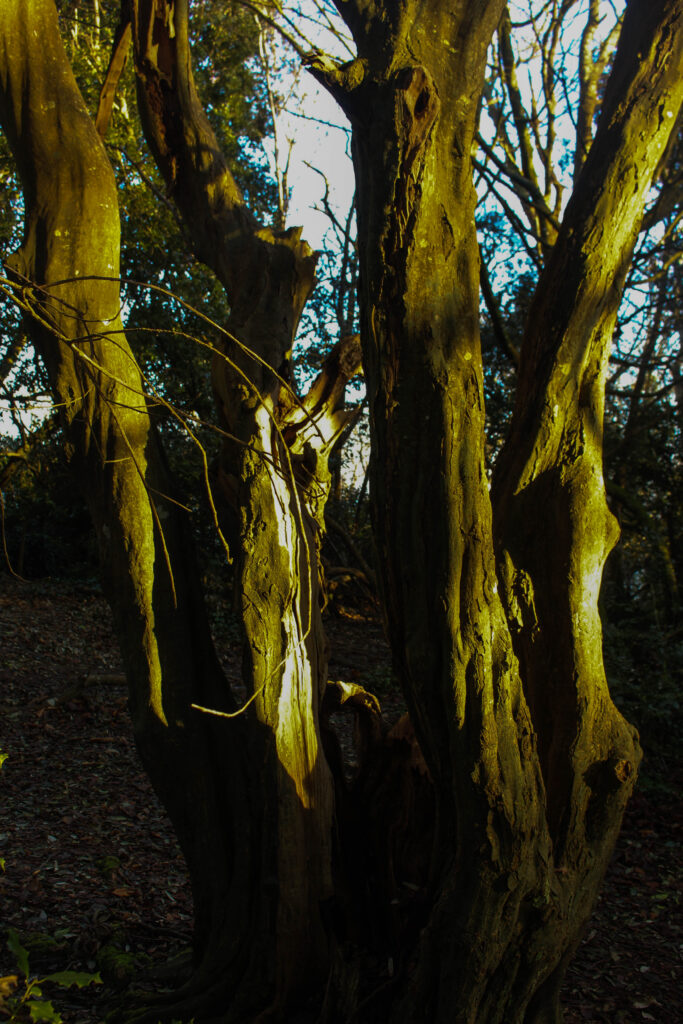
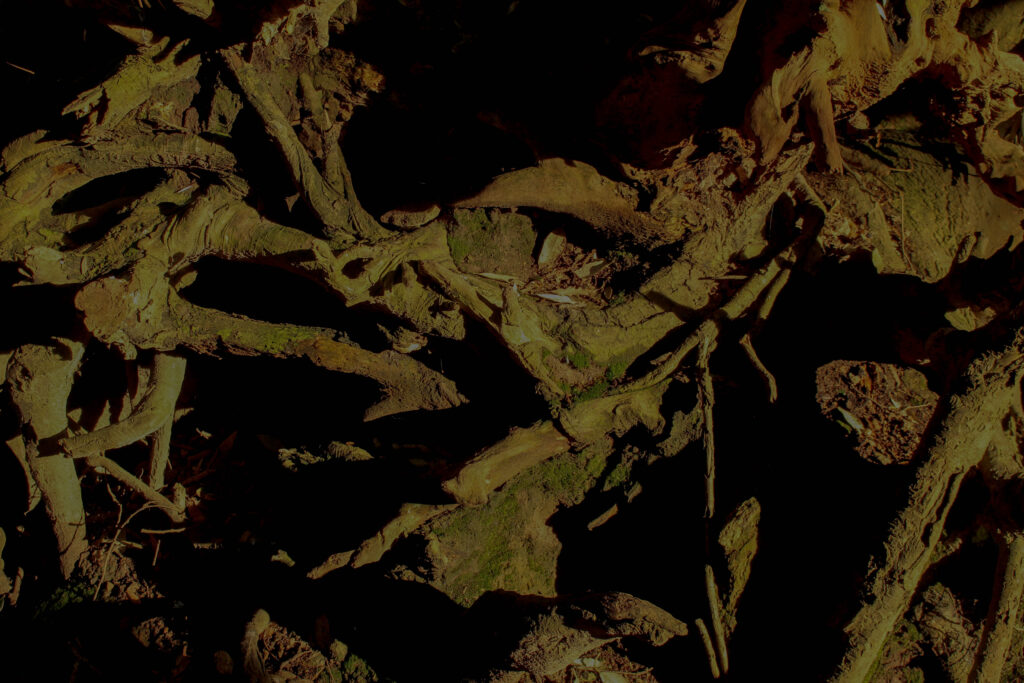
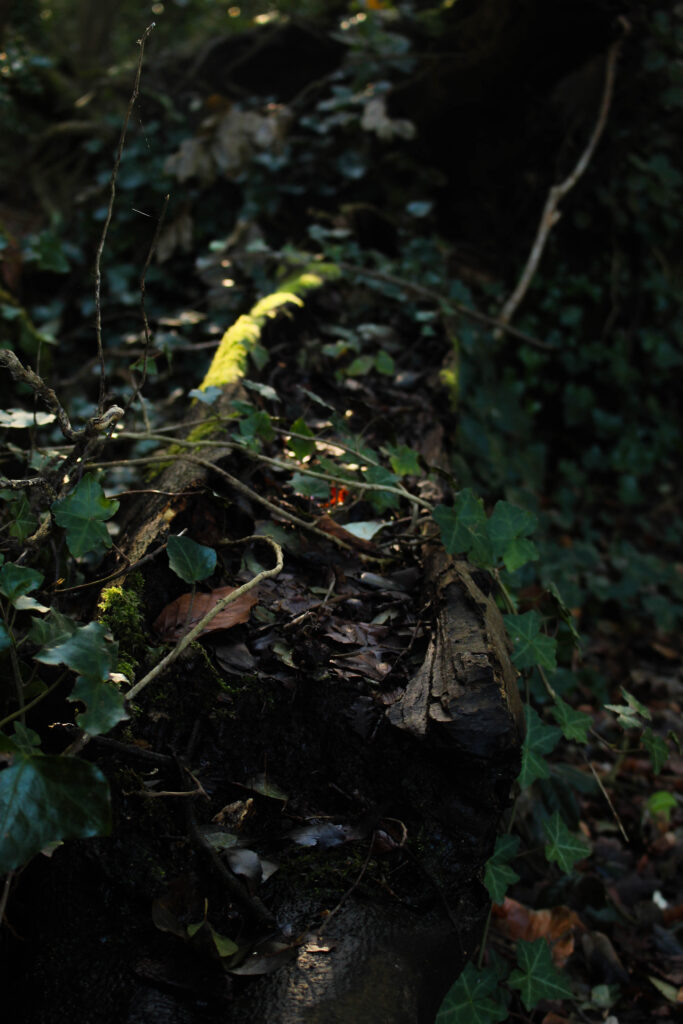
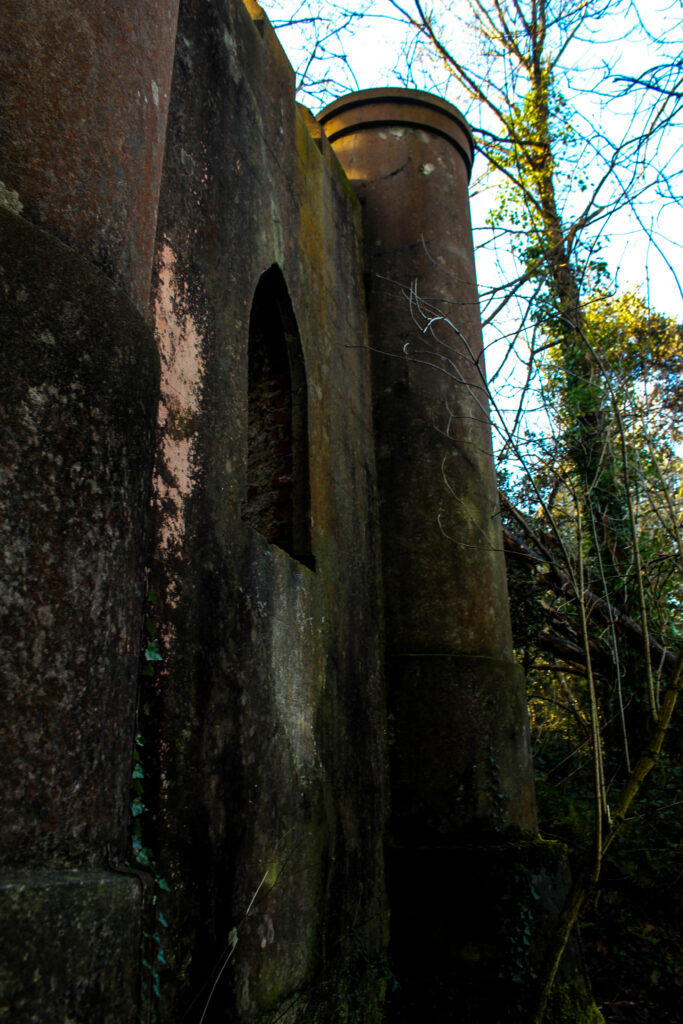
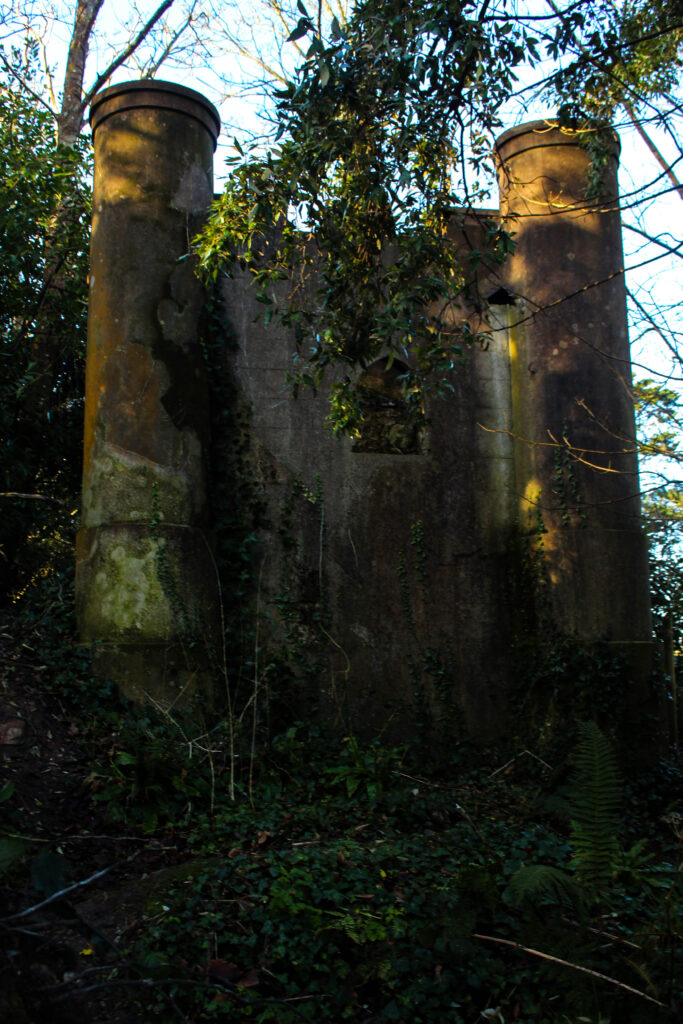
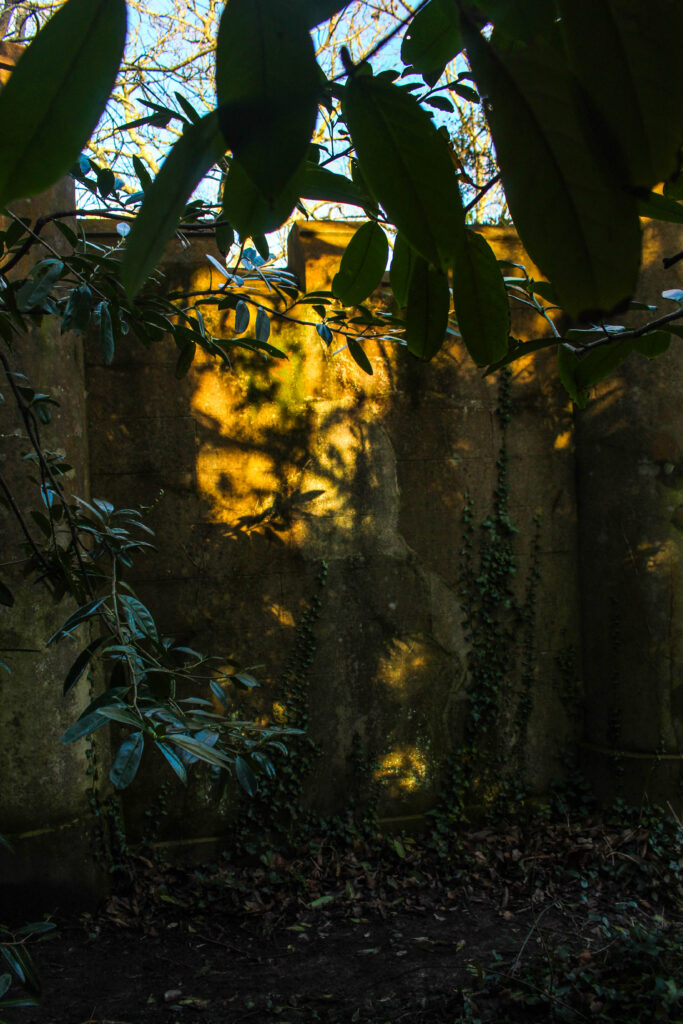
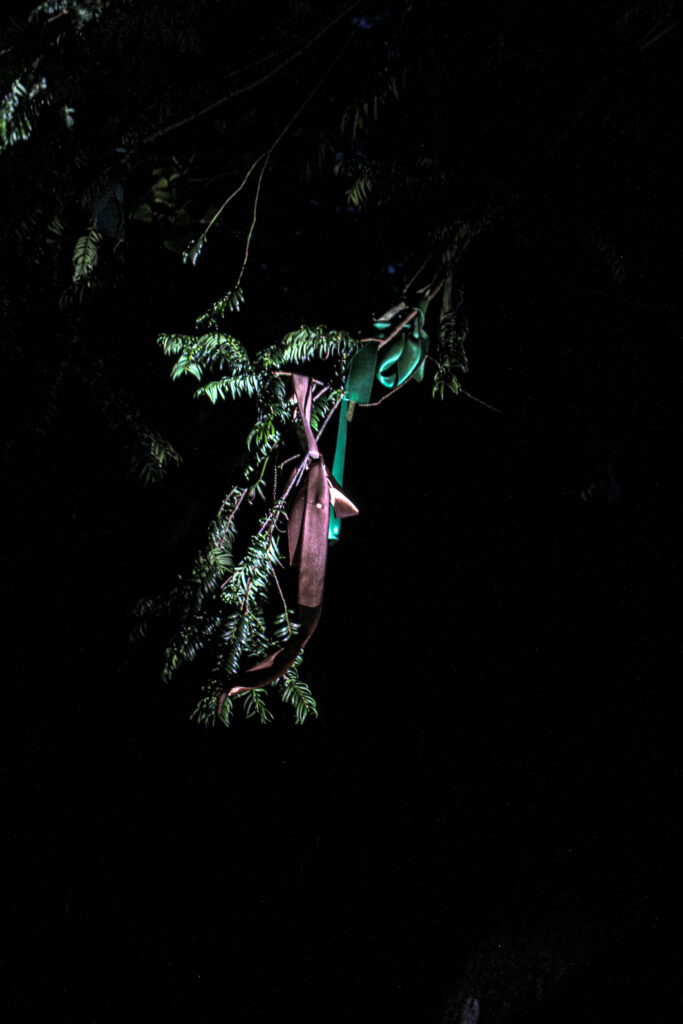
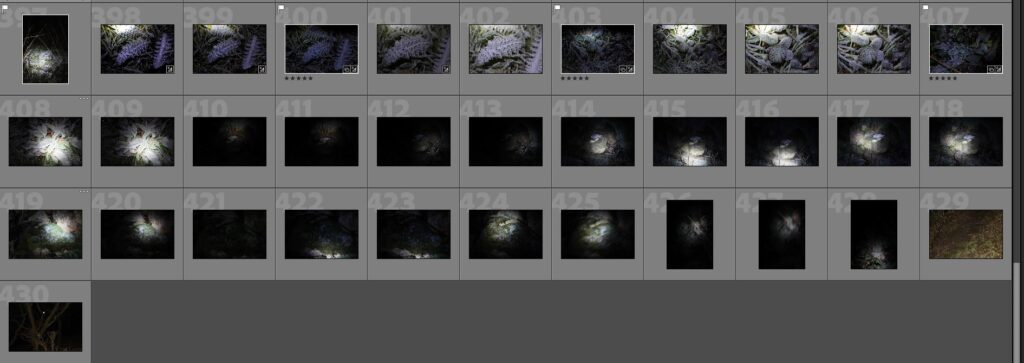
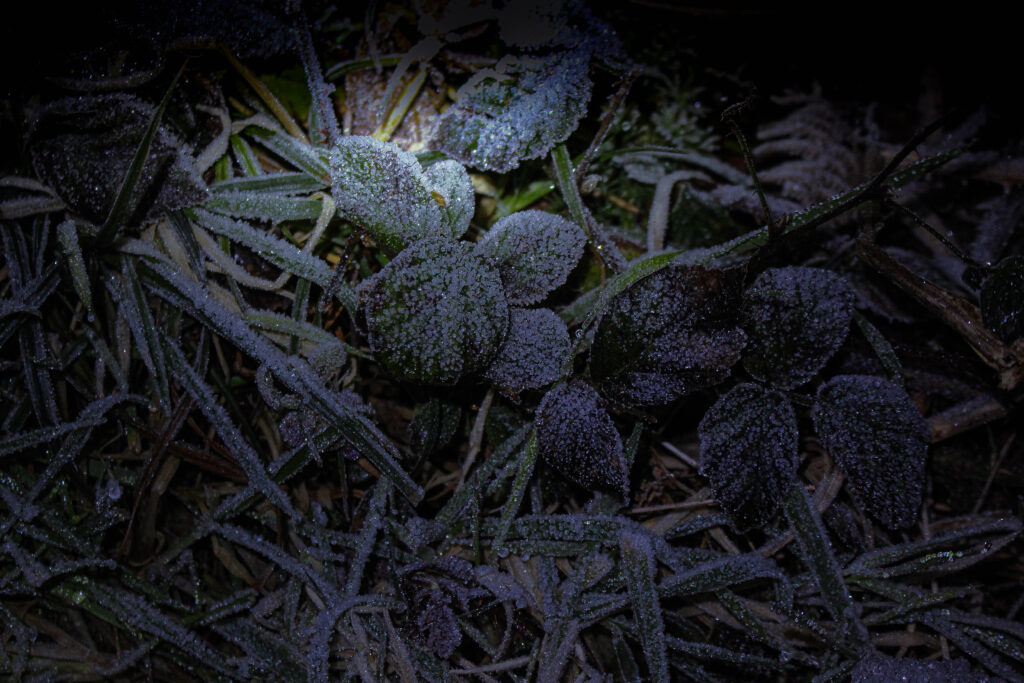


Introduction
Can truth and realism be shown through photography?
‘A photograph is a secret about a secret. The more it tells you, the less you know.’ Diane Arbus, 1971.
This quote captures photography’s power to tell a story but not the whole story, leaving some elements hidden. Photography is often seen as a way of capturing reality, but it raises a critical question which I will be addressing in this essay – can truth and reality be shown through photography? Truth is about accuracy in a specific moment or detail whereas reality includes the bigger picture. A photograph can capture a visual truth, or it may provoke thoughts as to what is really going on (the reality) or, more often, it can do both.
The reason I chose this theme came about from my background research in photography and practical experimentation with techniques. Also, photography’s ability to capture reality has long been debated and as I’ve grown up as a digital native, I wanted to add my perspective to it. Photography is a powerful method to document the world visually, which in turn, is used to further enhance human understanding of the world. But the fact that it is a physical or digital photograph means that decisions have already been made along the way to either increase or decrease its truthfulness. These decisions include the way photographers choose to frame their subjects, how they choose to edit, and the stories they want to convey, all of which converge to influence how the truth is captured and preserved. I am fascinated by how closely photography can document reality and also how modern photography techniques and technologies can undercover further truths, often in unexpected and surprising ways.
In this essay, I will explore the work of two influential photographers – Henri Cartier-Bresson and Jeff Wall. I will examine the context in which they worked and examine how each of them address the notion of truth and realism from their different positions of ‘spontaneous’ versus ‘staged’ images. I will demonstrate how their work influenced my work with my photograph series ‘Rise to Recovery’ showing an injured basketball player and how his truth can be accurately represented in staged photographs. By discussing the historical context of these photographers and by critically analysing their work, this essay will argue that whilst photography can preserve truth in an instant, it is still always ultimately shaped by the photographer’s own perspective and choices. The Guardian’s Points of View ad, (Guardian, 1986) demonstrates differing perspectives powerfully. A photograph cannot be as real as life itself, but is as close as it gets. Further, can it go beyond literal truths and provoke powerful emotional and deeper truths? Finally, this essay will discuss how photography in the digital age is assisting in uncovering previously unseen truths – adding a further perspective to the truth/reality debate.
Historical/Theoretical context
Photography, since its invention in the 1820s, was developed from scientific experimentation with early processes like the daguerreotype and the calotype. Once the ability to preserve long-lasting images was achieved, photography was viewed as the method to record real life with precision. Early photographers documented nature or scientific images, eg. the moon (Campbell, 2013), and soon photography evolved into an artistic method which reflected wider cultural movements. Realism of the 19th century documented ordinary life, highlighting poverty and injustice aiming for social reform. Works by Jacob Riis (1890) documented New York’s social housing and improved their conditions. In the 20th century, Modernism moved away from the gritty reality towards more subjective expression of life, and Henri Cartier-Bresson’s work is an example of this which will be examined in more detail later. By the mid 20th century, Postmodernism began to challenge photography’s claim to documenting truth. My second photographer Jeff Wall, staged seemingly spontaneous scenes, including ‘Mimic,’(Wall, 1982) shown in Image 1. Demonstrating how photography can manipulate reality very cleverly, as Wall recreated a moment of racial prejudice that he witnessed in Vancouver.
Demonstrating how photography can manipulate reality very cleverly, as Wall recreated a moment of racial prejudice that he witnessed in Vancouver.
This is particularly relevant to my question of how photography can depict truth and reality, because a photograph simultaneously records reality whilst also constructing a perspective of it. It’s a juxtaposition which I find fascinating, and I feel no other medium is capable of doing this better. The other layer to discuss regarding truth is the Digital Age – the way the photograph is viewed nowadays is key. Whereas photographs were originally physical items, most photographs are now viewed digitally though a screen (Growcoot, 2023), adding levels of complexity. Originally the route was photograph to eyes, but is now photograph to screen to eyes. We also know from debates online, for example the blue/black dress optical illusion photograph (Pearson, 2015), that viewers can receive and interpret the same image very differently (see Image 2).
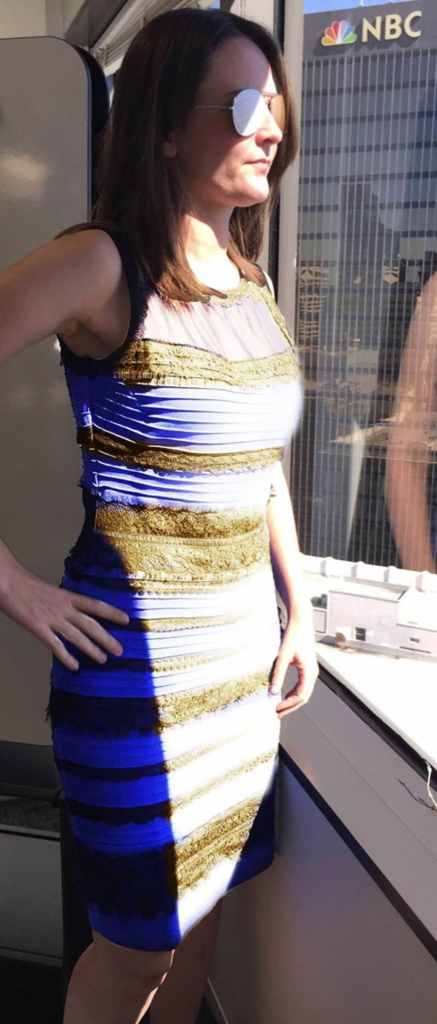
This means that whatever the photographer’s intention, there is no guarantee that their intension will be received the same. Similarly, we can now use science and special photography (x-rays, UV and infrared) to uncover hidden details in art and photography, as used by The Courtauld Institute in BBC’s Fake or Fortune programme. (BBC, n.d). Also, Metadata, can reveal the truth stored beneath a photograph to prove any manipulation. Truth therefore comes in layers – the immediate, the inferred and the uncovered. Truth and reality have many facets to explore, and in the next sections, will be analysed from two very different angles.
Henri Cartier-Bresson and the Decisive Moment.
Henri Cartier-Bresson’s idea of the ‘decisive moment’ is a central theme to his photography, and he is considered a pioneer of Photojournalism. The decisive moment is the exact moment when everything in a scene comes perfectly together to create an image that tells a complete story (Cartier-Bresson, 1952). His famous photograph ‘Behind the Gare Saint-Lazare’ (1932) shown in Image 3.
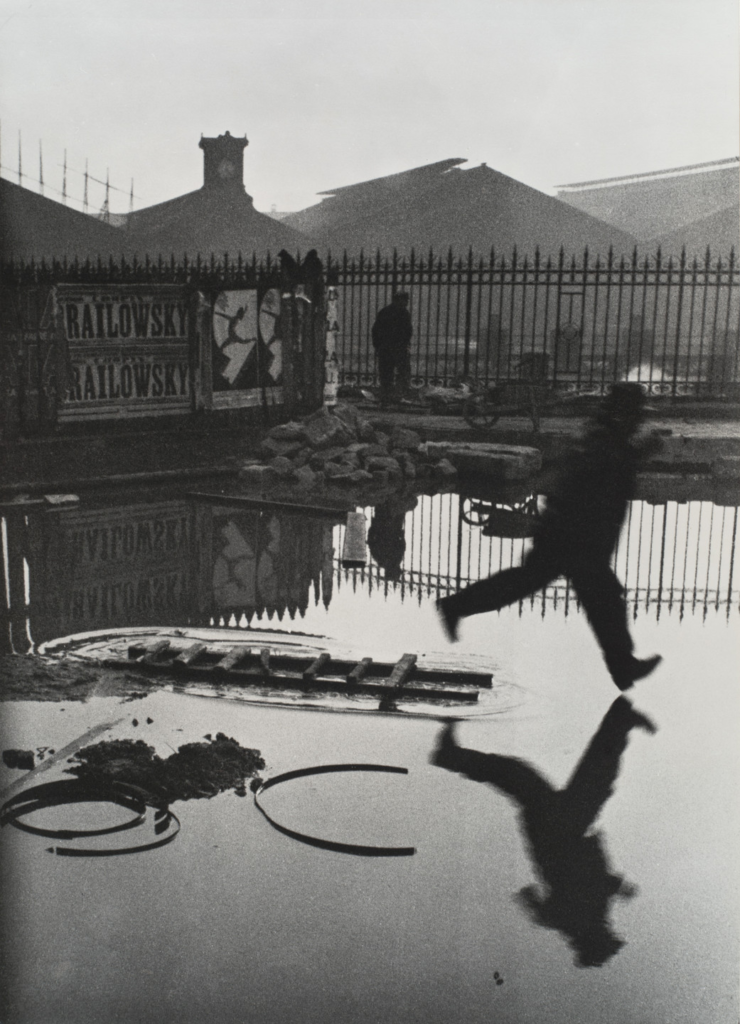
Captures a man mid-leap over a puddle with his reflection mirrored below, in black and white with an image of a leaping man on a poster in the distance. Cartier-Bresson showed life as is, with no interference from the photographer. Using a small, portable Leica camera, often strapped to his wrist, he was able to take photos quickly, remain unnoticed, capturing moments in their natural state. Roland Barthes observed in Camera Lucida (Barthes, 1981) that photographs show what ‘has been’ and this fits well with Cartier-Bresson’s images. However, some critics argue that his decisive moment is not as ‘real’ as it seems. Susan Sontag wrote that ‘to photograph is to frame, and to frame is to exclude’ (Sontag, 2003) which applies to Cartier-Bresson’s work. Even though his images look spontaneous and truthful, they are the result of careful planning, framing and waiting for the perfect shot, so showing only a partial reality from his interpretation. He himself seems to agree with Sontag’s view, demonstrated in his quote ‘There is a creative fraction of a second when you are taking a picture. Your eye must see a composition or an expression that life offers you, and you must know with intuition when to click the camera. This is the moment the photographer is creative.’ (Cartier-Bresson, 1957). Therefore, the creativity demonstrates that he knew his images are not real life but a carefully thought out decision of timing and framing. The photographer is deciding what part of the truth to capture and therefore it’s not objective reality.
In my own work, I was inspired by Cartier-Bresson’s focus on storytelling and composition, though I used staging not spontaneity. My photograph ‘Hoops, Shattered Dreams’ shown in image 4.
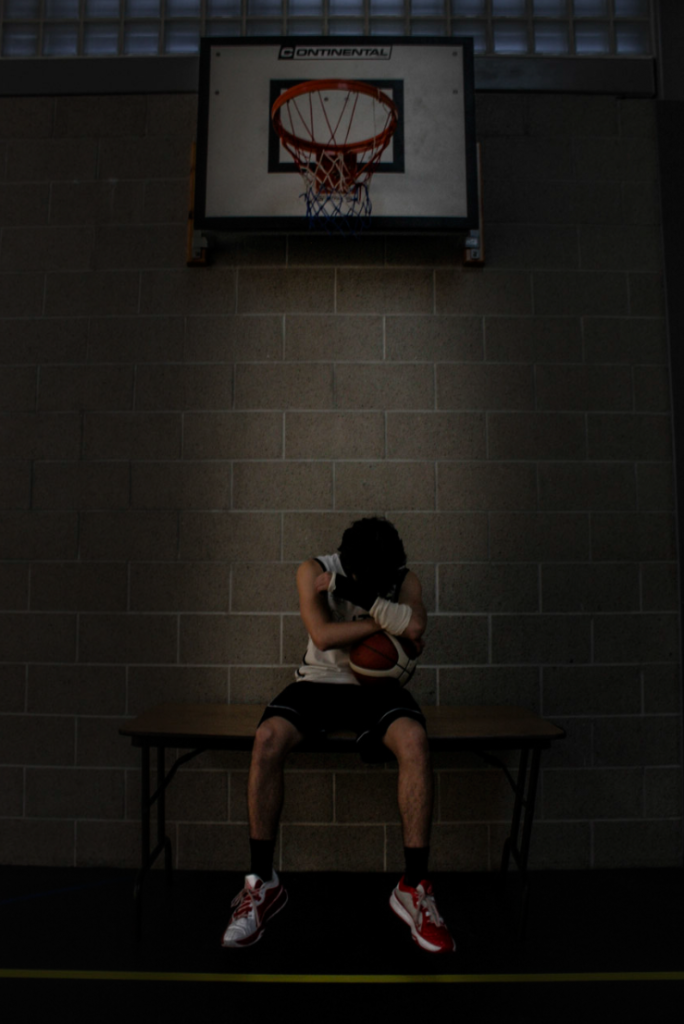
As part of my project ‘Rise to Recovery,’ shows an injured basketball player sitting alone under an unused hoop. I placed him deliberately against a dark wall emphasising his physical and emotional separation from the game. His head is bowed, a column of light highlights his body and his cast, covering his injured wrist. Whilst my scene is staged, it followed interviews with the subject to understand his story, and the photograph aims to reflect his emotional reality of isolation and frustration – still wanting to participate and feel included by wearing his team kit. This is much like the ‘decisive moment’ which captures the emotional core of a fleeting event, and like him, I used composition to focus the viewer’s attention and create a story within my chosen frame. Further inspired by Cartier-Bresson’s black and white imagery, I used Photoshop to turn my image black and white, darkening the edges and removing windows/light to increase the emotional impact. The resultant image ‘Isolation’ (Image 5).
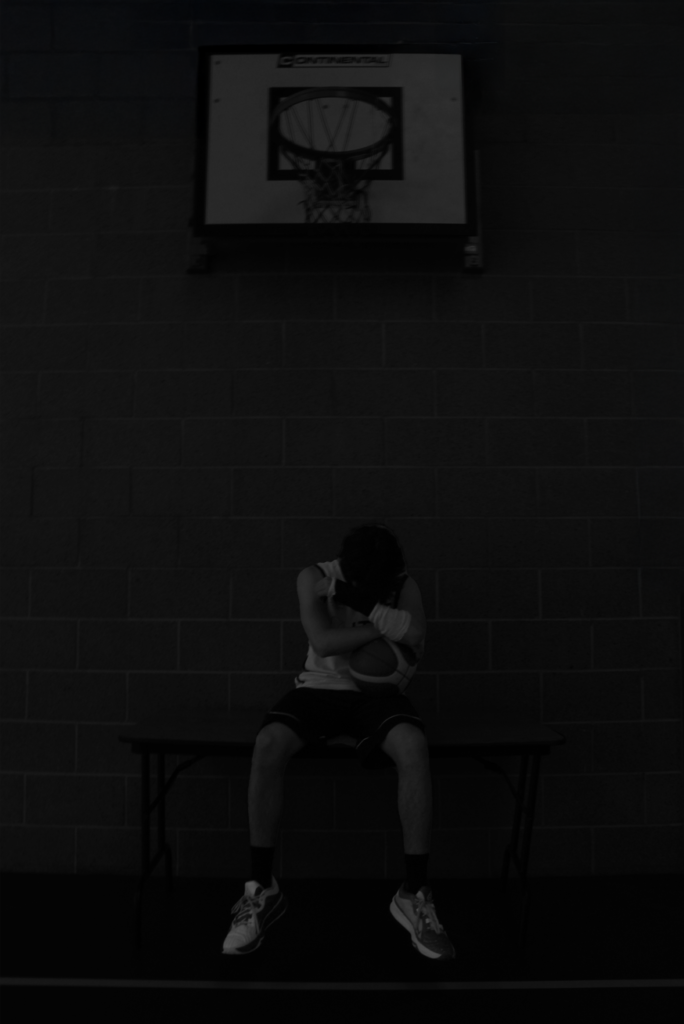
Evokes increased bleakness, further emphasising emotional truth rather than purely literal truth, confirming that there are levels of truth in photography. I will now explore a different approach to truth via my second photographer.
Jeff Wall and Staged Realism
Jeff Wall’s photography challenges traditional ideas of truth by meticulously staging scenes that feel real. He was known for large-scale images which often resembled cinematic stills or famous paintings, designed to create a deliberate tension between reality and construction. A famous example is ‘The Destroyed Room’ (Wall, 1978) shown in Image 6.
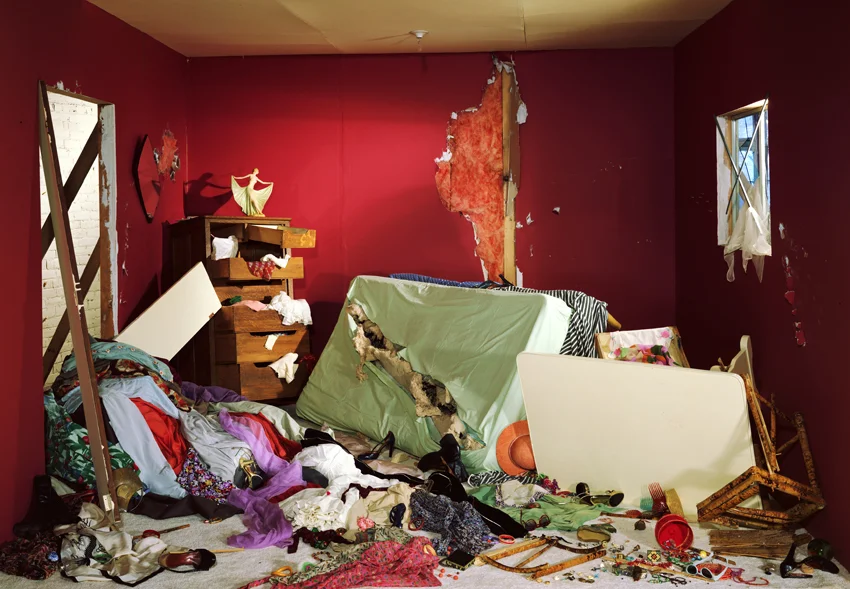
Which depicts a chaotic room with furniture overturned, ripped walls, as if a terrible event has occurred. But absolutely everything is staged, raising questions about whether constructed images can convey truth or not. Wall himself stated ‘What I am interested in is making images that remain truthful to the spirit of the time, even if they are invented’ (American Suburb X, 2020). This highlights his belief that truth can be emotional or conceptual, not just literal. He deliberately hid some items from view, for example behind the upturned mattress, encouraging the viewer to wonder what lies beneath.
A supporter of Wall, Art Historian Michael Fried argued in his book that Wall’s work ‘achieved a sense of realism…that conveys truth and realism through its detailed composition’ (Fried, 2008). Critics though, challenge the idea that staged photography can represent truth at all. John Berger noted ‘Every image embodies a way of seeing’ (Berger, 1972, p.10) suggesting that Wall’s images reflect his personal interpretation of reality rather than an objective view, therefore agreeing with Cartier-Bresson’s view earlier. Further, in an interview with Michael Schwander (Wall, 1994), Jeff Wall stated ‘In photography, there is always an actual moment – the moment the shutter is released. Photography is based in that sense of instantaneous.’ This view acknowledges that even in staged scenes, there is a finite moment when the button is pressed, which connects to the ‘decisive moment’ by Cartier-Bresson. Both acknowledge then that whether a scene is constructed or not, they are both linked by recording a real moment in time – a truth. Wall’s quote also implies like Cartier-Bresson did, that the specific truth captured is still dependent on photographer’s choice. So although this might distance his work from traditional documentary photography, we have already seen earlier how even this doesn’t show objective truth due to photographer’s choice and so it can be argued that Wall’s approach is still valid for reality.
Wall’s use of colour further enhances the emotional impact of his work. In ‘The Destroyed Room’ vibrant red tones dominate the scene to amplify the drama of destruction and draws the viewer’s eye across the chaotic scene. Wall’s strategic use of colour, with bright red in the middle, inspired me to experiment with strategic colour too. I was also reminded of the ‘Girl in the red dress’ from Schindler’s List, (2012) in Image 7.
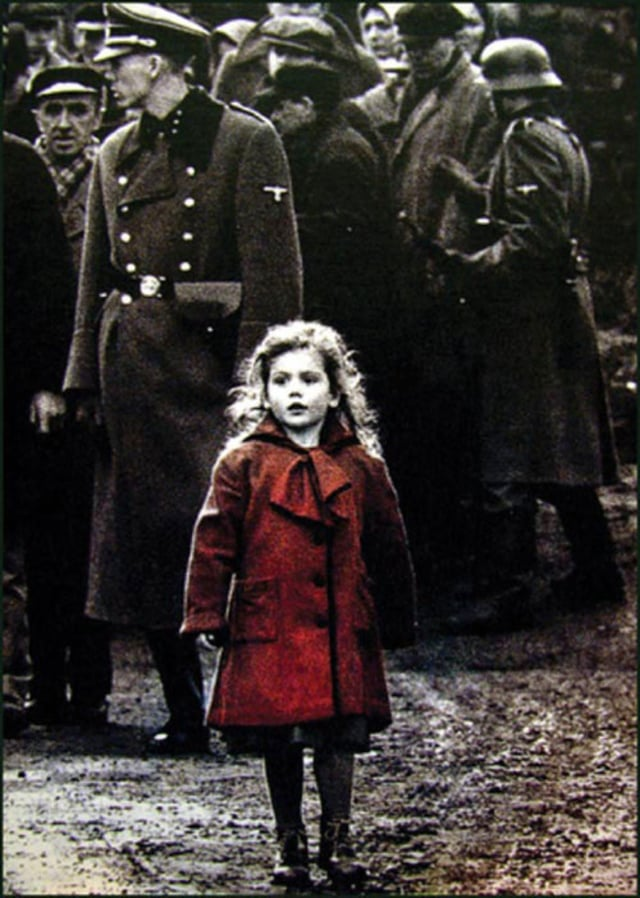
So, using the same red to depict pain, both emotional and physical, would be worth trying and this is shown in my Image 8, ‘Pain’.
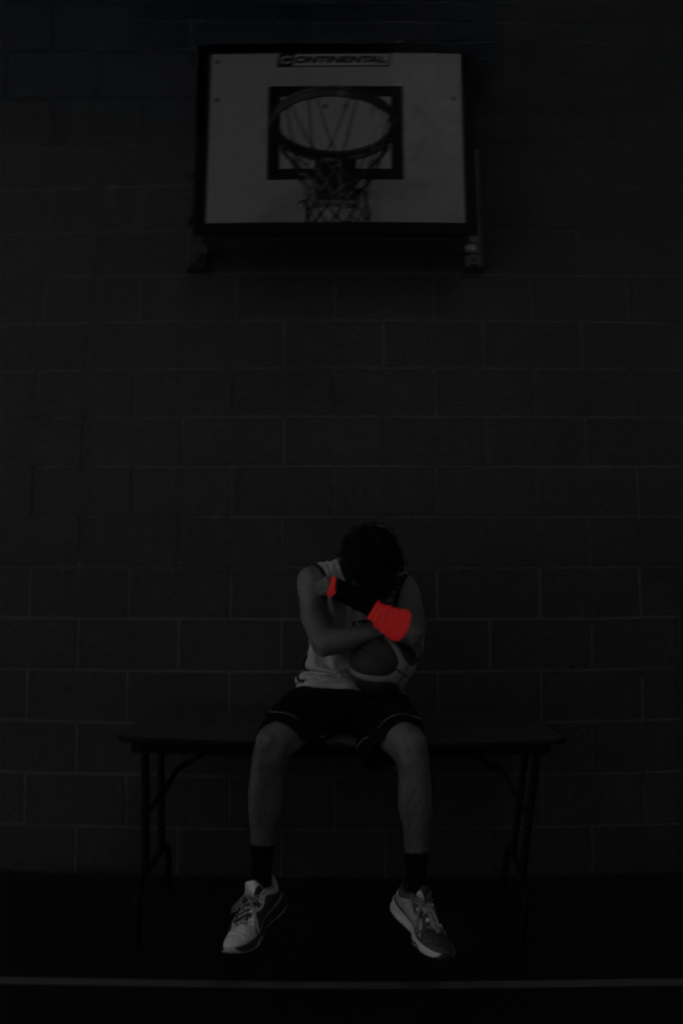
Like Wall, I used staging to explore emotional truths, layered over literal truths. Whilst his work often represents larger dramatic scenes, mine focused on the personal struggles of a single subject. I was inspired by Wall’s decision to hide elements and so my subject’s face and cast are deliberately hidden, masking his physical and emotional pain. Wall’s ability to combine meticulous construction with emotional depth has shaped my understanding of photography as a medium to go beyond documentation to reveal truths about human experiences. Like Wall, I aim to create images that feel authentic in their emotional content, even though they are constructed. The next section examines technological advances adding and uncovering truth in photography in ways that have never been achieved before.
The Digital Age
The rise of digital photography, editing tools and metadata has further transformed the relationship between truth and realism. Photography is no longer limited to capturing only what is in front of the camera, as tools like Photoshop and Lightroom allow photographers to manipulate images as they decide. This has given rise to questions about how authentic certain images are (Bardis, 2004).
In my own work, digital editing played a key role in enhancing the emotional impact of my photographs and I tried multiple approaches – the red cast, use of shadows, brightness, contrast and black and white versions. At one point, I accidentally inverted one of my images during editing, which suddenly revealed a new perspective (Image 8).
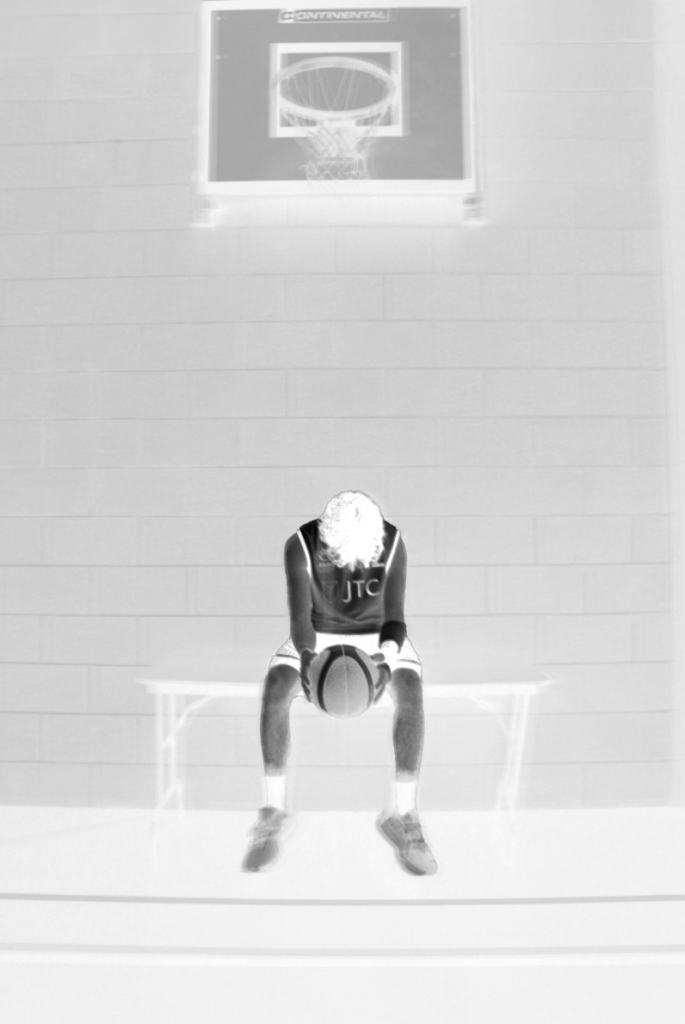
It showed unexpected details, such as the logo on the player’s jersey. This happy accident called ‘Inverted’ added depth to the image and became an integral part of my project, demonstrating how digital tools can uncover hidden layers of meaning, even with unintended consequences. My subject recovered from his injury and I took inspiration from Cartier-Bresson’s ‘Behind the Gare Saint-Lazare’ (1932) by photographing my subject mid-leap rising to the hoop. I combined this with the Inverted filter to achieve my resulting image ‘Hoops, Ascend’ (Image 10) set alongside Image 3 for comparison.
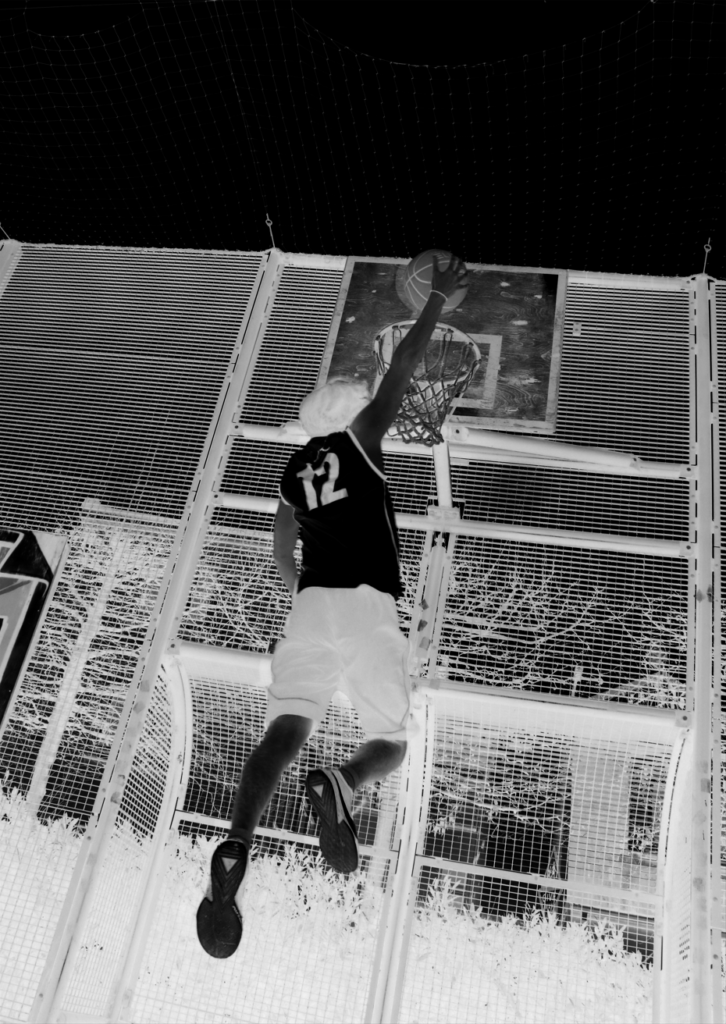

However, just as digital tools can unveil truth, the ease of digital manipulation challenges the viewer’s trust in photography overall. As Sontag noted, (Sontag, 1997) photography’s power lies in its perceived connection to reality, but digital editing blurs the line between truth and lies. Metadata (Image 11).
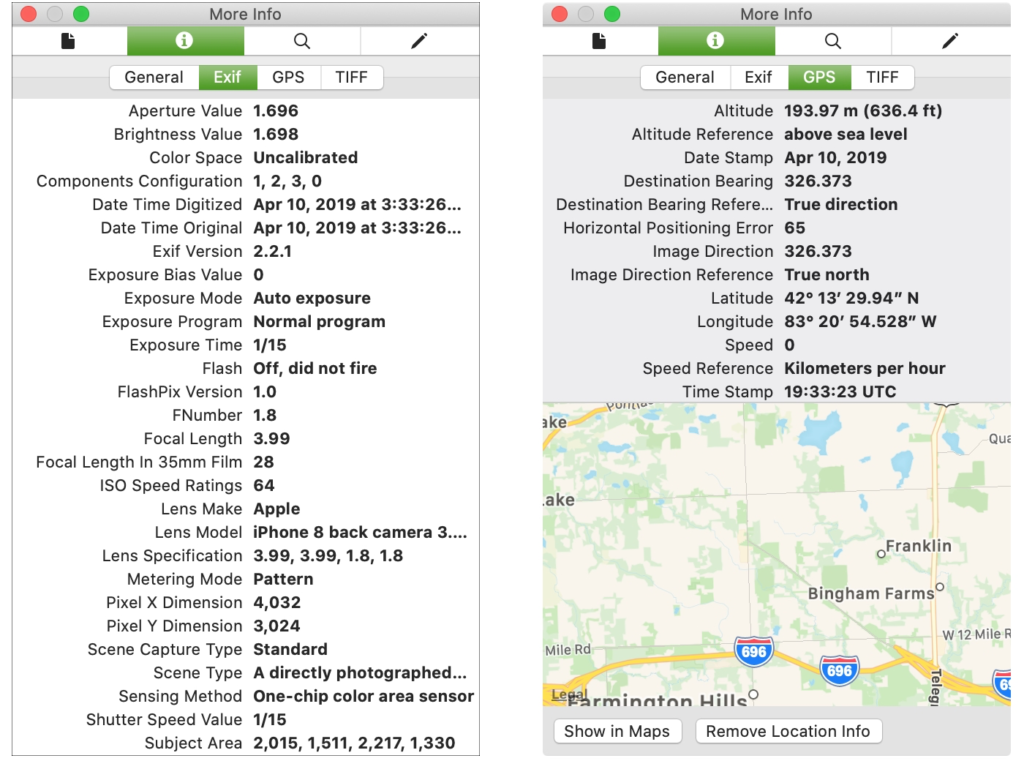
Which records details about how an image was captured and edited, offers one way to maintain transparency in digital photography. Therefore, truth can be challenged but with metadata, it can be confirmed.
I played with the idea of obvious untruths in ‘Twelve, Back,’ (Image 12).
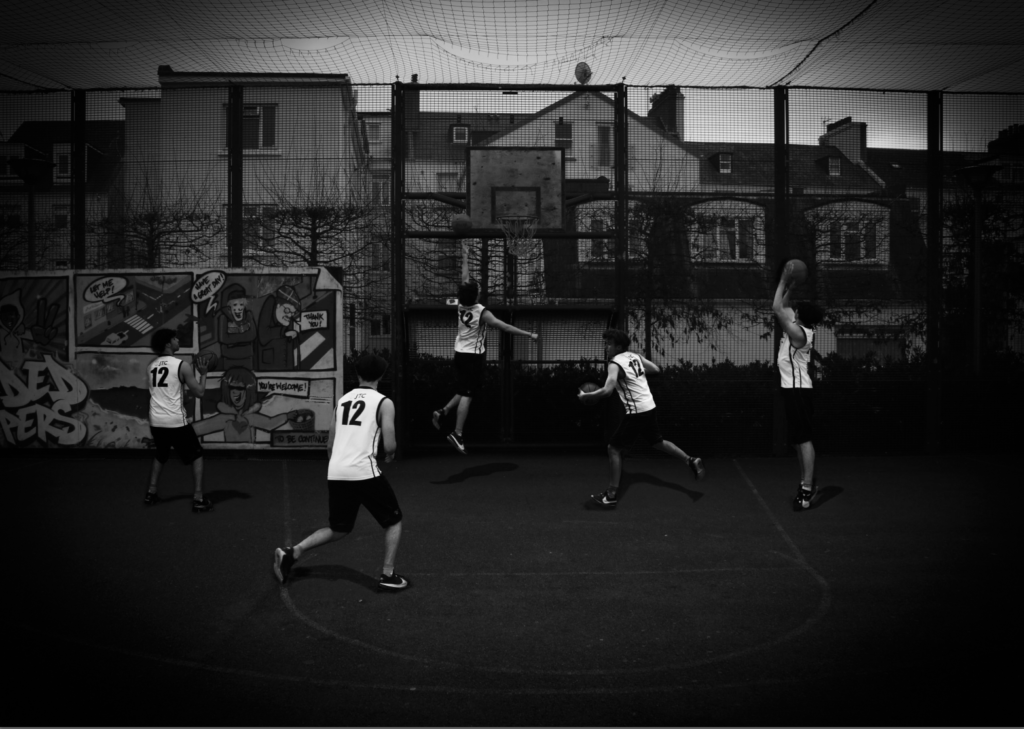
Which combined elements of both photographers’ work. I staged an outdoor scene, with a tripod stood at the top of the court, to capture multiple action shots of him in various positions. Like Cartier-Bresson’s photography experience, I am also an experienced basketball player so I used this to my advantage by anticipating the ‘decisive moment’ shot. Using Photoshop, I then layered multiple cutouts of him over one image, increasing the brightness of his number 12 jerseys and creating shadows underneath to increase the realism. This photograph is a definite record of his emotional and physical truth, but as it’s clearly the same subject in five different positions, it can’t possibly be real. Even so, it may not be real in the image, but it demonstrates that to him, it’s his reality, and he’s back.
Conclusion
During my investigation, I set out to determine whether truth and reality can be shown in photography. My hypothesis was that while photography can show and preserve truth in an instant, it is ultimately shaped by the photographer’s own choices and perspective so cannot capture reality. After research and analysis of two prominent photographers Henri Cartier-Bresson and Jeff Wall, I found that whilst photography can capture the truth, it can never be objective, which confirms my hypothesis. In Cartier-Bresson’s decisive moment approach seen in Behind the Gare Saint-Lazare, this image feels very real and authentic due to its unposed spontaneity. Yet, he still chose what to frame, exclude and include, and when to press, confirmed by his own thoughts on photographer creativity. Jeff Wall’s approach whilst different, by planning, staging and recreating scenes, challenged the idea of reality yet his images still feel true. He also acknowledged photographer choice and the finite moment of pressing the shutter, in agreement with Cartier-Bresson.
My perspective changed throughout my study, as I initially believed only spontaneous shots were truthful. I now realise that staged photography also shows realism, sharing many similarities with the spontaneous approach, as both are still subjective, therefore one method is not more ‘real’ than the other. I also discovered much more, including that truth and reality has layers. I initially believed photography could only show literal truth but I demonstrated that photographs can convey deep, emotional truths and like my injured player, can capture his reality, even if staged. Therefore photography can show reality, just not the literal reality I originally expected. I was influenced to try new techniques, from colourisation (Image 8).

To digital editing to increase the emotional truth of a scene effectively (Image 12).

Through to my favourite image, ‘Inverted’ in Image 9.

Which reveals hidden elements. Image 8 didn’t work as well as I wanted so I will experiment further with the red colour/shading. My images were mainly focused on the subject, I’d like to try shots from what he sees eg. looking up through the hoop. I discovered metadata stored in digital photographs to prove or disprove its truth, and together with modern scientific techniques, is helping to uncover factual truths.
I only analysed two photographers and so there are more photographers and techniques to consider for future studies. There is also the angle of the viewer and social media – I touched on it in this essay regarding the modern screen-use, potentially changing what each viewer sees, interprets and shares and this could be investigated further to determine if viewers receive what the photographer intended.
Finally, whether through spontaneous moments, staged scenes, or through digitally-enhanced images, photography has the power to tell a story and get as close to the truth and reality as any medium. Diane Arbus’ quote at the start suggested that photography’s secrets lie not just in what it shows, but in what it leaves hidden, and this essay proved this to be the case, with photographer creativity always making that choice.
Image 1.
‘Mimic (1982)’ Jeff Wall.

Image 2.
‘Photo finally solves the black and blue/white and gold dress debate (2015)’ Nick Pearson.

Image 3.
‘Behind the Gare Saint-Lazare (1932)‘ Henri Cartier-Bresson.

Image 4.
‘Hoops, Shattered Dreams (2024)’ Tommy Little.

Image 5.
‘Isolation (2024)’ Tommy Little.

Image 6.
‘The Destroyed Room (1978)’ Jeff Wall.

Image 7.
‘Girl in Red Symbolism (2012)’ Schindler’s List.

Image 8.
‘Pain (2024)’ Tommy Little.

Image 9.
‘Inverted (2025)’ Tommy Little.

Image 3&10.
‘Behind the Gare Saint-Lazare (1932)‘ Henri Cartier-Bresson.
‘Hoops, Ascend (2025)’ Tommy Little.


Image 11.
‘Metadata Forensics (2024)’ Ironhack Blog.

Image 12.
‘Twelve, Back (2025)’ Tommy Little

amer4127 (2020) Evocations of the everyday: The street pictures of jeff wall (2009), AMERICAN SUBURB X. Available at: https://americansuburbx.com/2016/06/evocations-of-the-everyday-the-street-pictures-of-jeff-wall-2009.html (Accessed: 27 January 2025).
Arbus, D. (1971), quoted in Smithsonian Magazine (2018) A Window into the World of Diane Arbus. Available at: https://www.smithsonianmag.com/smithsonian-institution/window-world-diane-arbus-180968861/ (Accessed: 25 January 2025).
Bardis, A. (2004) ‘Digital photography and the question of realism’, Journal of Visual Art Practice, 3(3), pp. 209–218. doi: 10.1386/jvap.3.3.209/0.
Barthes, R. (1981) Camera Lucida: Reflections on Photography. Translated by R. Howard. New York: Hill and Wang, p. 85.
BBC One. (no date) Fake or fortune?, could a painting described as ‘in the style of sir Joshua Reynolds’ have something murkier lurking beneath the paint? (no date) BBC One. Available at: https://www.bbc.co.uk/programmes/p0gj6sh3 (Accessed: 25 January 2025).
Berger, J. (1972) Ways of Seeing. London: BBC and Penguin Books, p.10
Campbell, E.F. (2013) The first photograph of the Moon, Time. Available at: https://time.com/3805947/the-first-photograph-of-the-moon/ (Accessed: 29 January 2025).
Cartier-Bresson, H. (1952) The Decisive Moment. New York: Simon & Schuster.
Cartier-Bresson, H. (1957) ‘Photography is not like painting’, The Washington Post, 10 November.
Fried, M. (2008) Why Photography Matters as Art as Never Before. New Haven: Yale University Press.
Growcoot, M. (2023) Almost all photos are now taken on smartphones, according to study, PetaPixel. Available at: https://petapixel.com/2023/06/20/almost-all-photos-are-now-taken-on-smartphones-according-to-study/ (Accessed: 23 January 2025).
Guardian ad 1986 – Points of View advert – YouTube.
YouTube. Available at: https://www.youtube.com/watch?v=_SsccRkLLzU (Accessed: 25 January 2025).
Henri Cartier-Bresson. behind the Gare St. Lazare. 1932 | moma. Available at: https://www.moma.org/collection/works/98333 (Accessed: 25 January 2025).
Jeff Wall, ‘Jeff Wall interviewed by Martin Schwander’, Jeff Wall, Restoration [Kunstmuseam Luzern and. Kunsthalle Dusseldorf, 1994]. 22-30.
Jeff Wall,
Mimic. (1982)
Transparency in Lightbox. 198x229cm [78x90in].
Collection, Odessa Hendeles Art Foundation, Toronto.
Metadata forensics: Uncovering hidden truths in digital files (2024) Metadata Forensics: Uncovering Hidden Truths in Digital Files | Ironhack Blog. Available at: https://www.ironhack.com/us/blog/metadata-forensics-when-files-can-speak-and-reveal-the-truth (Accessed: 25 January 2025).
Modern classics: Jeff Wall – the destroyed room, 1978 (2021) artlead. Available at: https://artlead.net/journal/modern-classics-jeff-wall-destroyed-room-1978/ (Accessed: 25 January 2025).
Pearson, N. (2015) Photo finally solves the black and blue/white and gold dress debate, 9News. Available at: https://www.9news.com.au/world/photo-finally-solves-the-black-and-blue-white-and-gold-dress-debate/15465485-dad8-45d2-8da0-8d20558b5013 (Accessed: 25 January 2025).
Riis, J. (1890) How the other half lives, by Jacob Riis (1890) How The Other Half Lives, by Jacob Riis: Available at: https://www.historyonthenet.com/authentichistory/1898-1913/2-progressivism/2-riis/index.html (Accessed: 23 January 2025).
Scharf, A. Henri Cartier-Bresson, Encyclopœdia Britannica. Available at: https://www.britannica.com/biography/Henri-Cartier-Bresson (Accessed: 24 January 2025).
Sontag, S. (2003) Regarding the Pain of Others. New York: Farrar, Straus and Giroux, p. 46.
Sontag, S. (1997) On Photography. New York: Farrar, Straus and Giroux.
The girl in red symbolism (2012) Schindler’s List. Available at: https://schindlerslisteight.wordpress.com/character-analysis/the-girl-in-red-symbolism/ (Accessed: 25 January 2025).
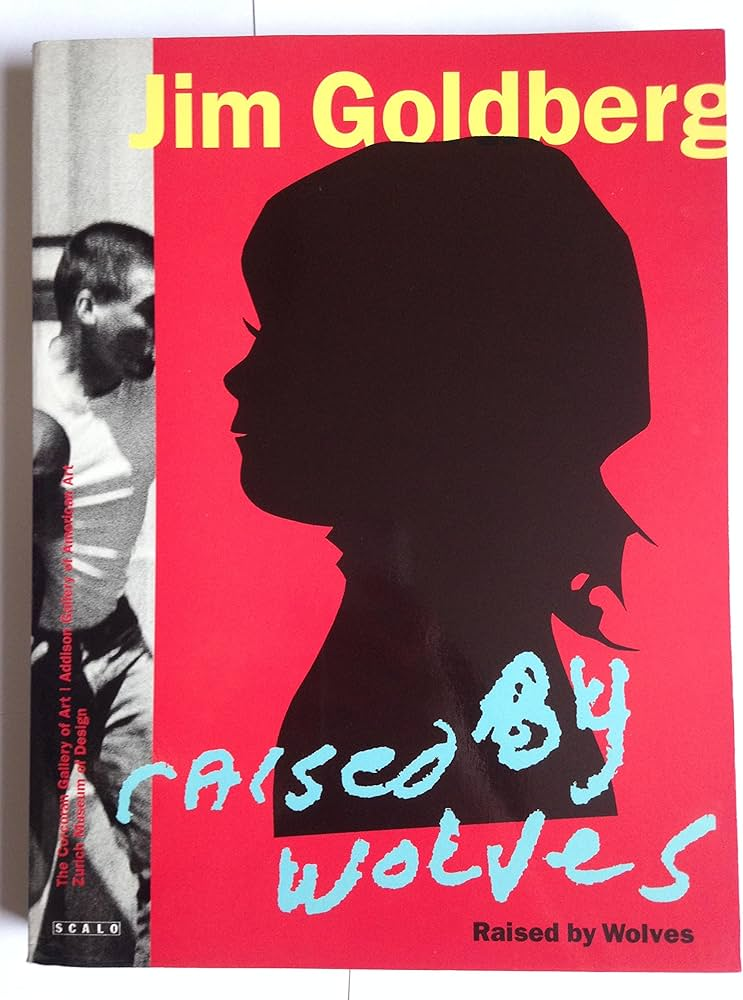
1. Research a photo-book and describe the story it is communicating with reference to subject-matter, genre and approach to image-making.
Jim Goldberg – raised by wolves
This book is about shedding light on kids without giving them labels like ” victims of abuse” or “drug addicts”, by people trying to classify them into neat groups. This book follows two “main” figures, Echo and Tweedy Dave, where there story is told without being “edited” or “manipulated” to fit with what the readers want. It contains mostly archives of Goldberg’s polaroid’s, and a few pages with interviews by the figures in the books, as well as notes and comments from Goldberg.
“when I thought of youth, I thought of my own teenagehood and childhood, and other people I knew who were often scapegoated, not appreciated, or not given a chance. The end result was trouble for them. I wanted to look at those people who were outsiders, like I felt I was.”
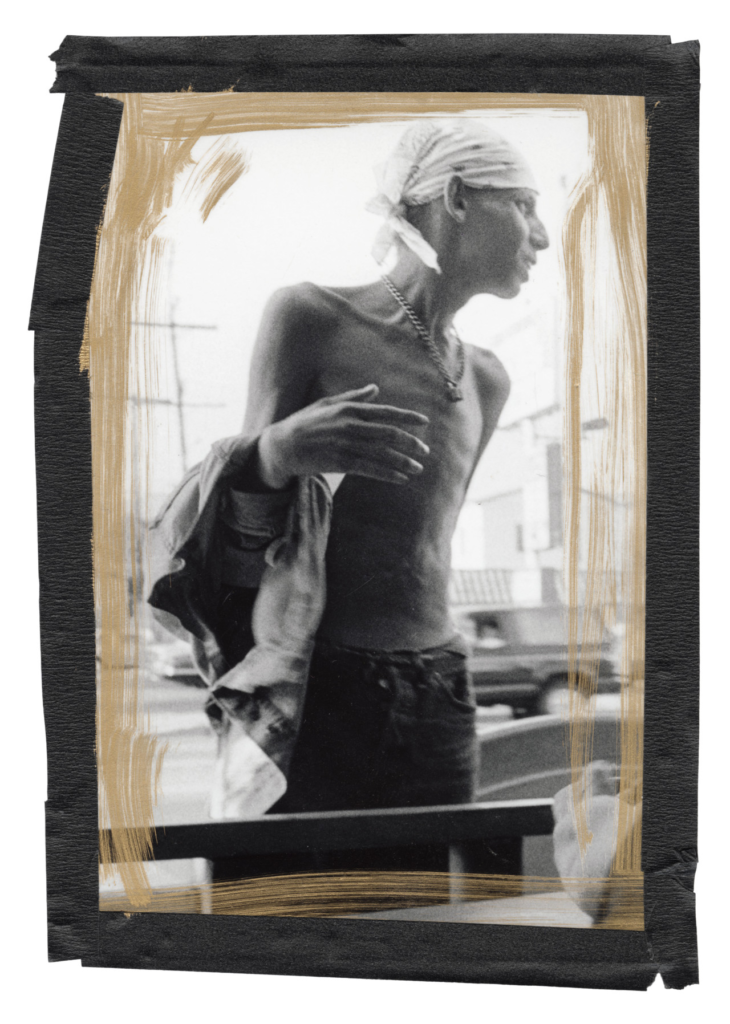
The photos are taken around the California streets, from Hollywood up to San Francisco and back. Many of the figures in the books start out fairly well, but as the book progresses, they slowly determinate and fall into bad habits. There is a lot of drugs and prostitution making it a very emotional book as it shows the difficulties of youth homelessness.
For the image making, he often took a abstract approach, with blurred and B&W images, or close ups of certain people, places or object that help add emotion or explain the story.
2. Who is the photographer? Why did he/she make it? (intentions/ reasons) Who is it for? (audience) How was it received? (any press, reviews, awards, legacy etc.)
Jim Goldberg’s reasons for creating this was to tell a story of kids in various Californian areas over a 11 year period of interviews and photos. It’s also partial, rearranged, taken out of context, romanticized, subjective, and, therefore is as much about Goldberg’s making of the project as it is about the kids. I think the main audience is for other photographers and people who have the money to spend on a book like this.
ZHodl and the other subjects of “Raised by Wolves” are deep in their subcultural world, and Goldberg is, too. Indeed, he’s a most original photo documentarian. He immersed himself in a work of teenage runaways, getting them to write in there own hand writing, and gets up and personal to the subject.
It has a 4.71/5 star rating on good reads, and has been received very positively by the press
3. Deconstruct the narrative, concept and design of the book and apply theory above when considering:
The book has a heavy weight to it, as well as feeling flimsy and a need to be looked after.
The whole book is the same texture, but printed like its a personal diary, with fake texture added to the pages. There’s also a lot of colour and and B&W areas creating a contrast through the book.
The format is portrait, size 23 x 30 cm and 314 pages. So it is quite a big book, which makes since considering how much is in it, and how much is needed to tell stories of lots of youths.
The title ‘raised by wolves’ suggests that they are growing up in there own way and that they don’t fit what’s expected upon them by society. People often use the term ‘you’ve been raised by a wolf’ to suggest they are acting in a wild and uncivilised manner with a lack of basic manners or social norms.
Its structured with mostly Images, some interviews with fake textures added, and the real handwriting of the people inside the book.
This can vary a lot, including almost every kind of design and layout. I think this was done to make it seem handcrafted like a diary.
The editing seems limited, but the way the images are shot can be very abstract. I saw a few Juxtaposition of Images as well.
The images and texts are linked very closely. The Images are usually there to explain some text or add more detail that can be difficult to explain through text, e.g. showing a subject, where they like to go, ext.
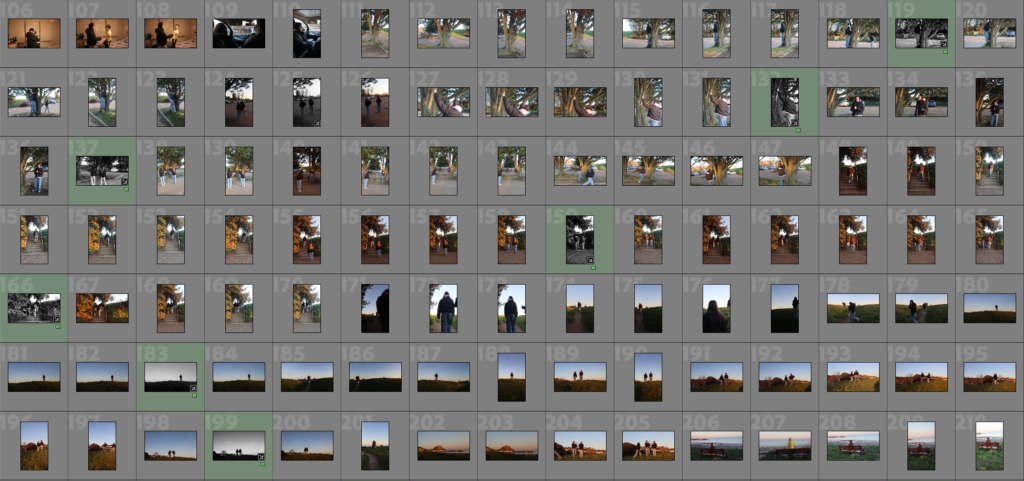
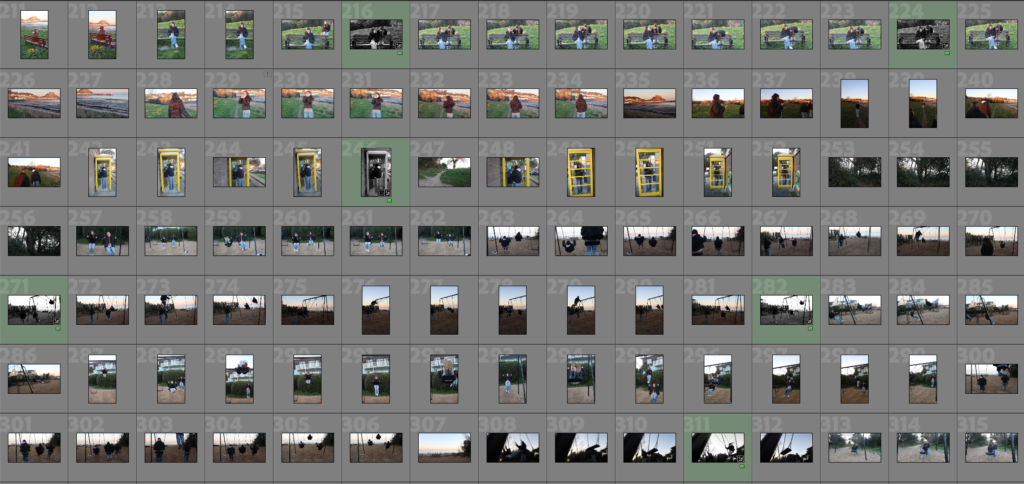
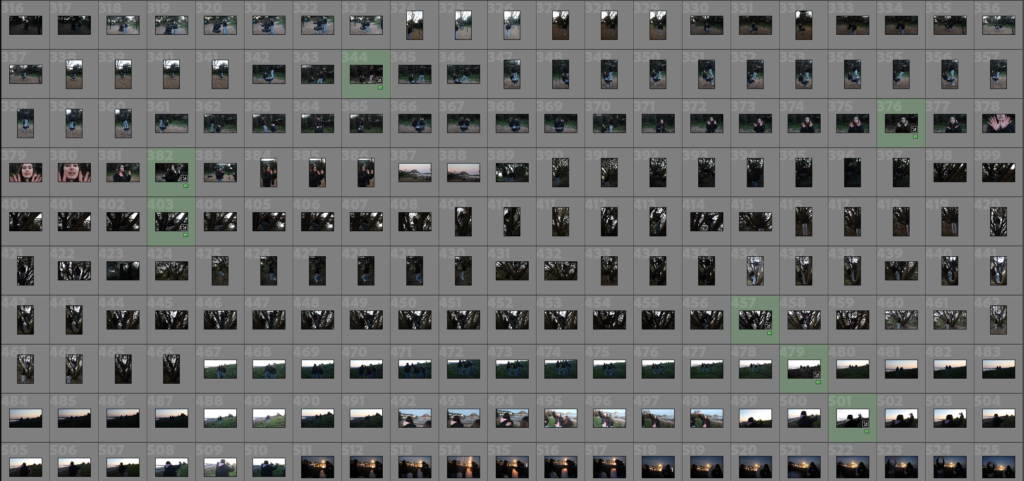

This is my third photoshoot for this project. In this shoot, I have focussed on capturing images of my friends, a group of teenage girls socialising. To take these images, I observed as we did the usual things we would do but I would exclude myself and take photographs. My goal was to take images of what was happening in front of me, making sure my friends could ignore the camera to ensure authentically aesthetic shots.
After looking over the final photographs, I decided to make the images black and white. I have now decided, after experimenting with the first few photoshoots, that my project will be presented with all of the images in black and white.
Some final images:
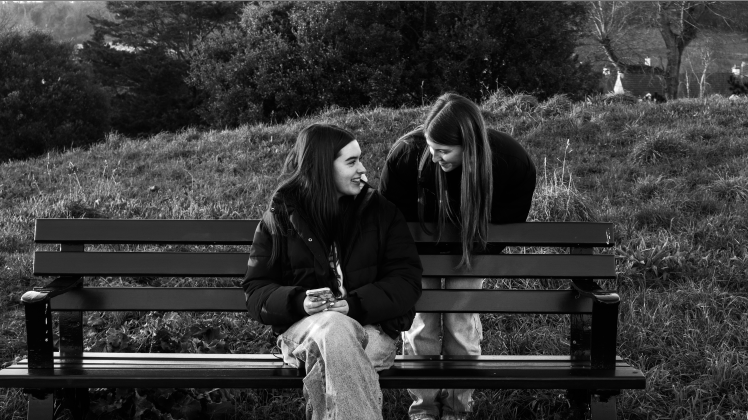
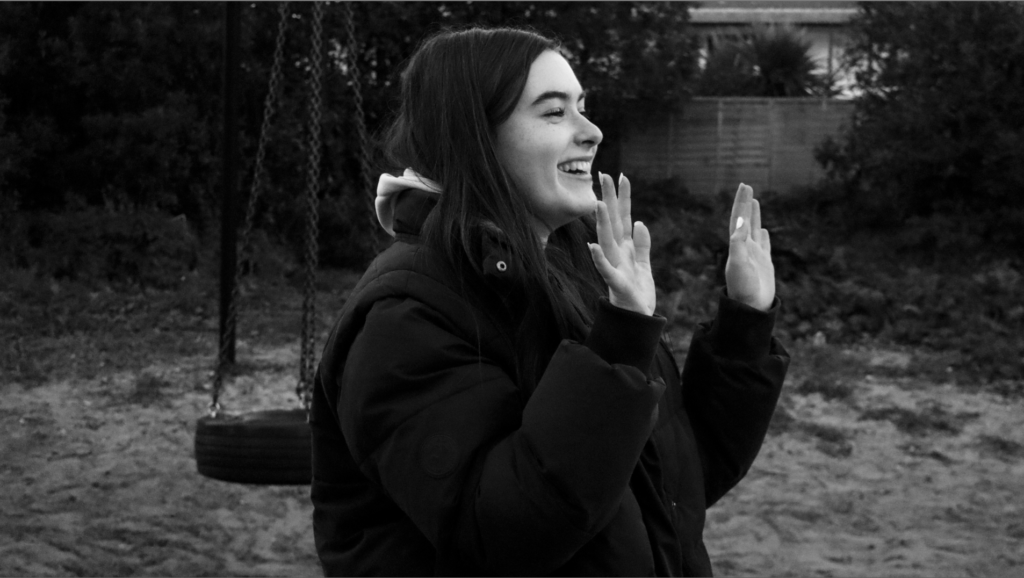
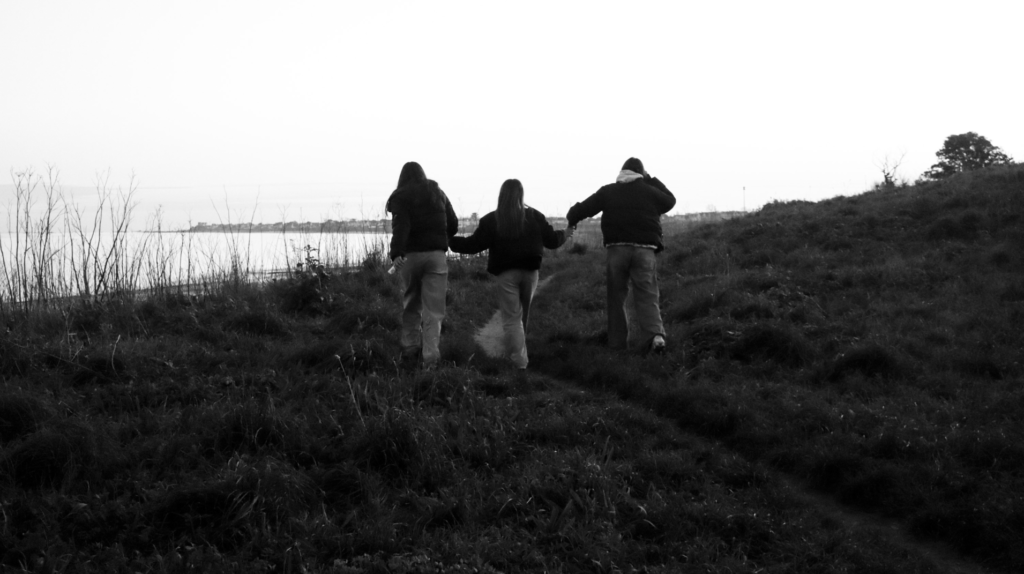
This third photoshoot is my best photoshoot for this project. The images I shot during this are good quality images, which portray the goal of these shoots perfectly well.
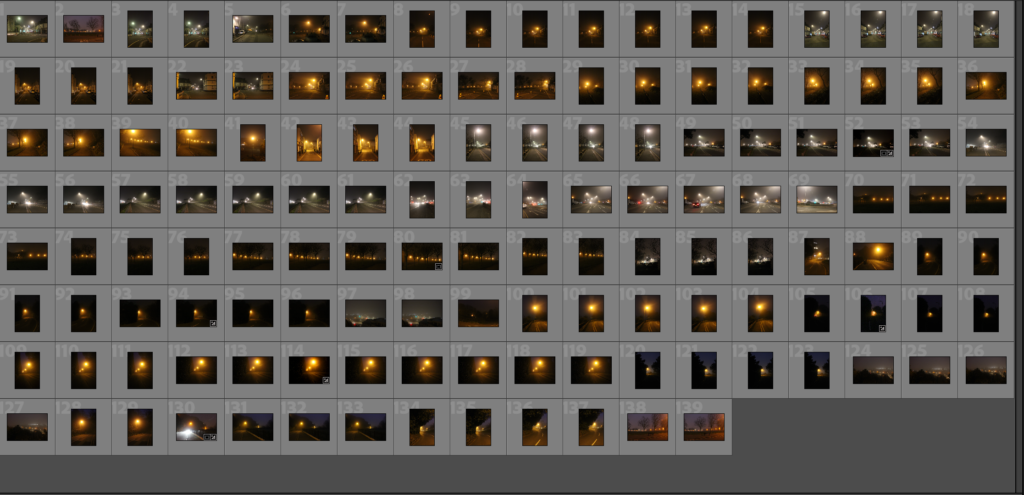
This was the initial contact sheet of every photo, for this photoshoot I went out in the early morning to capture the morning fog, as I want to explore how the mist/fog creates a dreamlike, unreal setting which alters the general landscape. When I went to capture this photoshoot, I had arrived at the originally planned location just as it was starting to become light outside, capturing the indistinct changes in how the location looked under the elegant smog. The morning fog not only dispersed the light, but also created this interesting beam effect around the lampposts within frame, making this the focal point in the majority of the images captured during this photoshoot. The beam of light poking through the fog added an unearthly quality to the setting, highlighting the sense of mystery and the transformation. The sense of loneliness is also found in this photoshoot, as I purposefully chose a time when few people would be out. the photographs show the empty, quiet landscapes with no signs of life which added to the feeling of abandonment and solitude, both being the emotional impacts I intended to showcase in my project. This photoshoot was shot handheld, using a high ISO to keep a faster shutter speed in the low light, I did this as a long shutter speed would often capture a moving car or people, taking away from the sense of solitude I was trying to convey. Even though using a high ISO meant that grain would be seen in my images, I find that the grain improves and highlights the overall mood I was intending for. The slight grain found within the images compliments the foggy, dreamlike sense of the morning as well as the contrast between the warm light and the cool fog. Overall I took 139 photographs during this photoshoot.
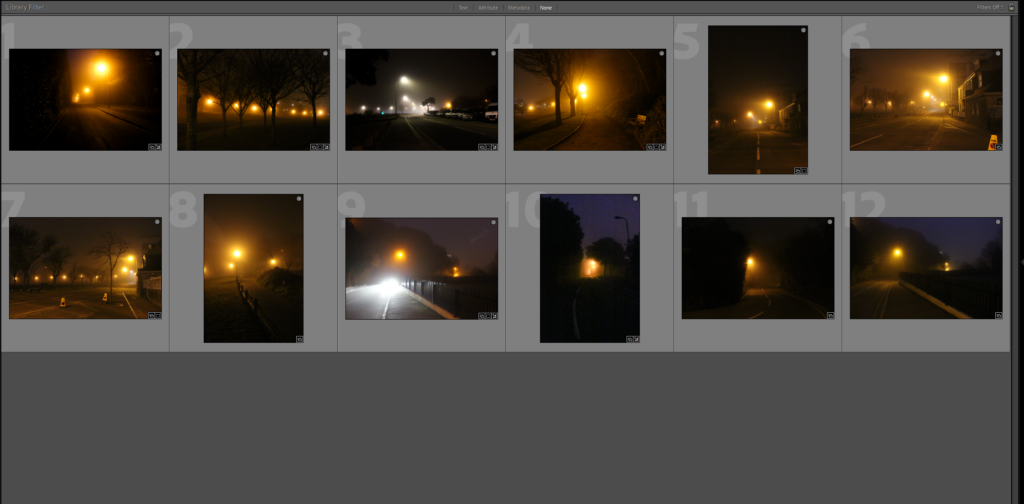
From the 139 photographs I captured during this early morning photoshoot, I selected 13 final images which I find best fits and showcases the themes and mood I am aiming for with this project. The process I went through to select these images, required me to review each image and focus on the ones that caught the interplay of light, setting and the feeling of loneliness I am aiming to acquire. I chose the photographs which highlighted the misty, unreal quality of the fog, the beam coming from the lampposts and the quietness which reflect the sense of isolation. These final images I have chosen show the emotional value and mood I hope to send throughout my photobook.
Final Image Selection – Unedited
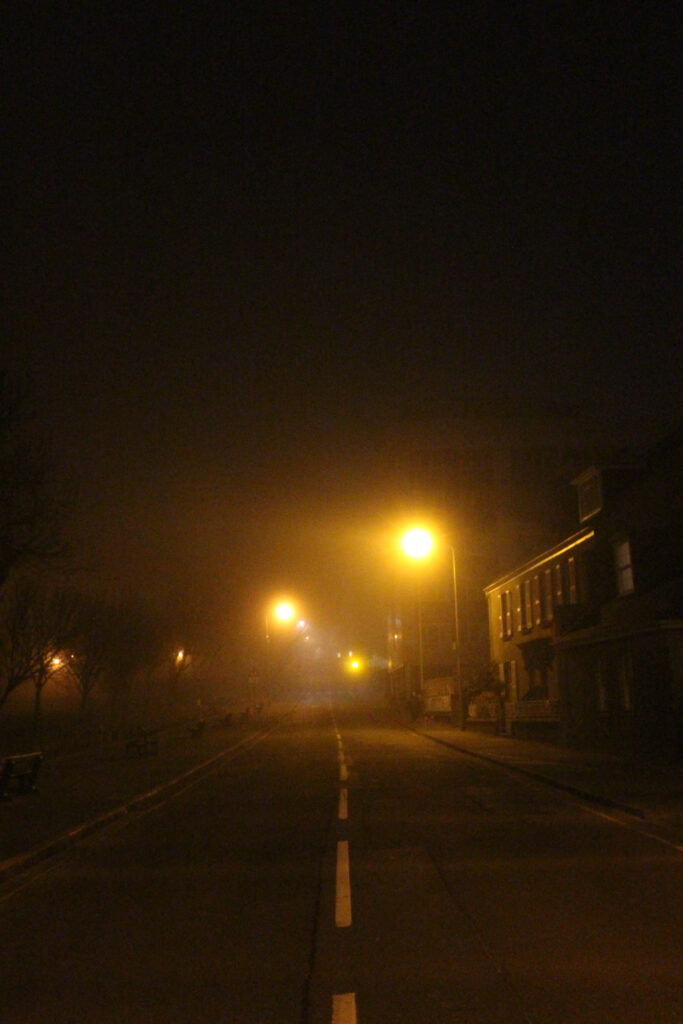
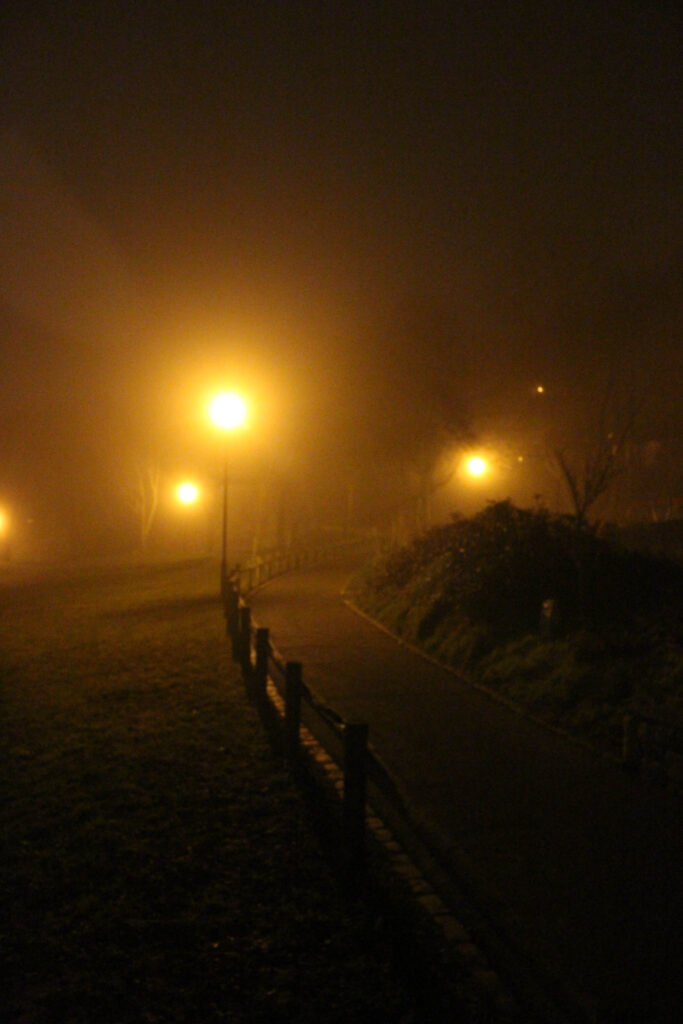
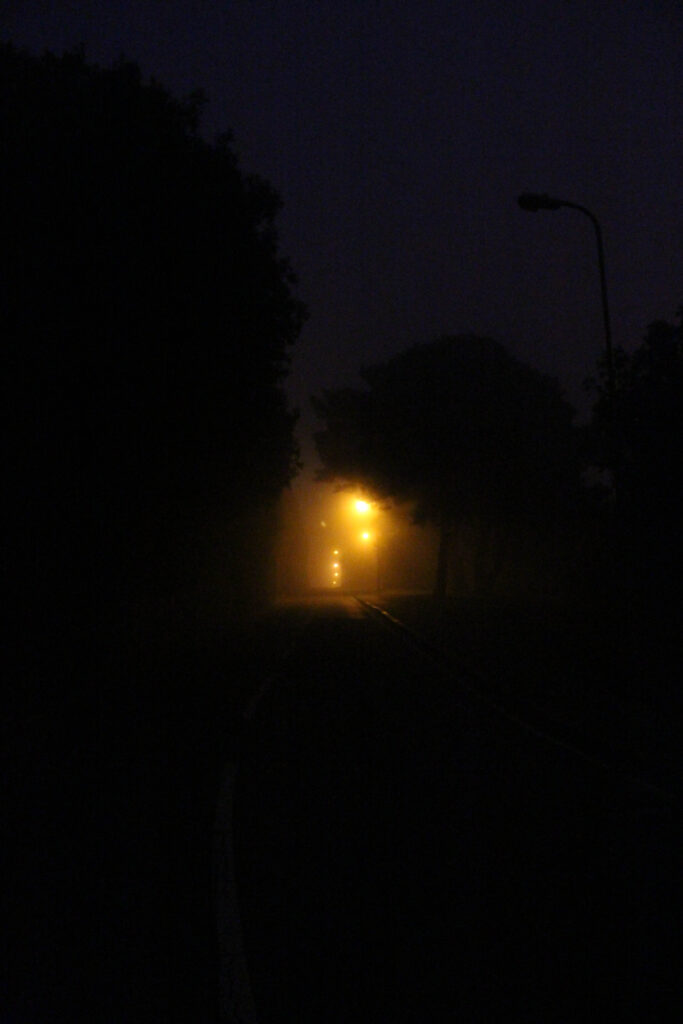
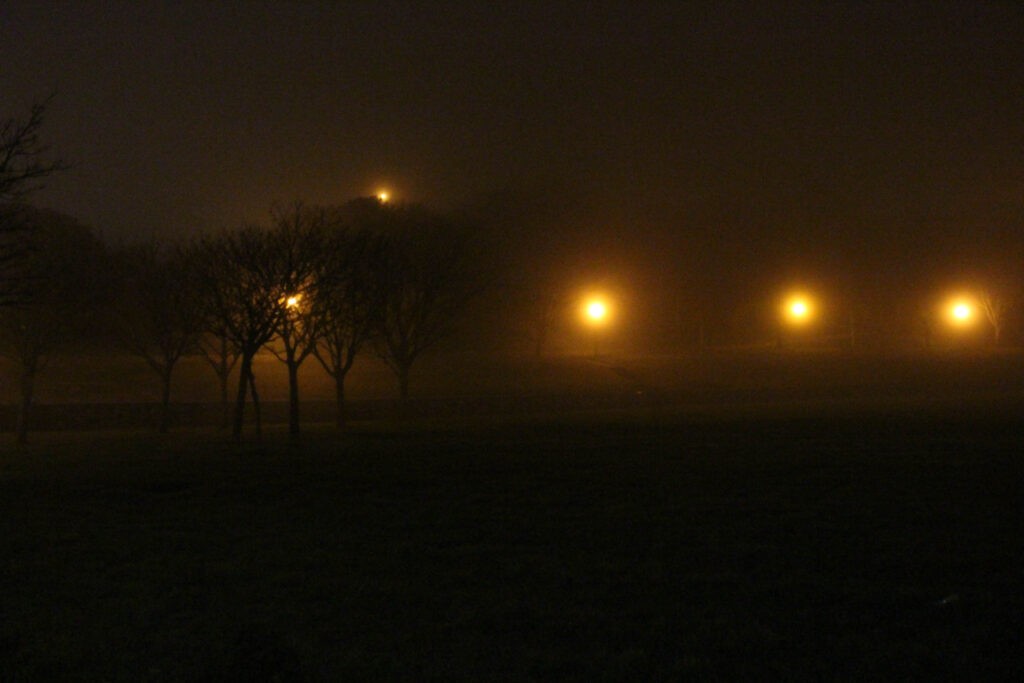
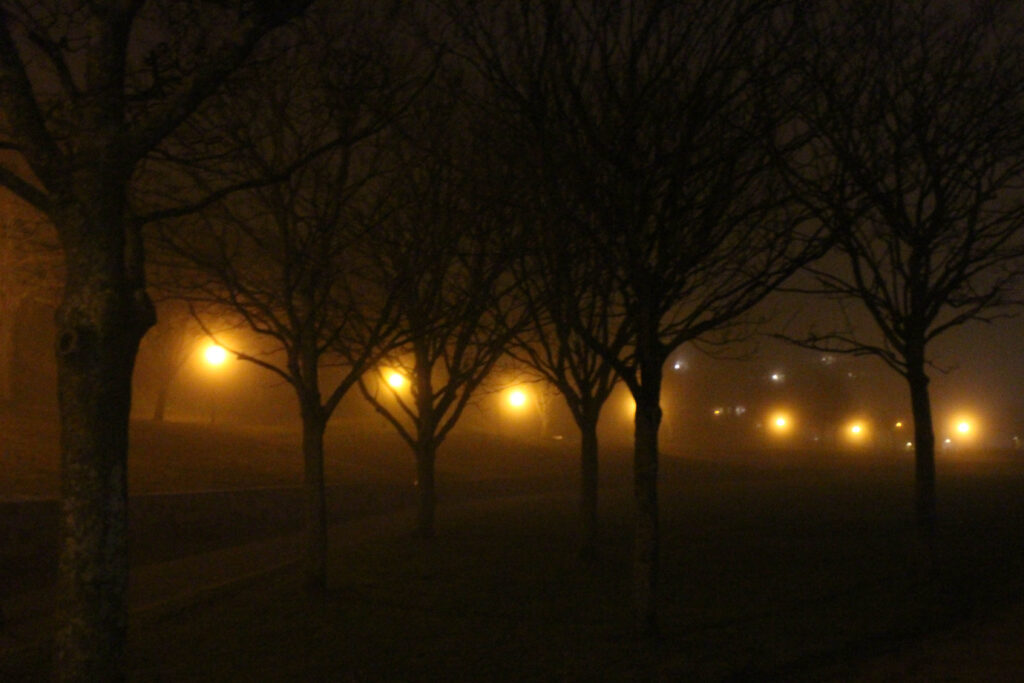
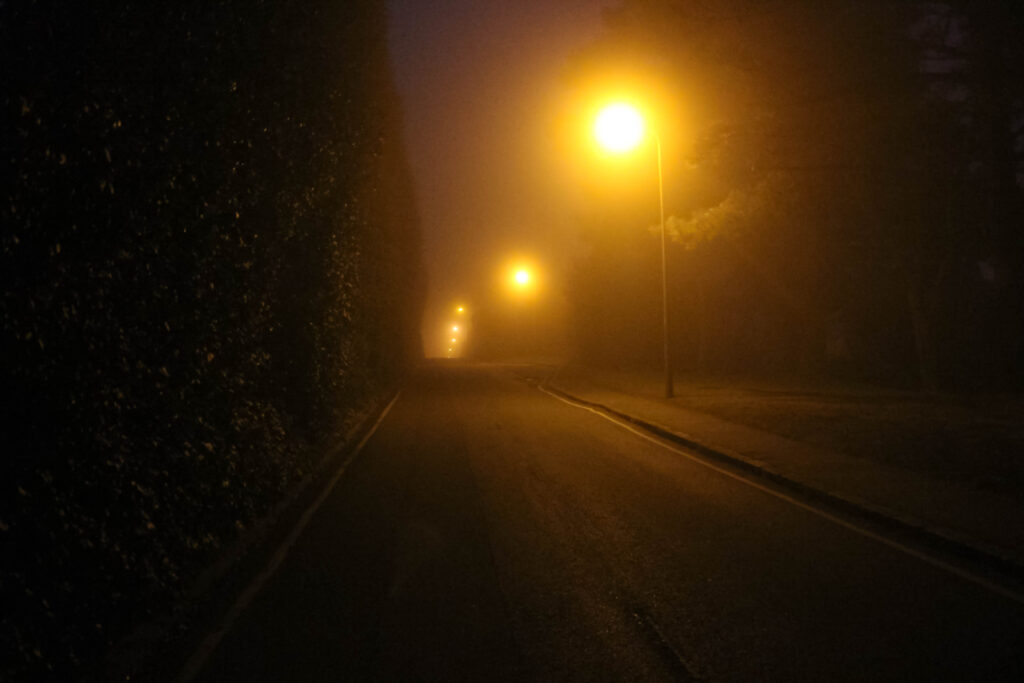
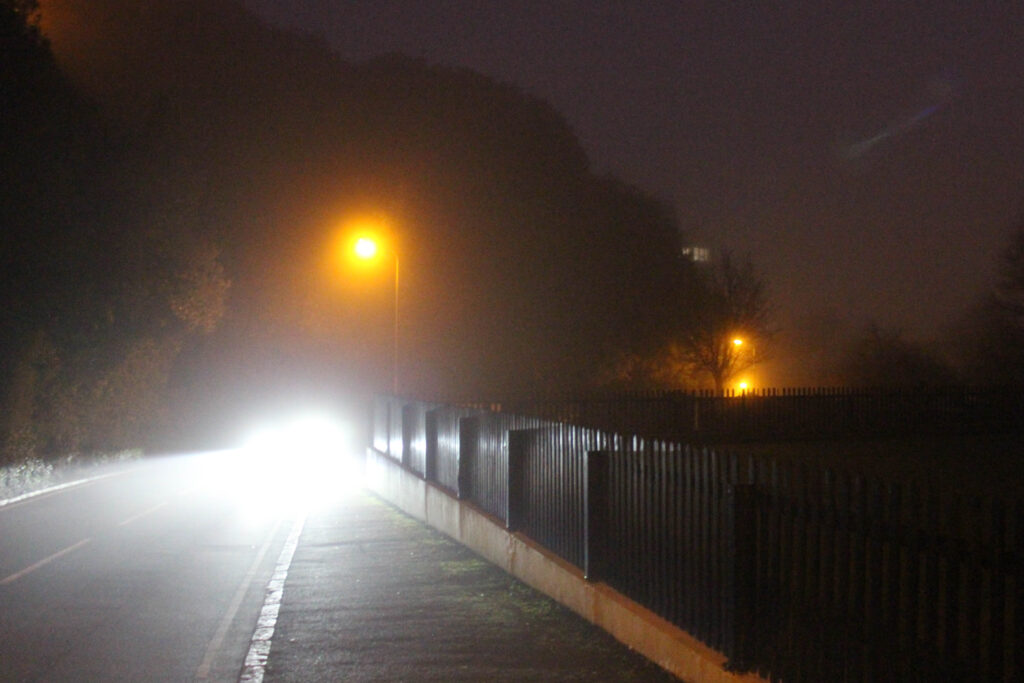
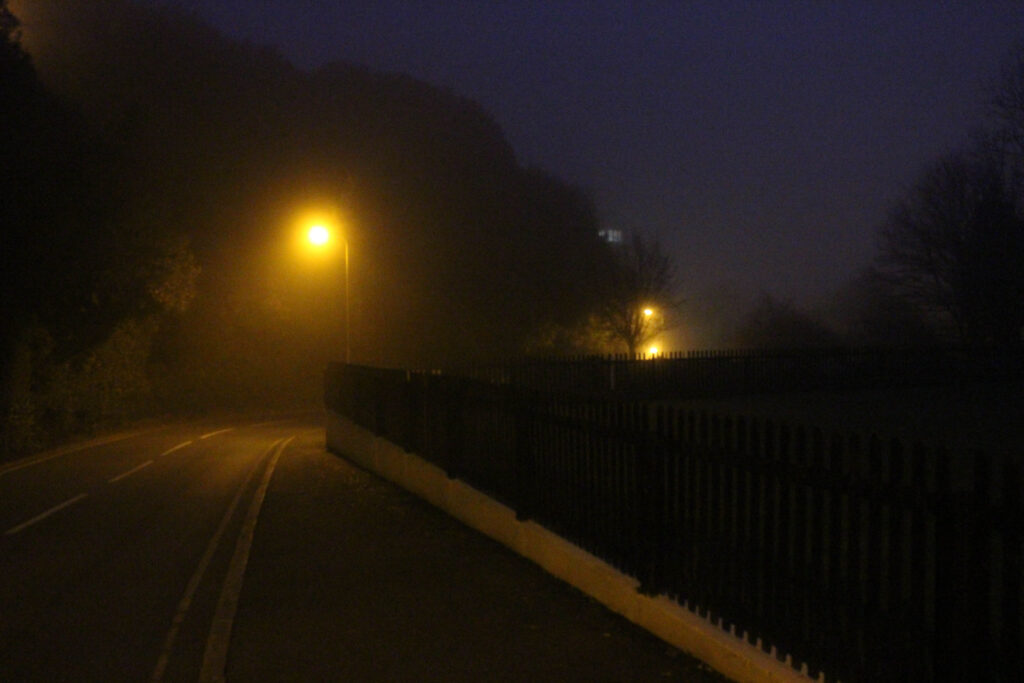

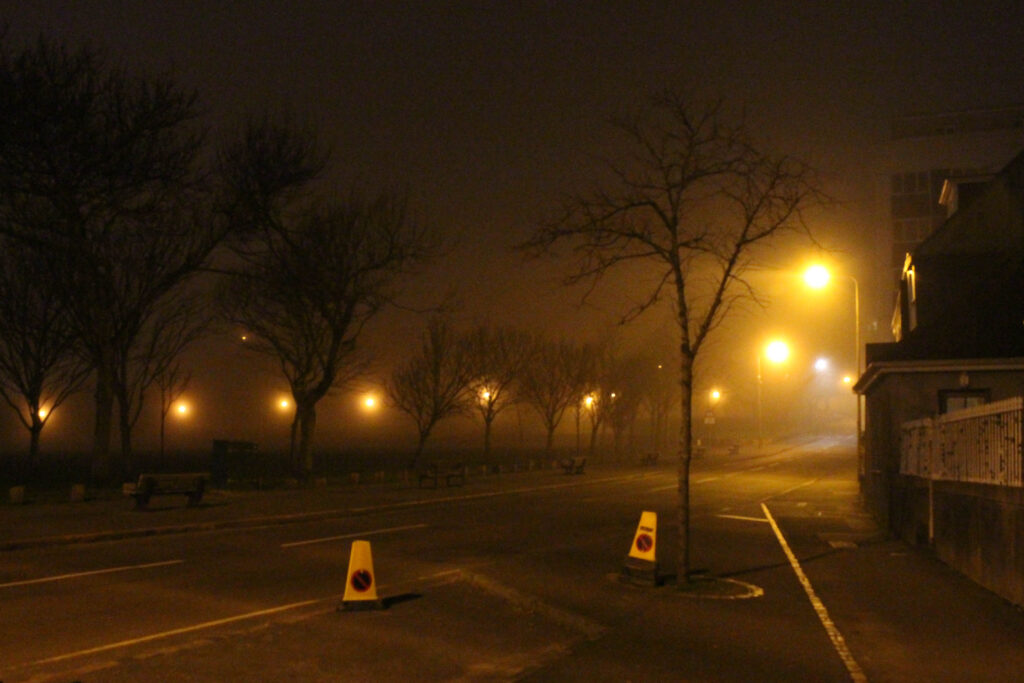
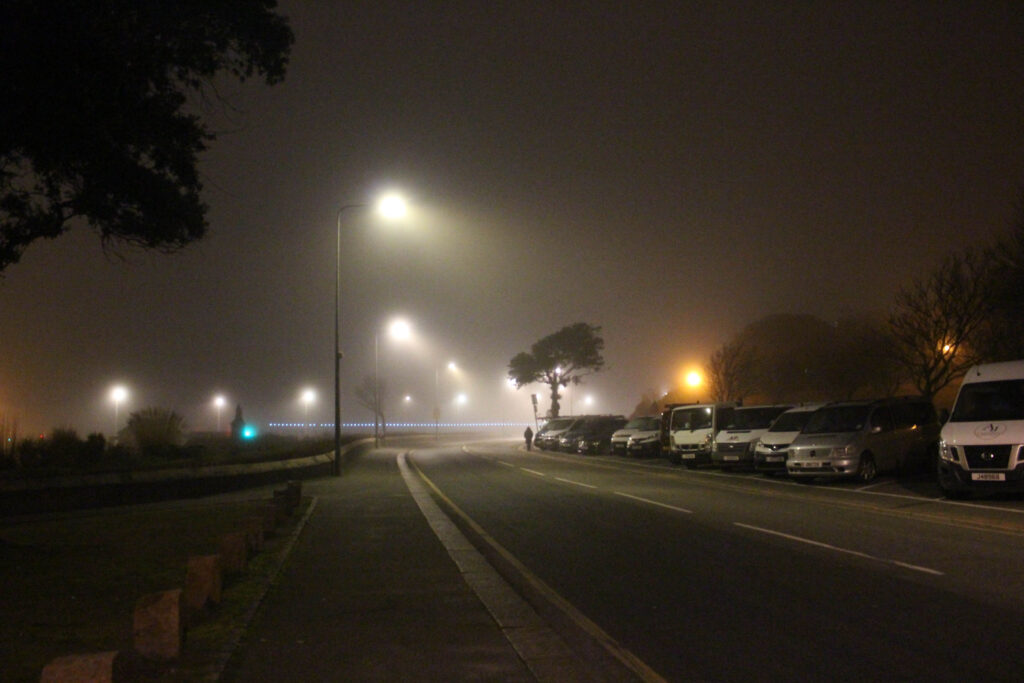
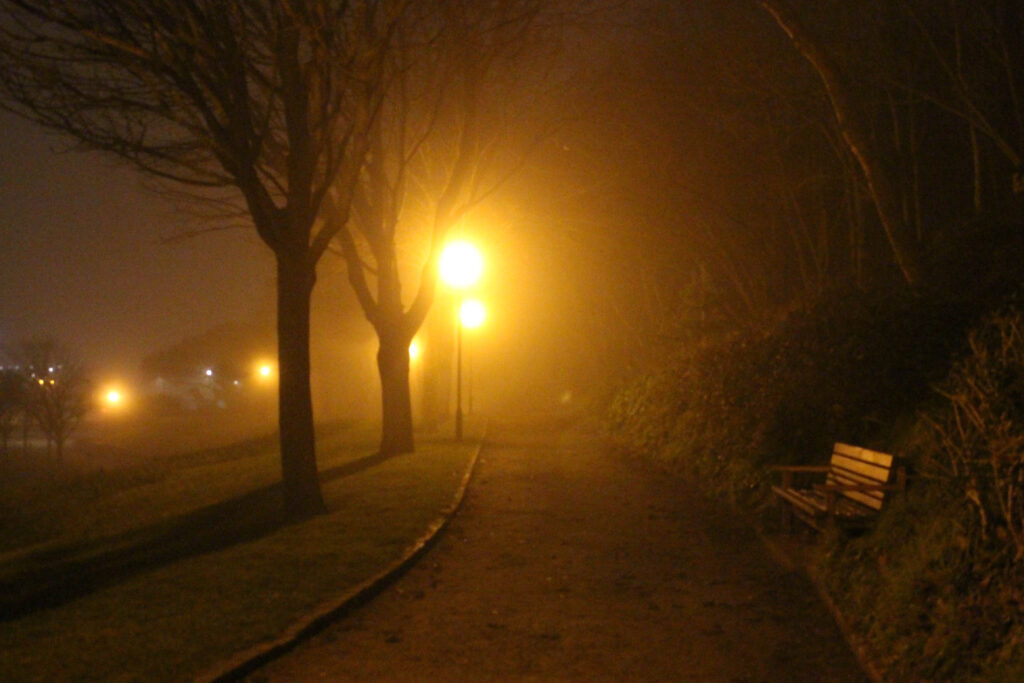
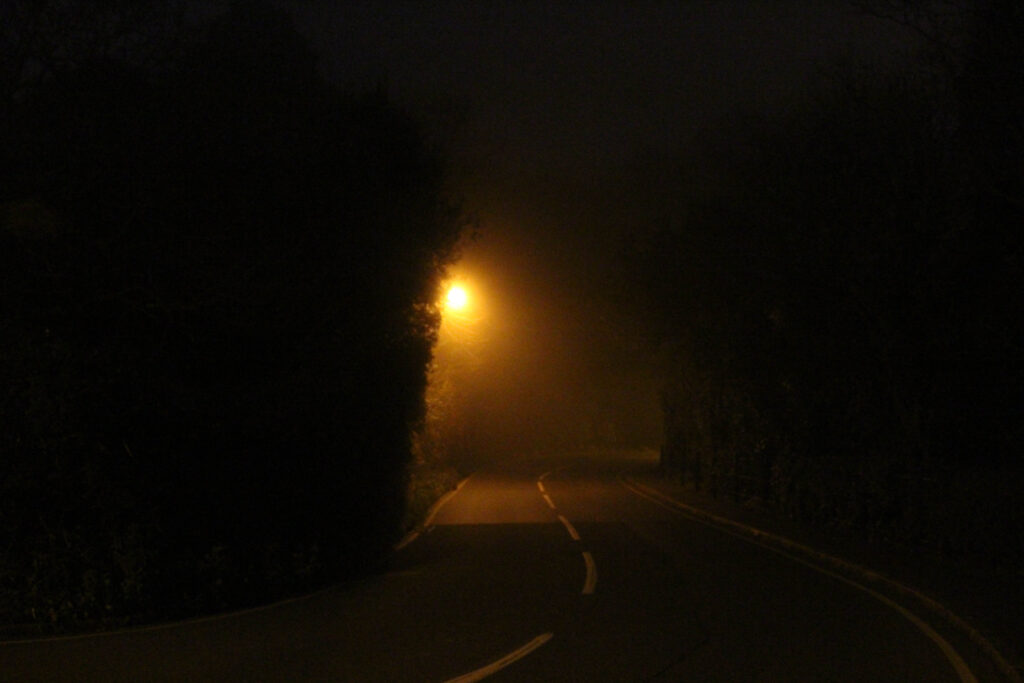
These images showcased above are the 13 final photos in their raw, unedited state. These raw photographs show the contrasts, textures and the overall mood created by the darkness and the cloudy mist. Even though the photos already show off the emptiness, loneliness and the surreal, dreamlike effect that I intended on, the next task i will do is subtle editing to these images, improving the tones, changing the exposure and just perfect the overall mood of the collection of photographs. Editing these images will ensure that they fit in with the overall theme/story of my photobook.
Final Image Selection – Edited
Once the 13 images were carefully chosen, I started editing them in order to enhance the overall mood and theme I am aiming for. My main target when editing was to highlight and show off the dreamlike qualities of the foggy morning whilst also improving the theme/mood of isolation. By altering the contrasts and highlights, I managed to find the perfect balance between the warm lamppost lights and the soft tones of the fog. Whilst editing I also brought out some miniscule details which might have gone unnoticed. These photographs below are the final, fully edited images for this photoshoot.
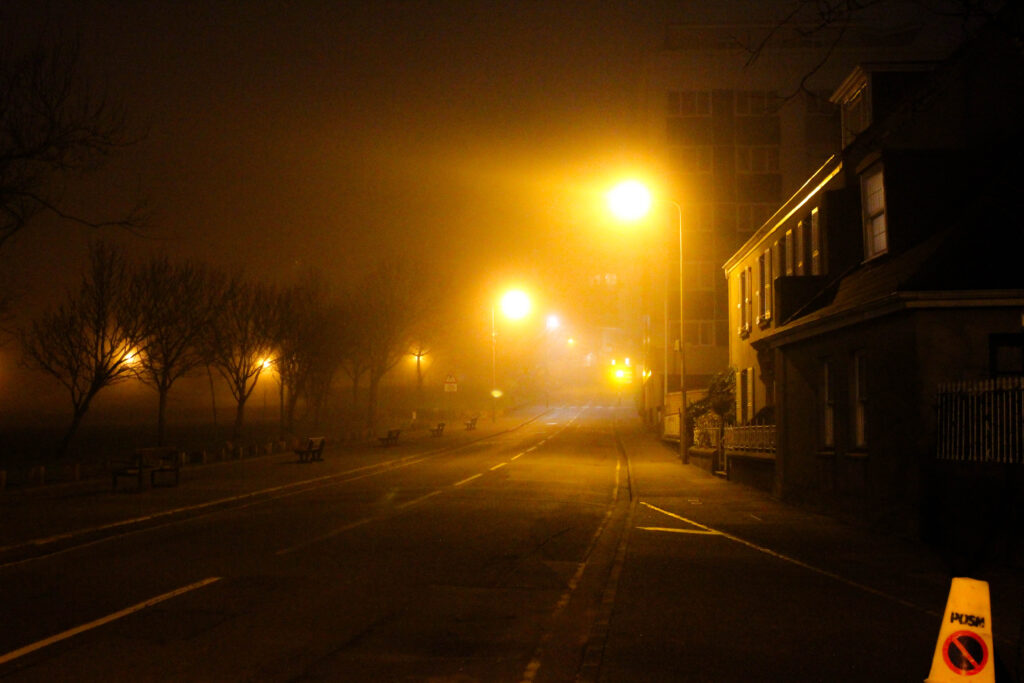
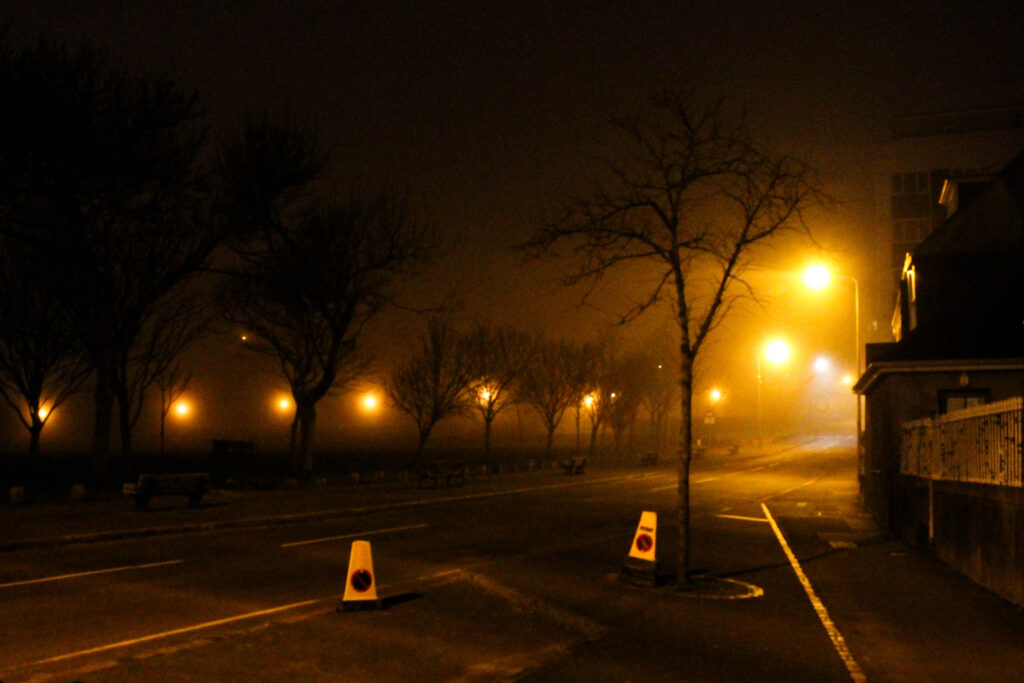
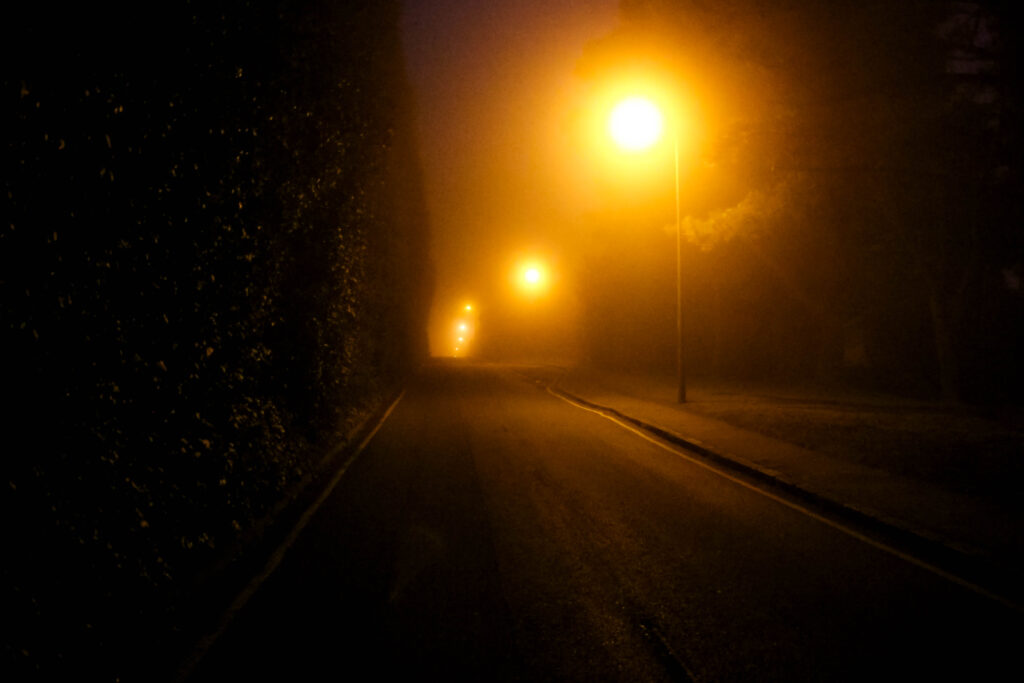
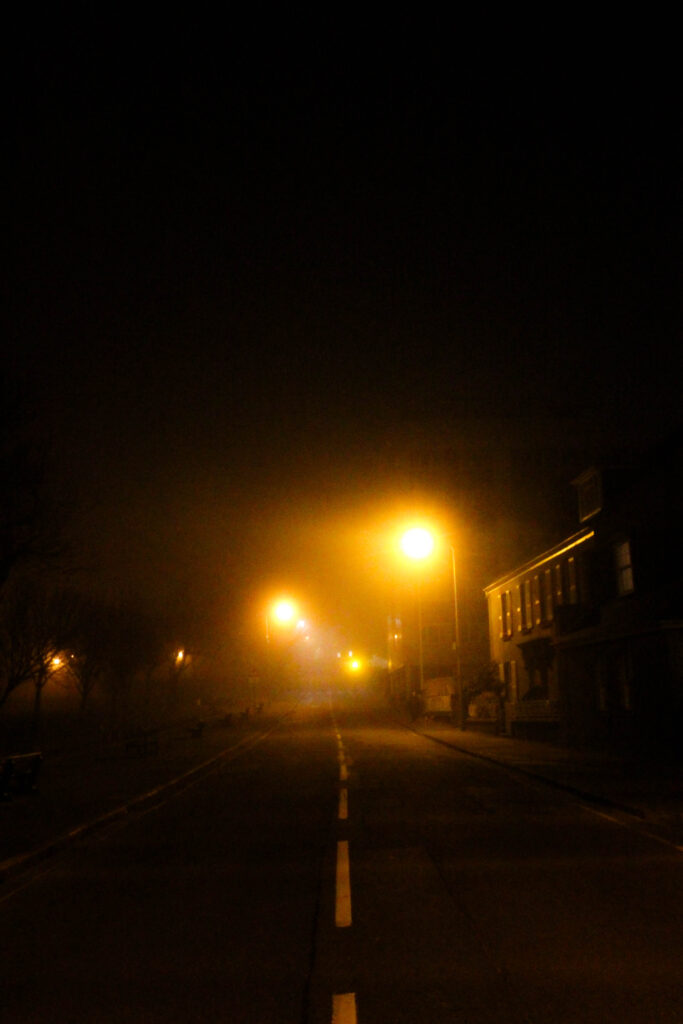
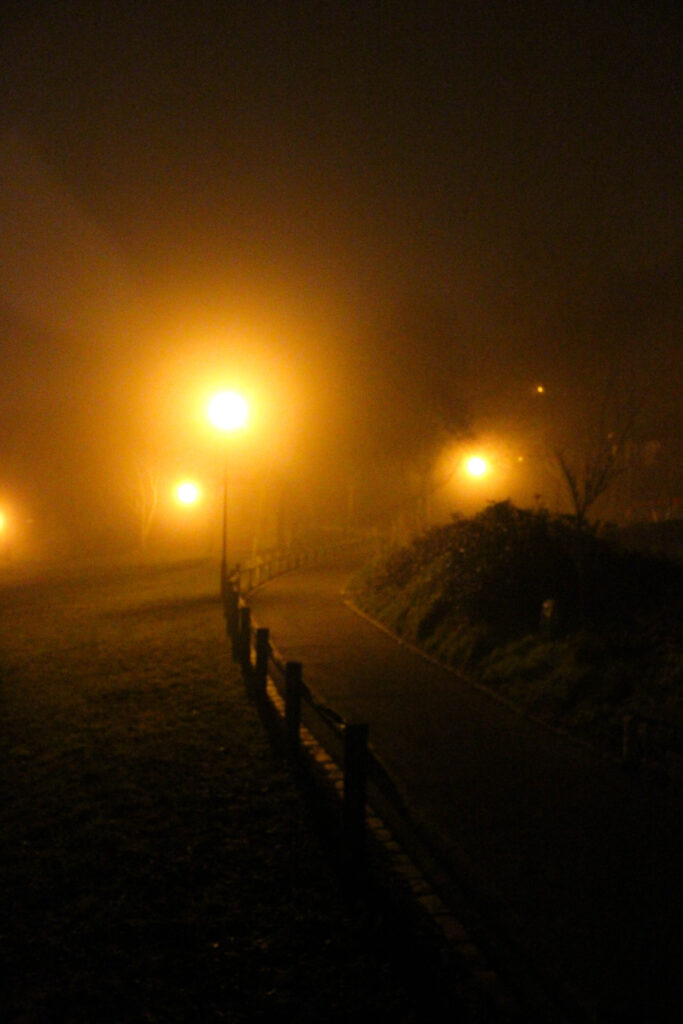
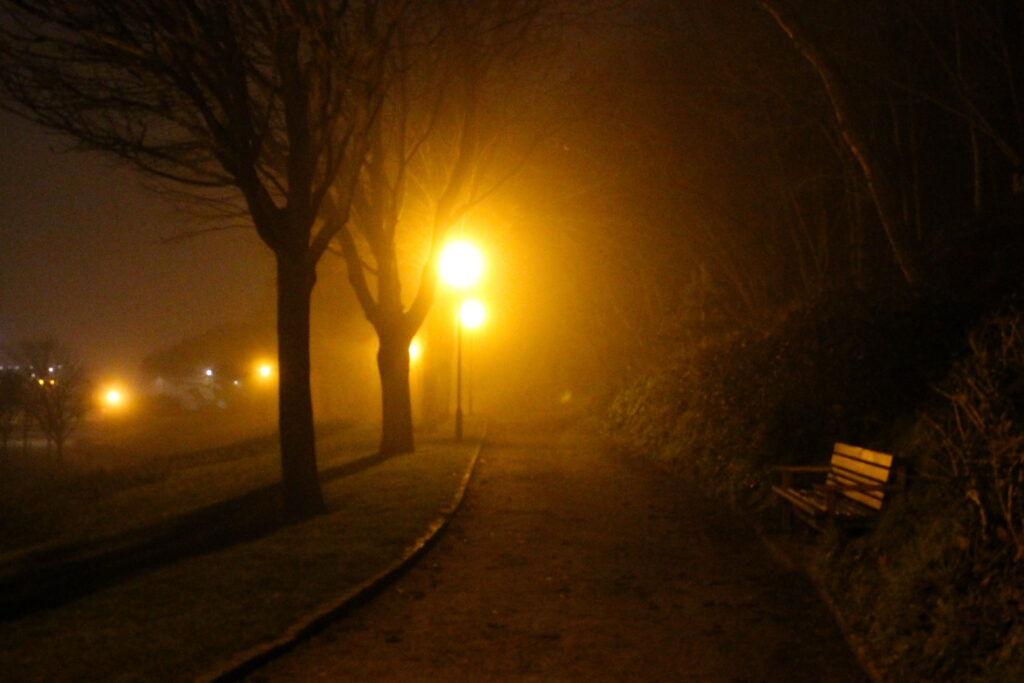
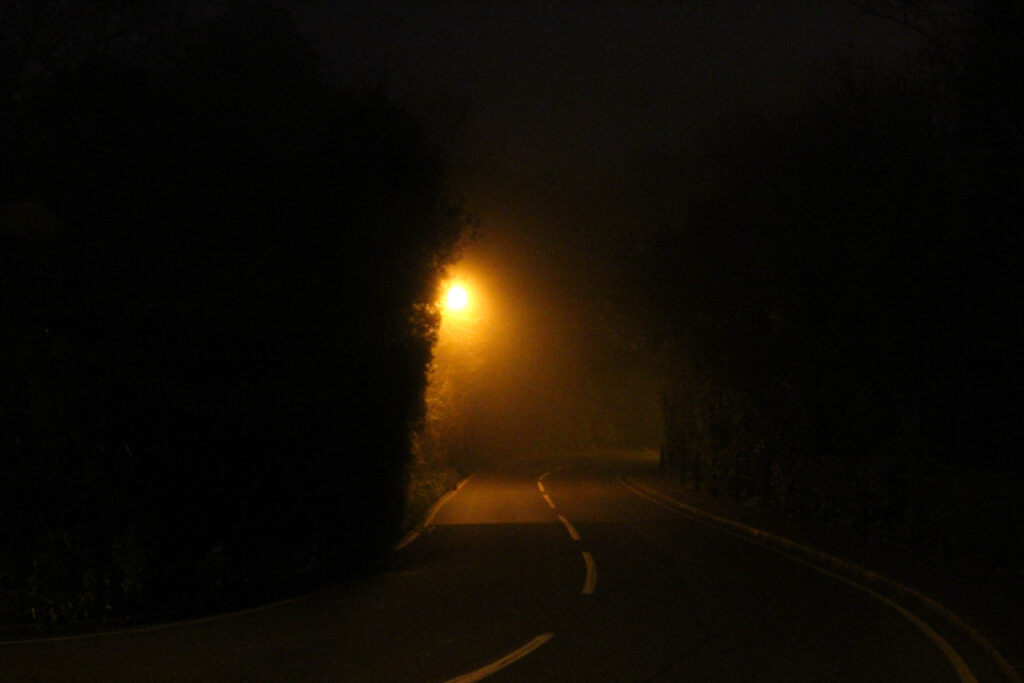
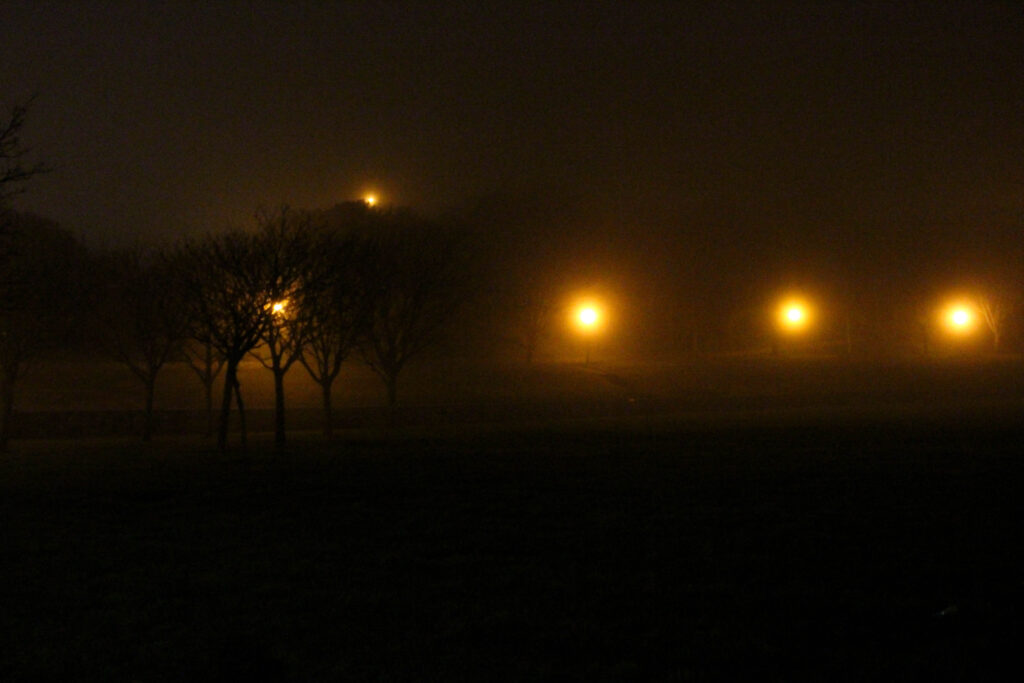
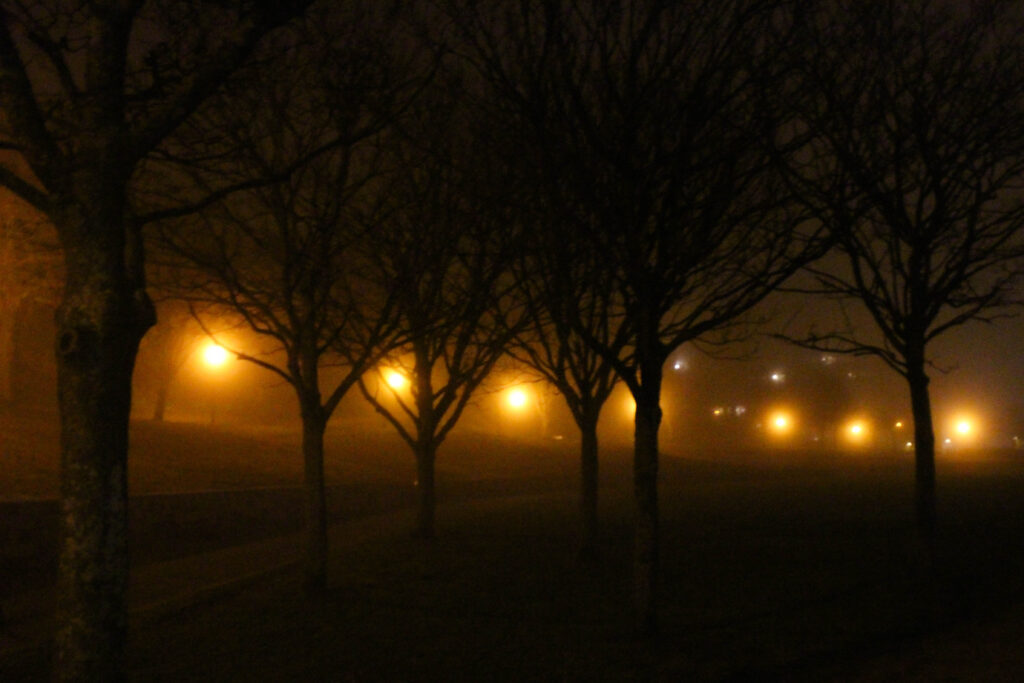
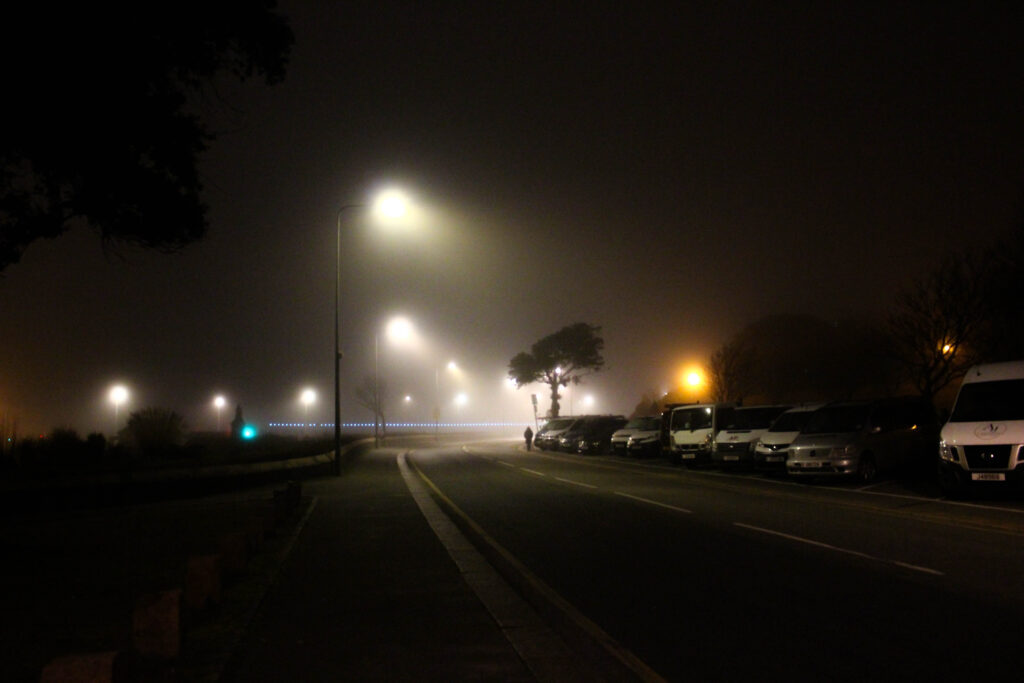
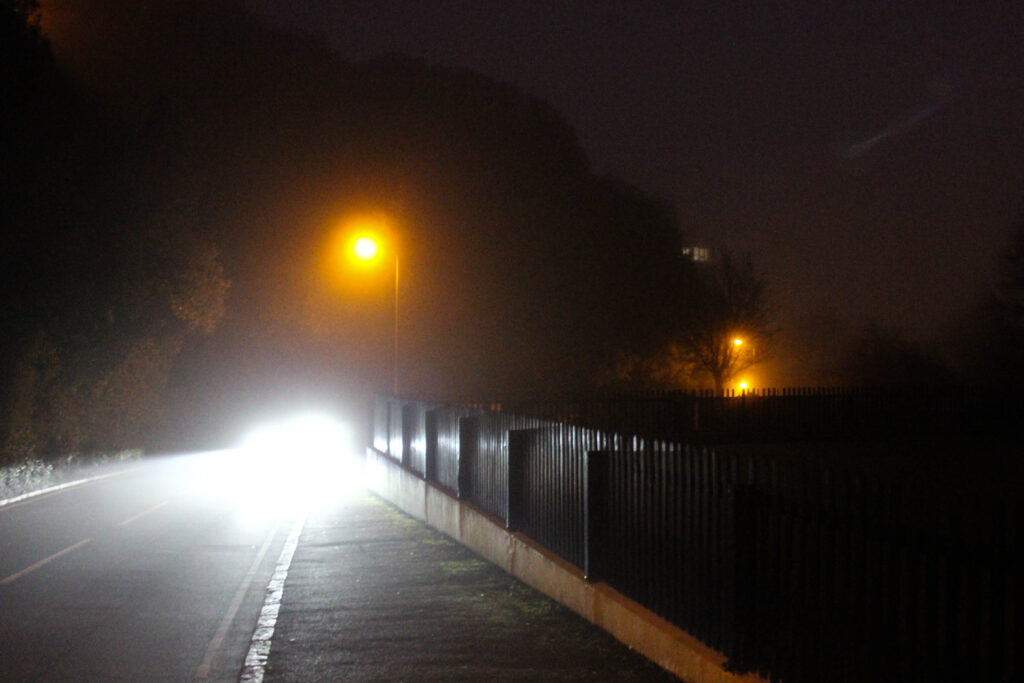
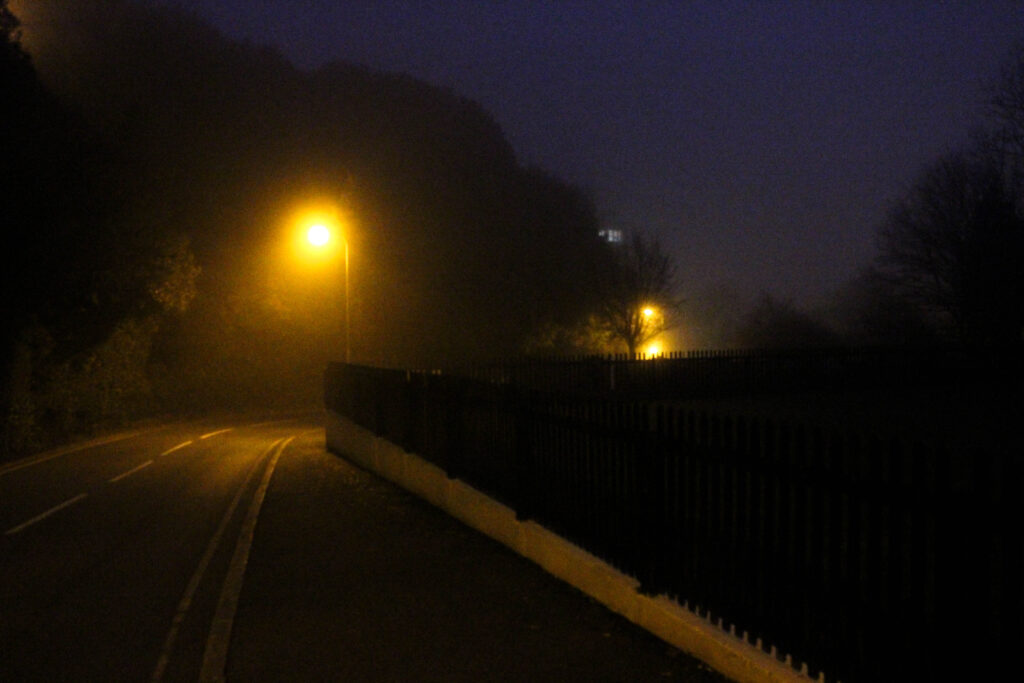
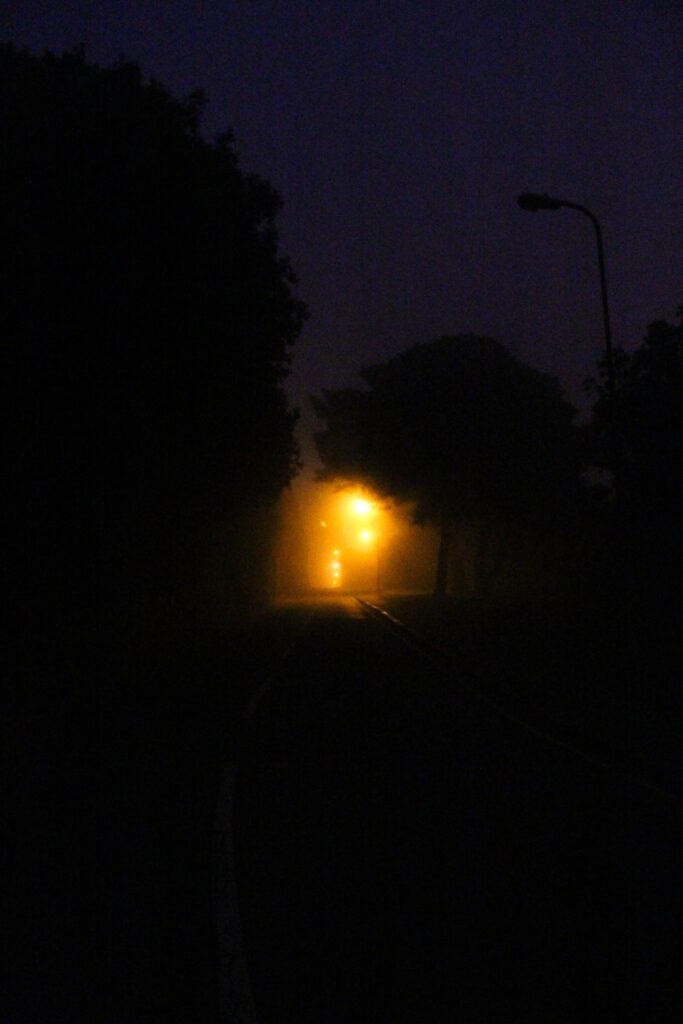
Final Image Selection – Before & After
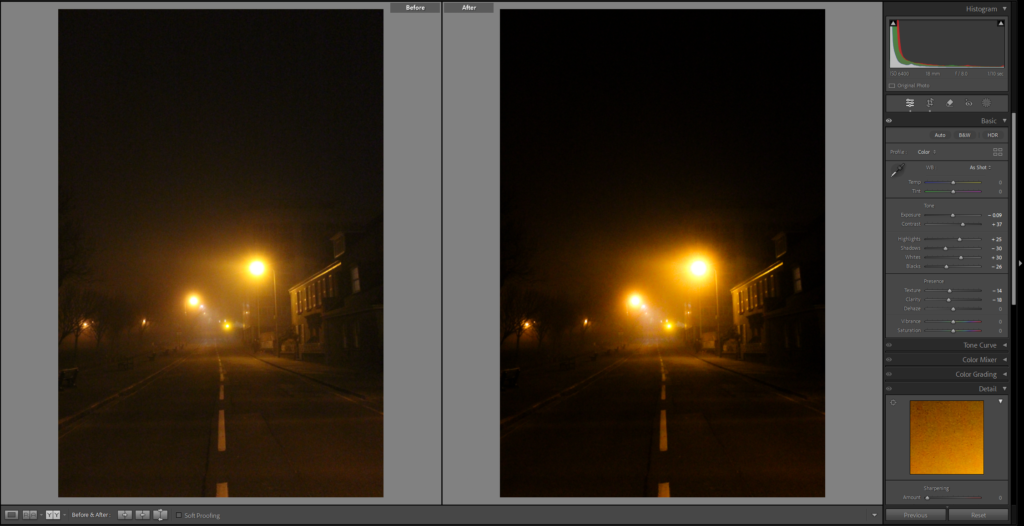
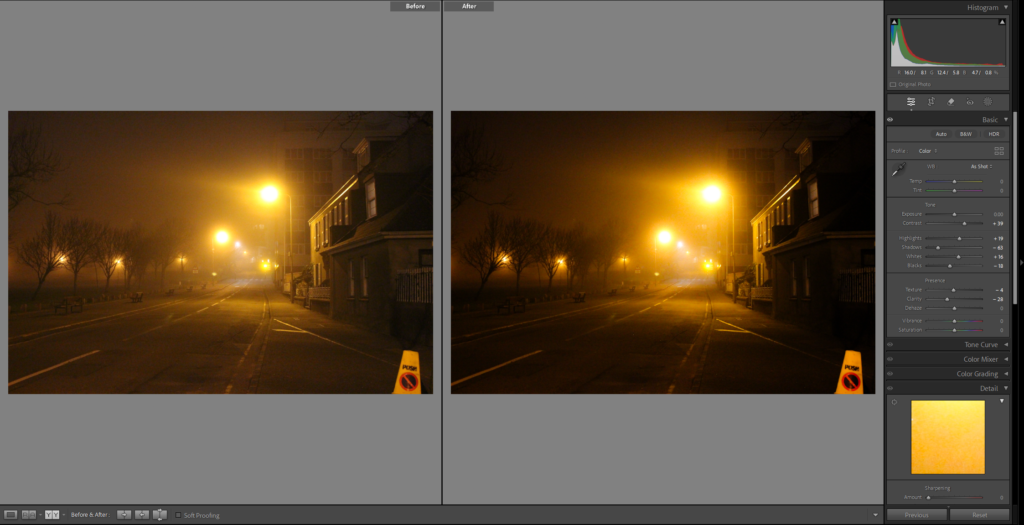
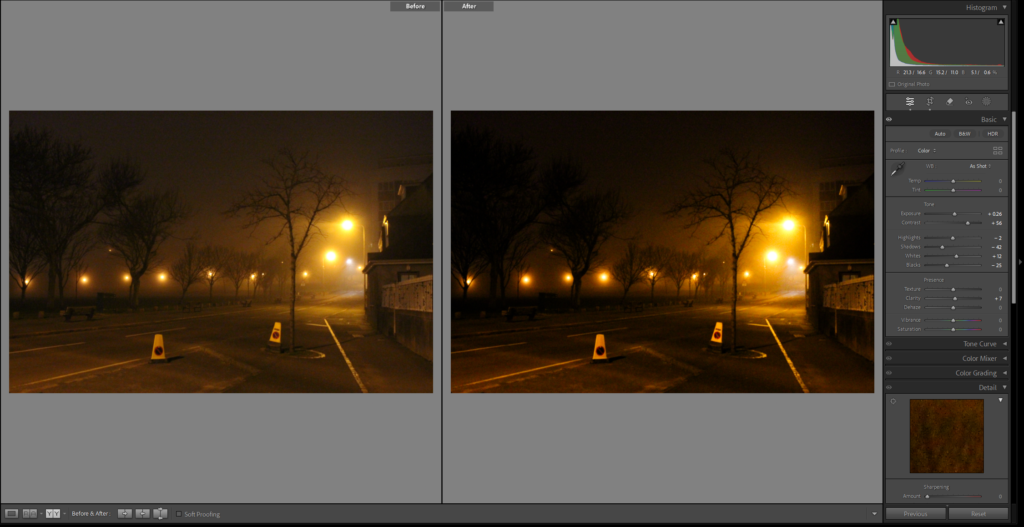
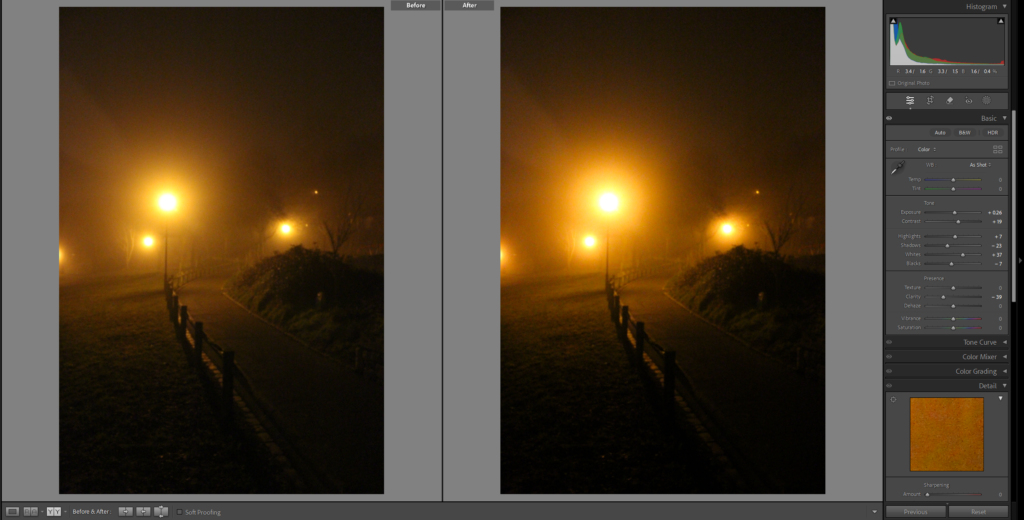
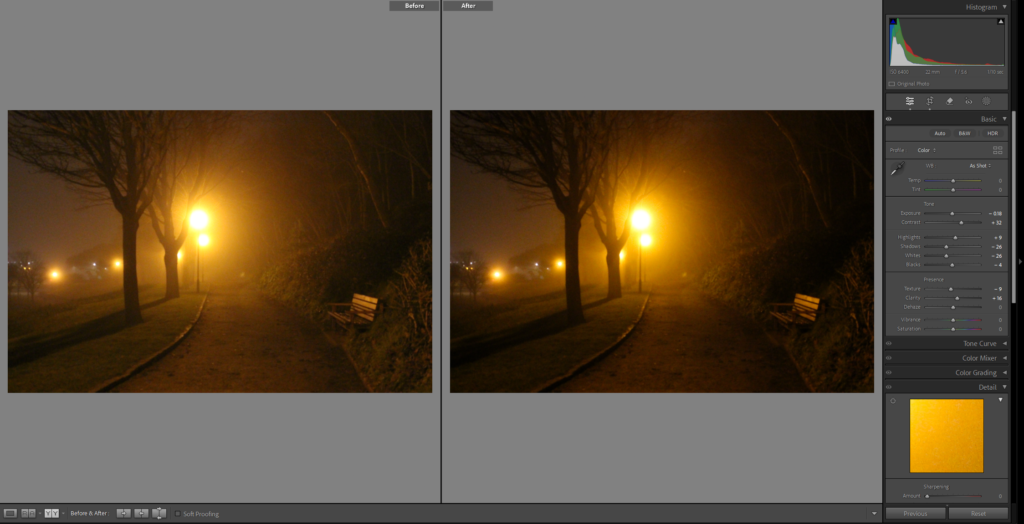
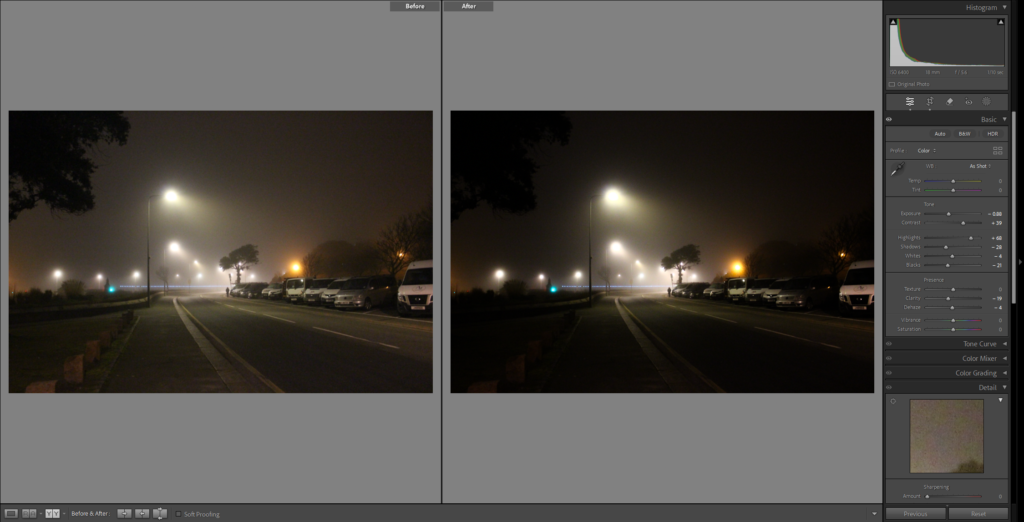

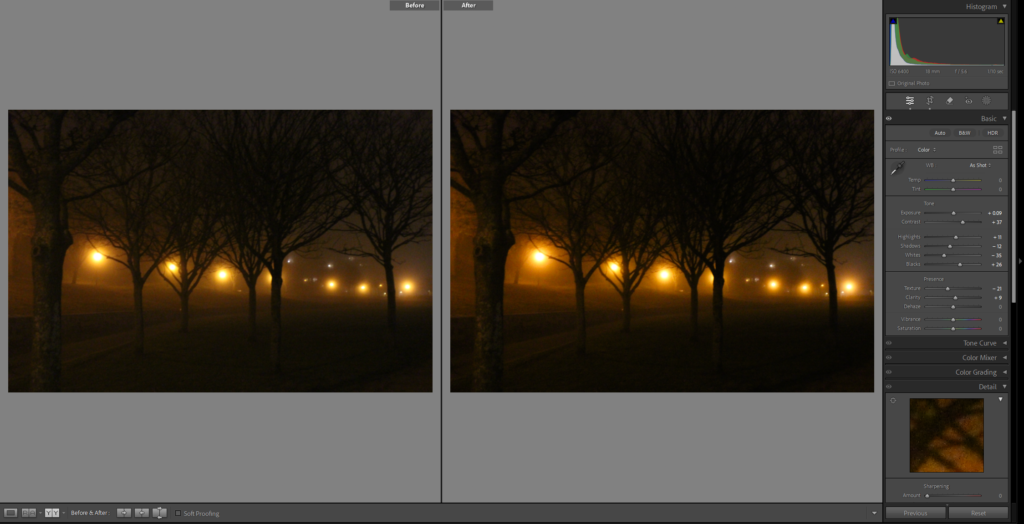
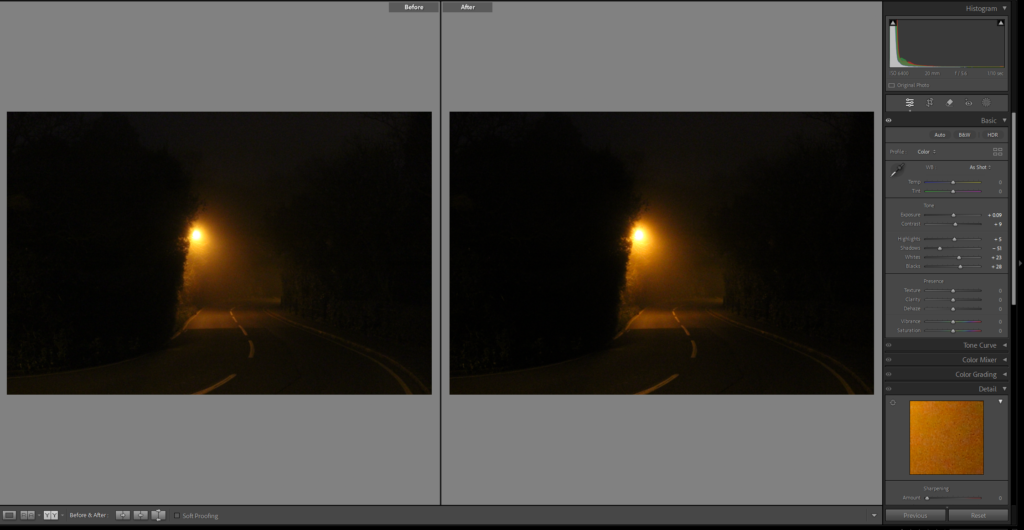
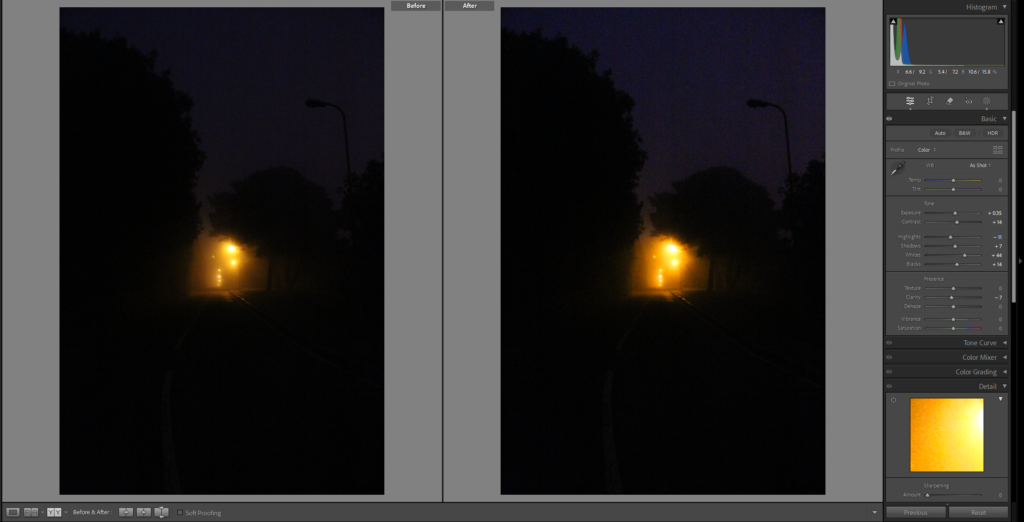
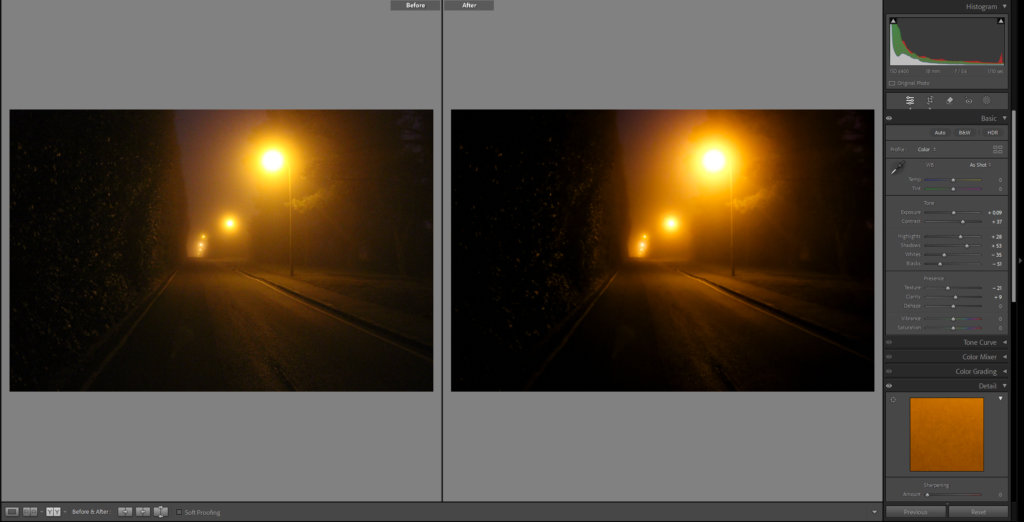
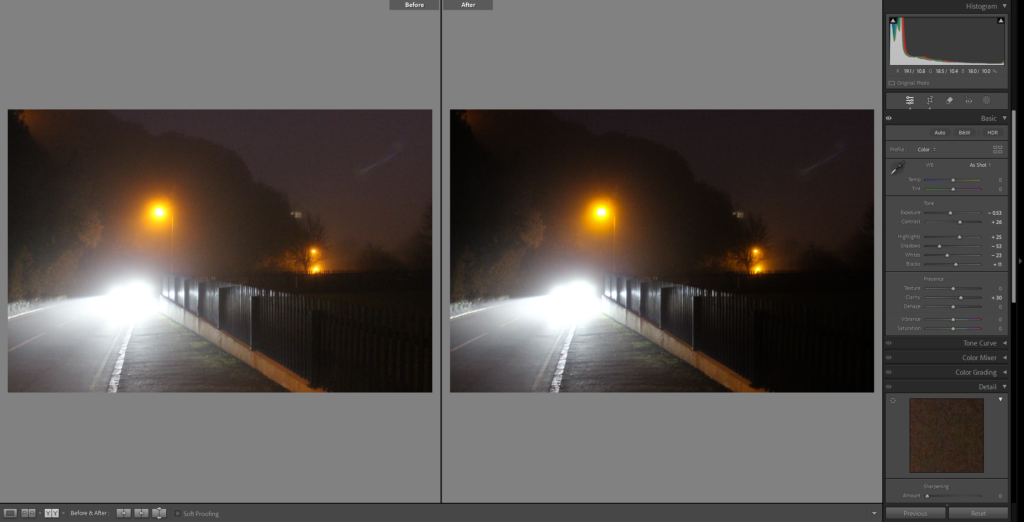
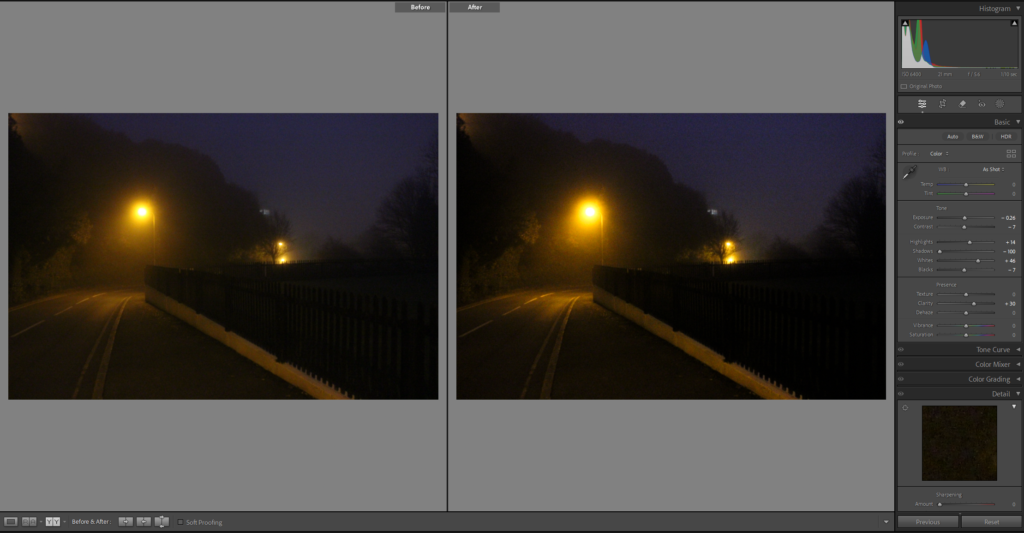
As You can see for these images, I only did subtle adjustments to them. My goal when editing was not to dramatically change the raw photos, but to slightly improve them and to refine the overall mood of the images. Every edit had a high focus on perfecting the contrast, highlights and tweaking the shadows and whites, with most of the photographs, I increased the contrast to emphasize the quality of the fog. The purpose of altering the whites, blacks and shadows to bring out smaller details which were hidden behind darker areas. Overall, my choices when editing were done to keep the natural sense of the foggy night whilst also intensifying the feeling of solitude that the images show.
Favourite photographs from this photoshoot
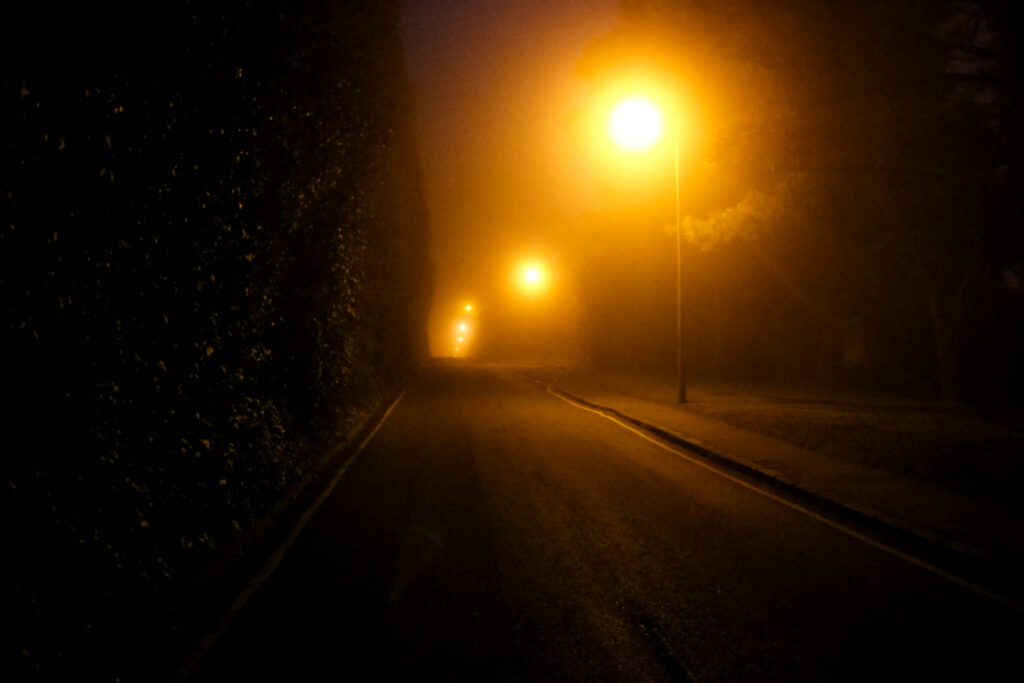
This image shows a long, desolate road being lit up by a warm glow from a row lampposts. The contrast between the left of the image being dark and the right side of the image having an intense amount of light, draws the viewers attention towards and through the road and pavement, almost like leading them into the unknown. My favourite aspect of this image is how it captures the sense of solitude, the empty road in this frame could suggest abandonment, however the working lamposts give an idea of life, fitting perfectly with my theme. This photo will be a main piece inside my photobook, as it clearly portrays the mysterious, lonely mood outlining the dichotomy between the day and the night.
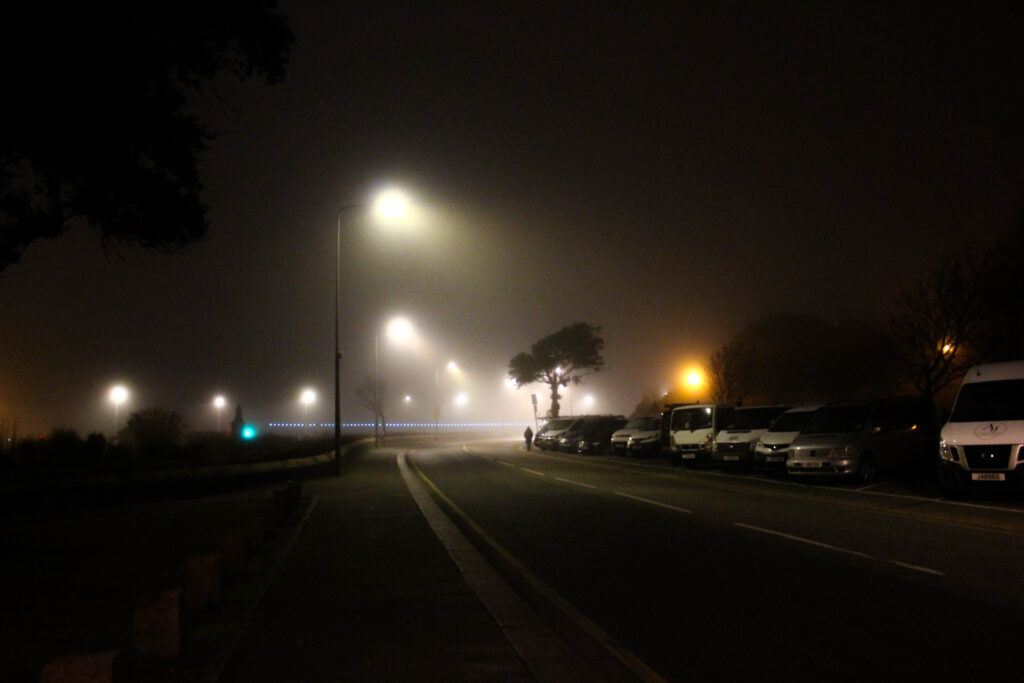
This photograph displays an urban landscape filled with mist, allowing the lampposts to scatter freely. The soft light turns into a warm glow which is complimented by the mist surrounding the lampposts, the leading lines on the road and the lights slowly fading into the distance, it entices the viewer to follow the path into the unknown, similarly to my other favourite image. In my opinion this image is the definition of the normal becoming abnormal, the emptiness of the urban setting mixed with the glow of the artificial lighting, creates a quiet narrative of walking through a place which feels both safe and uncomfortable at the same time. This photograph will also play a key role in my photobook as it reflects my theme clearly, showing how landscapes during the night become abnormal.
Pictures From Home – Larry Sultan – Deconstructed and Explained
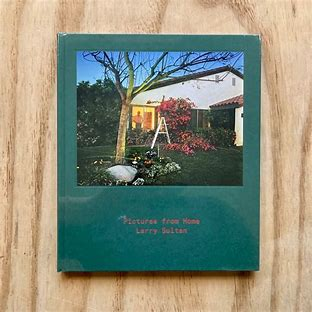
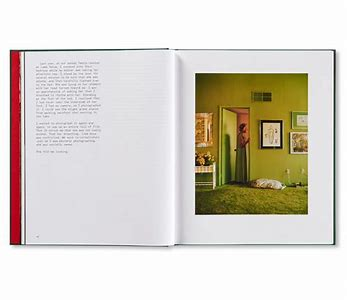
Pictures from Home – Larry Sultan
Published in 1992 this book was an interesting combination of memories and current day scenes. An insight into an American lifestyle, originally based around the families political views however it became a passion project of sorts looking at how he saw his family, how his family saw themselves. Sultan himself said ‘I wanted to puncture this mythology of the family and to show what happens when we are driven by images of success. And I was willing to use my family to prove a point.’ Woven into the book are old family photos and stills from home videos. The current photos he took are of his parents enjoying their ‘American dream’ retired living how they would like to.
Why?
Sultan produced this photobook to show an American dream. -The “American Dream” is a phrase referring to a purported national ethos of the United States: that every person has the freedom and opportunity to succeed and attain a better life- the one of his parents and how they chose to live it, when retired. Sultan started the project with the idea of explaining politics or at least exploring his parents conservative views. However over the ten year production period it became focused on his family, old photos and videos. A desperate attempt to stop time in it’s place, capturing details forgotten over a day and details forgotten over years. It was received as such, with phrases like ‘One of the most incredible things about Pictures from Home is how vulnerable Sultan allows himself to be in the text, in which he confronts insecurities about himself and his work, brilliantly deconstructing the project and the challenges of making it.‘ and ‘Larry Sultan’s images and words were his reconciliation with the oedipal mess of the American Dream.‘ and ‘one of the most moving and indelible family portraits I’ve ever read‘. The book, moved people, a relatable attempt to store memories and explain ones life. It is an intense family portrait sublimated with snippets of conversation, tension and love, flaws and all is featured within this book.
Larry Sultan
Larry Sultan a widely known photographer. Having grown up in California this quickly became the main inspiration source for many of his projects. He has published books and photographs, combining documentary and staged photos to create his desired effect of heavy, psychological photos, depicting family life and everything around it. His most known project is ‘Pictures from Home’ published in 1992 having spent a decade creating and capturing photos and recordings. Sultan went onto create more photos and photo books all mainly in the same California setting, never straying to far from home.
How Sultan took the photos
Sultan took these photos by visiting his parents every few months armed with his camera gear. Spending a few days executing ideas while recording notes and conversations, completely confusing his parents. This was reflected upon within the book, in which his parents voiced their confusion and almost annoyance for the project, not understanding the purpose. One shot in particular had Sultan sneaking in while his mother was asleep and taking photos. This describes his approach to photography well, he uses the concept literally, trying to stop time in moments others might not notice and would be forgotten about.
The Book Itself
The book has a slightly rough feel, with a textured hardback cover and a smooth added photo onto both sides of the cover adding a preview into the book itself. There is indented text, the title in small on the cover and spine, simply stating the title and photographer. Within the book the photos themselves have been printed onto two types of paper, thick glossy photopaper for the bulk of the photos. But for the old family photos and video stills they are printed onto softer, non-glossy paper. A mixture of colour and black and white have been used, the black and white being old family photos taken in black and white originally. Sizing is important when it comes to producing books, as this one has many orientations of photos the book is 23x27cm a size similar to a4 but squarer. This allows different photos to fit while keeping the book portrait. Overall the book has 192 pages with 140 of these being black and white. The cover itself is a hardcover with a photo stuck placed in the upper half, giving the appearance it was stuck on, like a family photo album would have on the cover. The title is on the cover, ‘pictures from home’ a literal title describing the book. The story was originally based upon political views before switching to a documentation of a retired couple living their ‘American Dream’ and how the photographer is related, his views and relationship with the subjects, his parents. He tells the story through a series of documentary and posed photos of his parents in their home and enjoying their lives. Often using a deadpan approach. There is no specific layout, using double pages or full spreads for some and putting multiple photos on the next page. Creating an interesting, relatable, unpredictable family dynamic. Each photo is carefully selecting, relating to the text beside it or following on from the previous section of photos, by editing the photos in a, true to life, colour scheme. Using the bright, bold colours to keep a theme throughout the book, reminiscent of the time period in which the book was created. It appears Sultan has done the book in chronological order of his parents day, slotting in shots and conversations when it added to that part of the story.